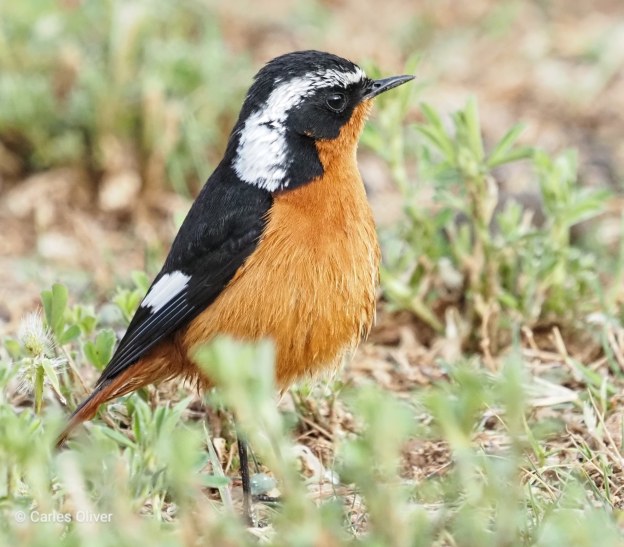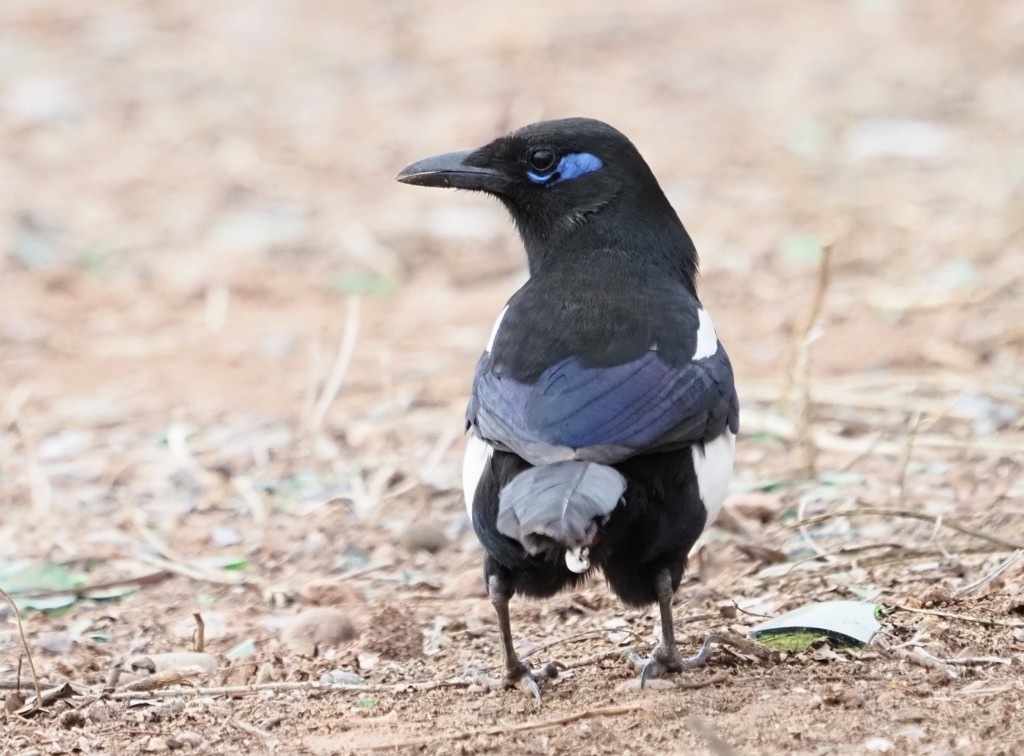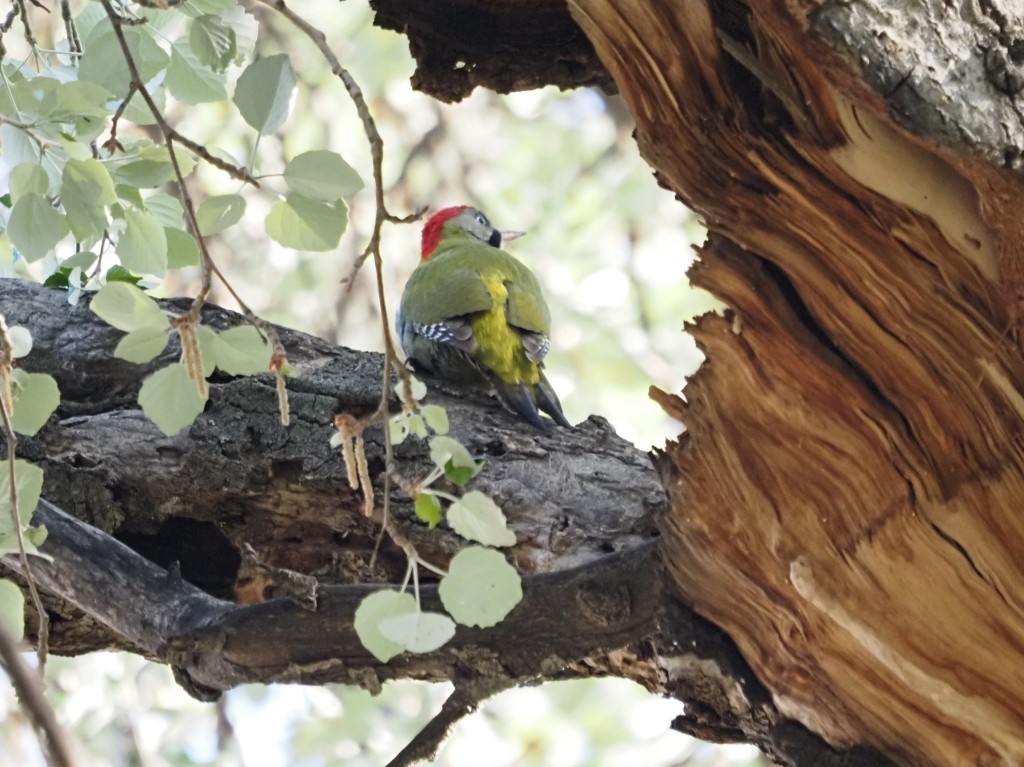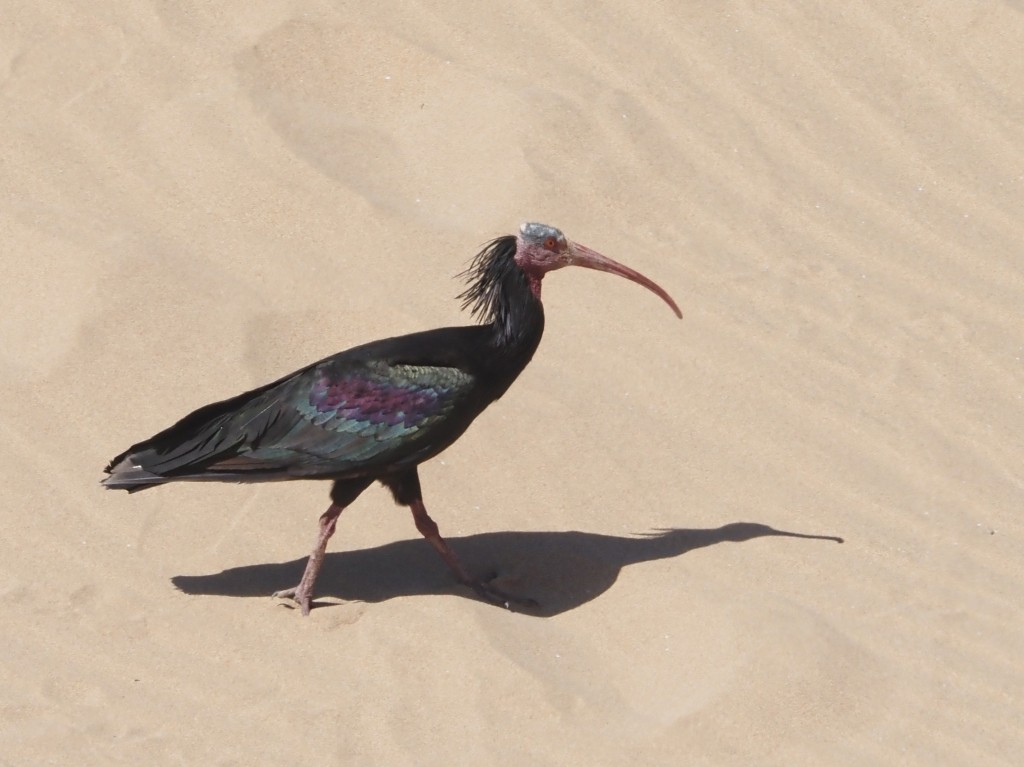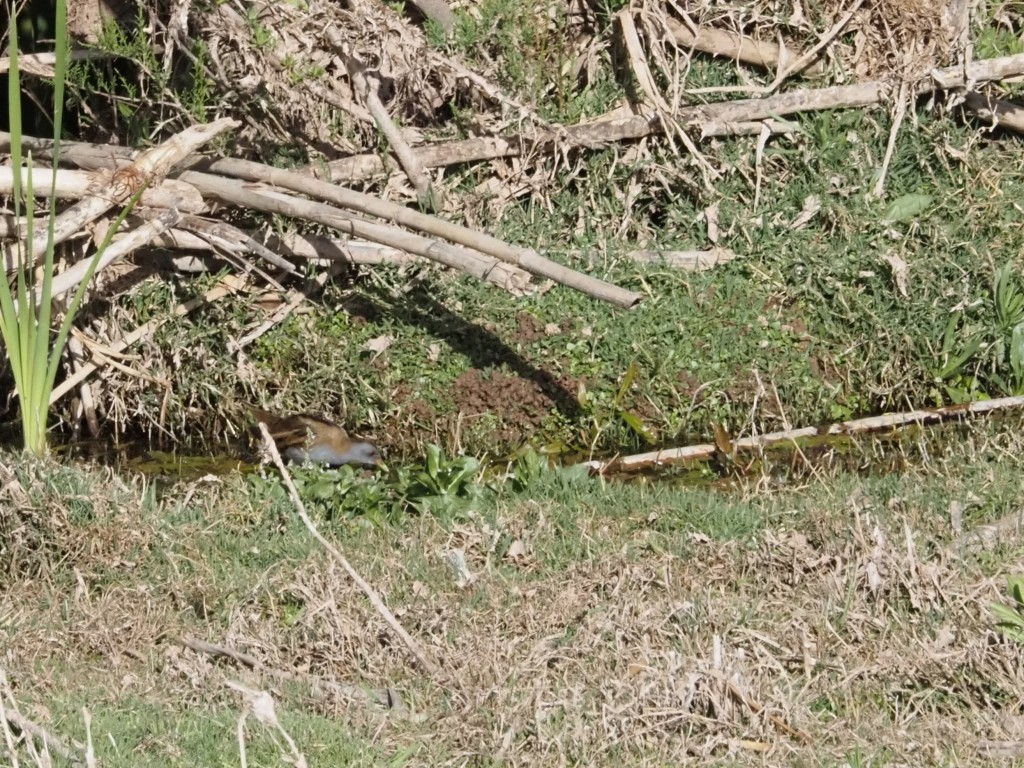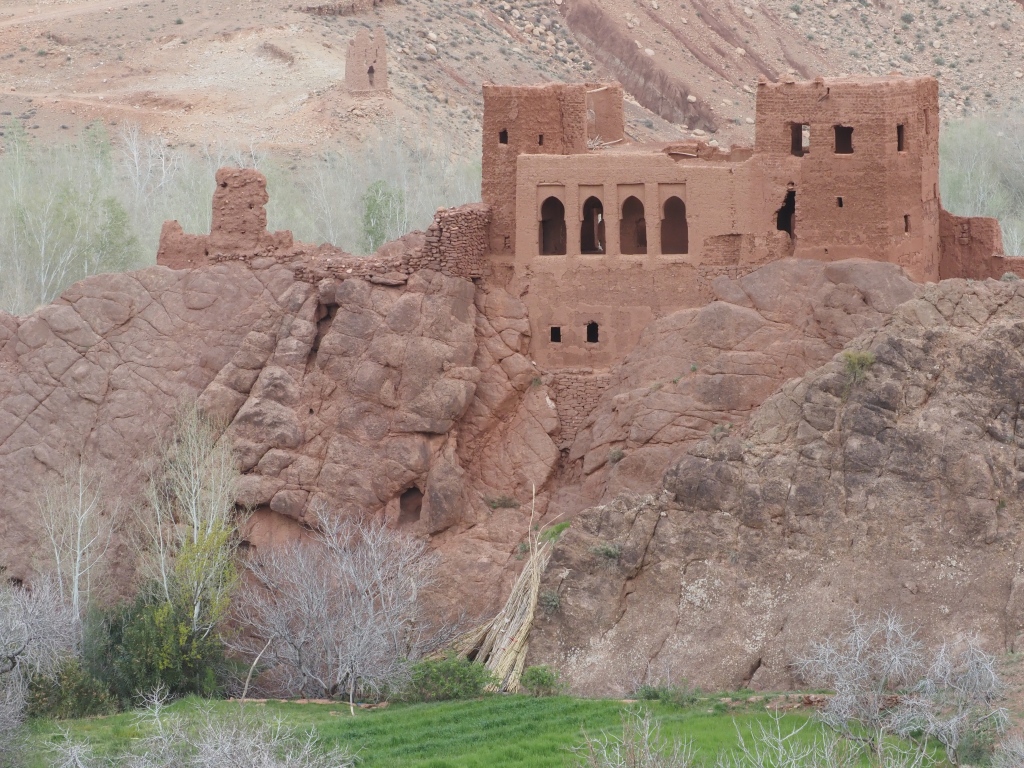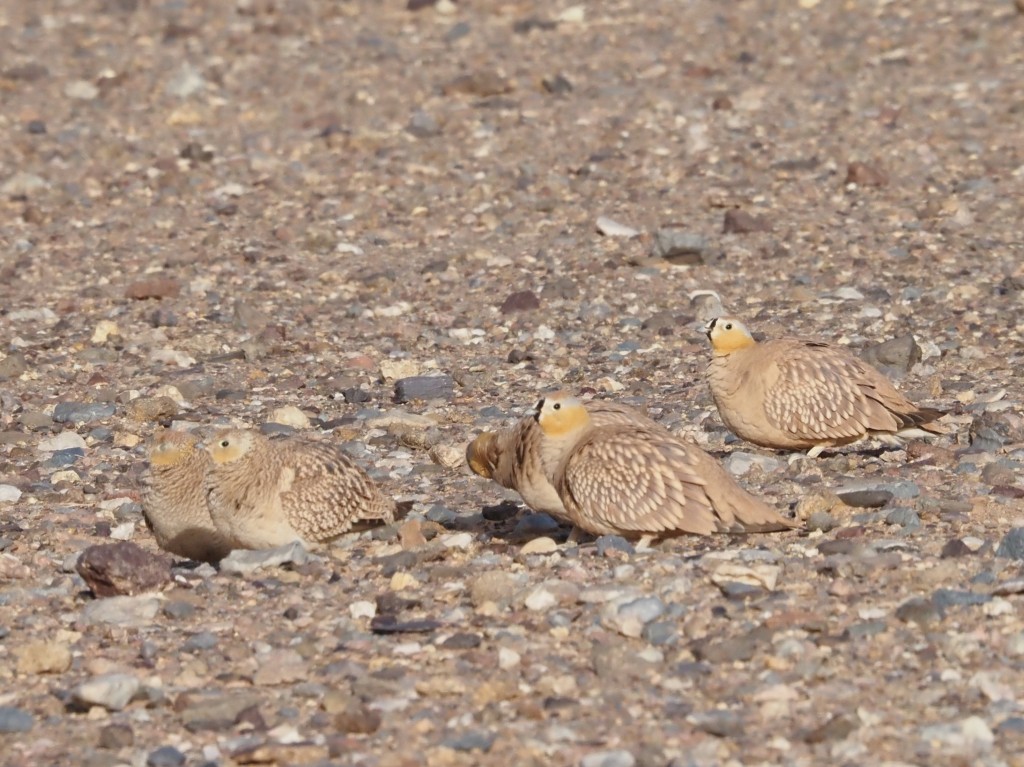- Dates: March 14th to 25th, 2023
- Number of participants: 9
- Tour leaders: Carles Oliver & Sergi Sales
- Species of birds: 196
Overview: 10th issue of our tour exploring Morocco in early spring. Arranged with the group months in advance, the tour was for 1 day in order to look for Dupont’s Lark. Our group enjoyed very stable weather all the tour long, with only an afternoon of strong wind that made difficult to find many birds. Temperatures were mild when not cool, making the birdwatching very pleasant during almost all the days. The severe drought affecting the whole Morocco had, anyway, a strong impact in our tour since most of the wetlands visited during the trip were dry or had a very low level of water. The poor water management along with the severe droughts and the over exploted subsoil waters put in a high risk the survival of most of the wetlands in this part of the world. However, we got excellent numbers of steppe birds during the trip, with more Thick-billed & Desert Larks than in any previous tour! Numbers of migratory birds were acceptable and far better than the tour in 2022, when we had almost none of them for 10 days. The excellent views on Dupont’s Lark rank high in the memories of the trip, along with the very enjoyable sights in most desert specialists.
Day 1. After a coordinated arrival to our accommodation in Marrakech, the whole group met for breakfast early in the morning. After enjoying the coffee, tea and some fruits and eggs, we left to explore the Atlas mountains. It was a very sunny day and warm day in Marrakech and before leaving we enjoyed a stop to see the hundreds of Pallid Swifts around, the fast wing beats of the Little Swifts and some urban birds including Eurasian Blackbird, Common Woodpigeon and Red-rumped Swallow.
After negotiating the traffic in Marrakech, a short transfer led us to the first proper stop of the trip. There, a line of mature trees are the perfect nesting habitat for Woodpeckers. A pair of minutes after the group was enjoying the firsts African Blue Tits of the tour, that were to join an interesting selection of birds seen during the transfer including Cetti’s Warbler, Moroccan & Grey Wagtails, African Chaffinches, European Serins, White Wagtails and Lesser Kestrels. A short walk along the tree line produced also Great Tit, Blackcaps and Little Swifts and soon after a Levaillant’s Green Woodpecker flew off from the trees to feed in the almond orchads around. During the next 15 minutes the group enjoyed non-stop views on the female woodpecker while looking for ants in the red soil. The only one Eurasian Wren of trip was heard around, and a lovely Atlas Great Spotted Woodpecker performed really well for us. Before going back to the van, a Short-toed Treecreeper appeared as well. The form living in Morocco, under the mauretanica race, is always a very interesting bird to see, as it likely to be split and be a species in its own. Other birds here included Song Thrush, Grey Heron and the very first Short-toed Snake Eagle of the tour!
Back to the road, we started the transfer up to the top of the Atlas. Along the way we had a lovely stop to enjoy another Maghreb endemic, the Tristam’s Warbler. Scanning a lovely slope full of junipers, it didn’t take us long to locate some of them, and after some time waiting one male came down the slope and showed really well. Here we also got the very first of many Moussier’s Redstarts and lovely views on Rock Buntings plus a very distant Booted Eagle.

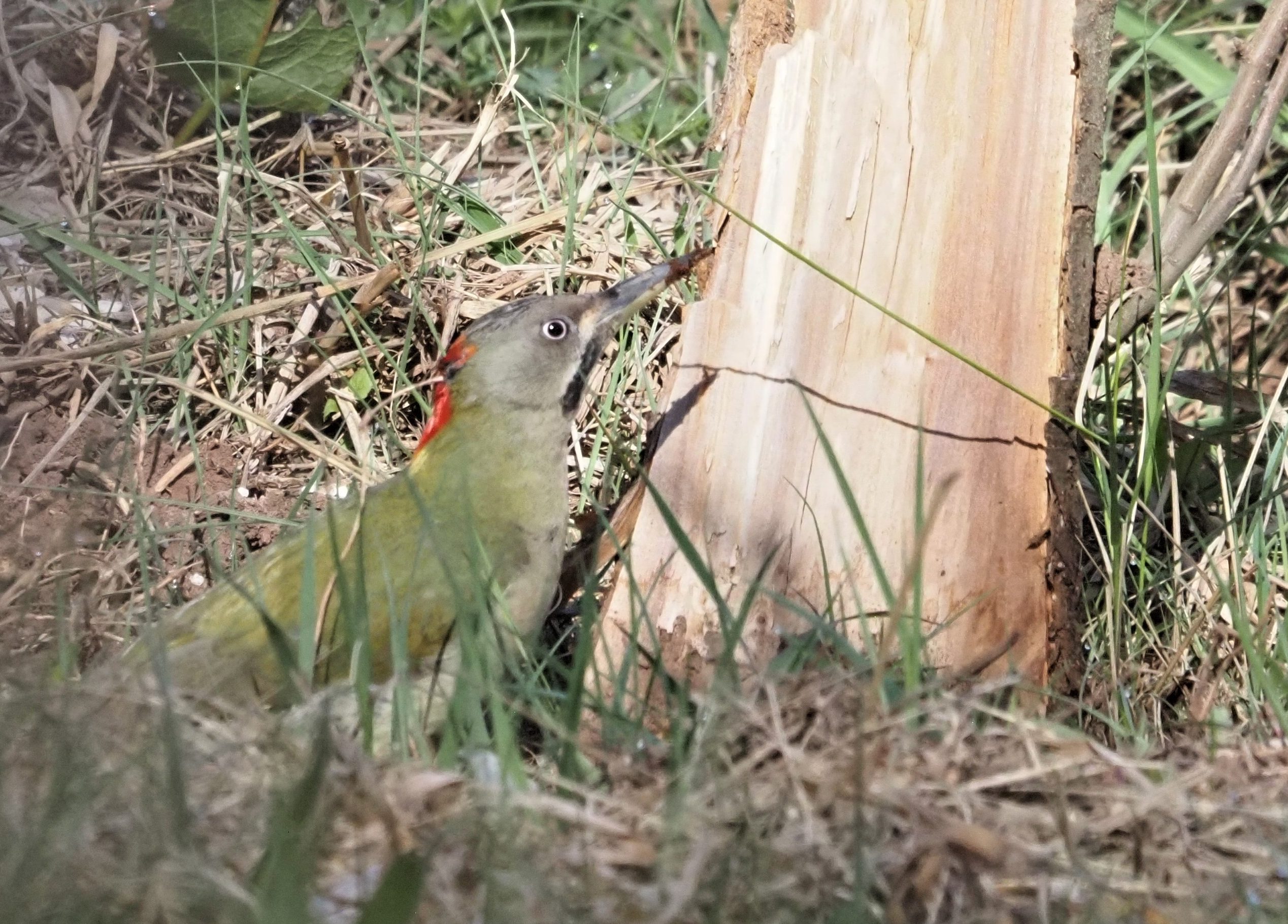
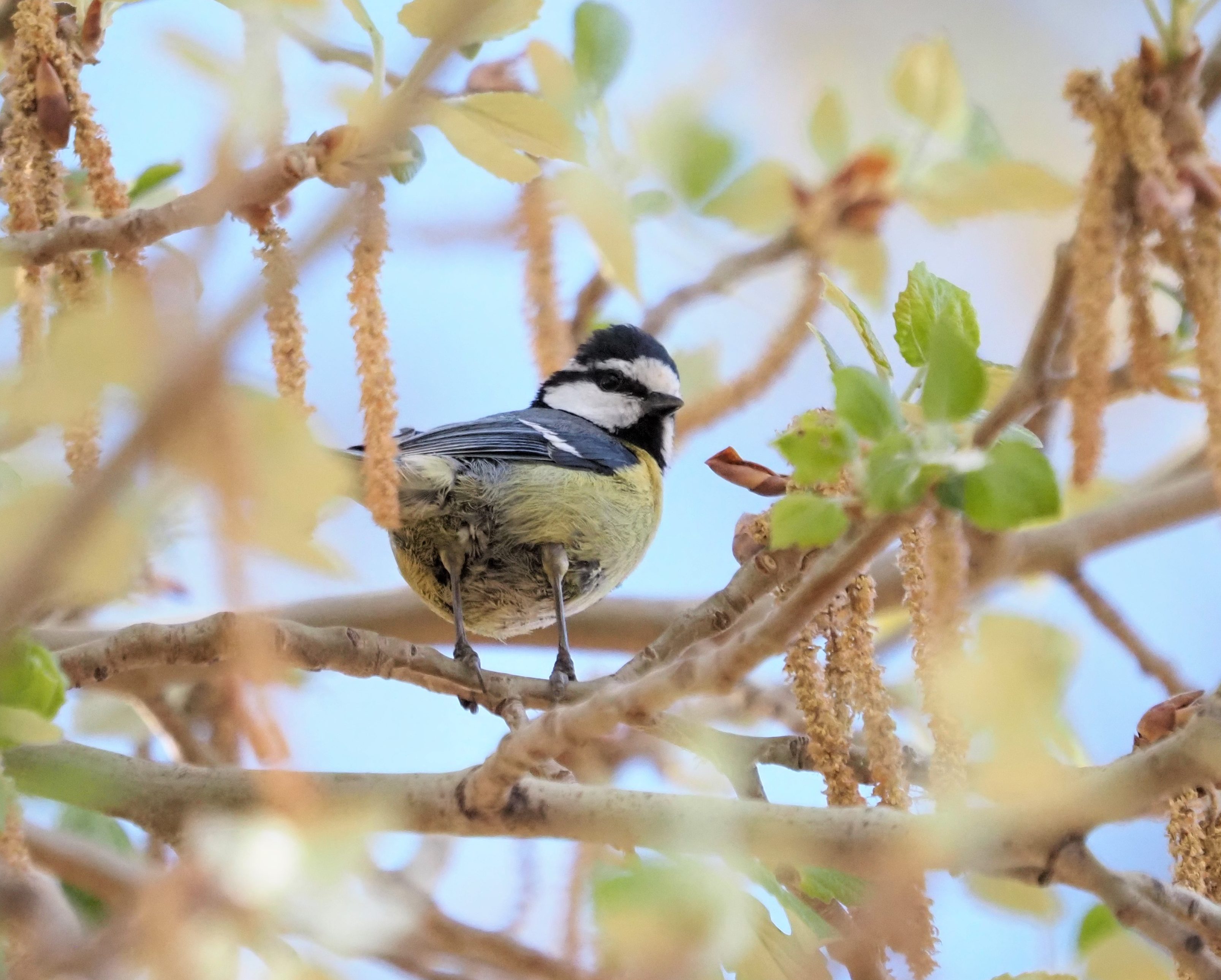
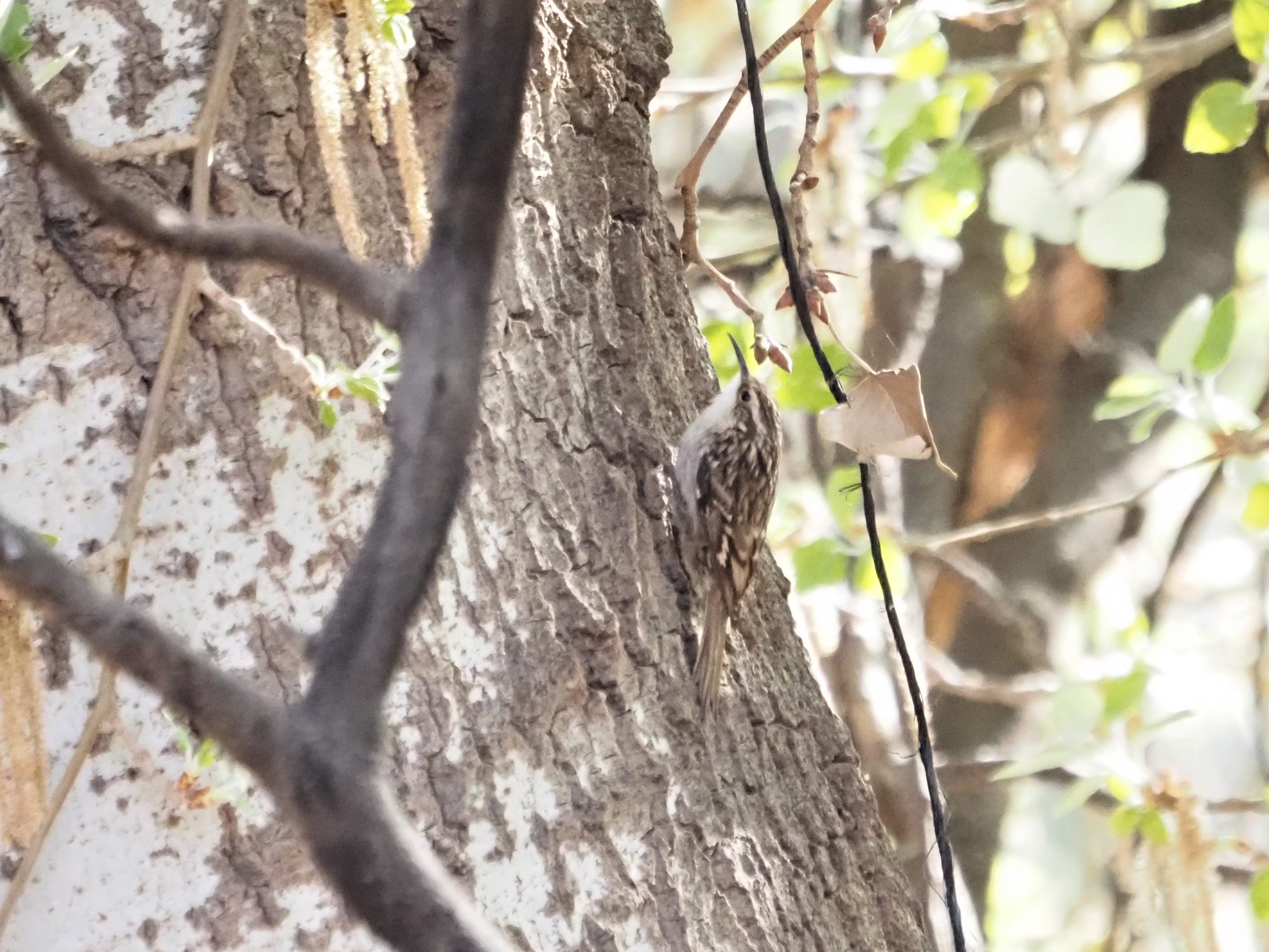
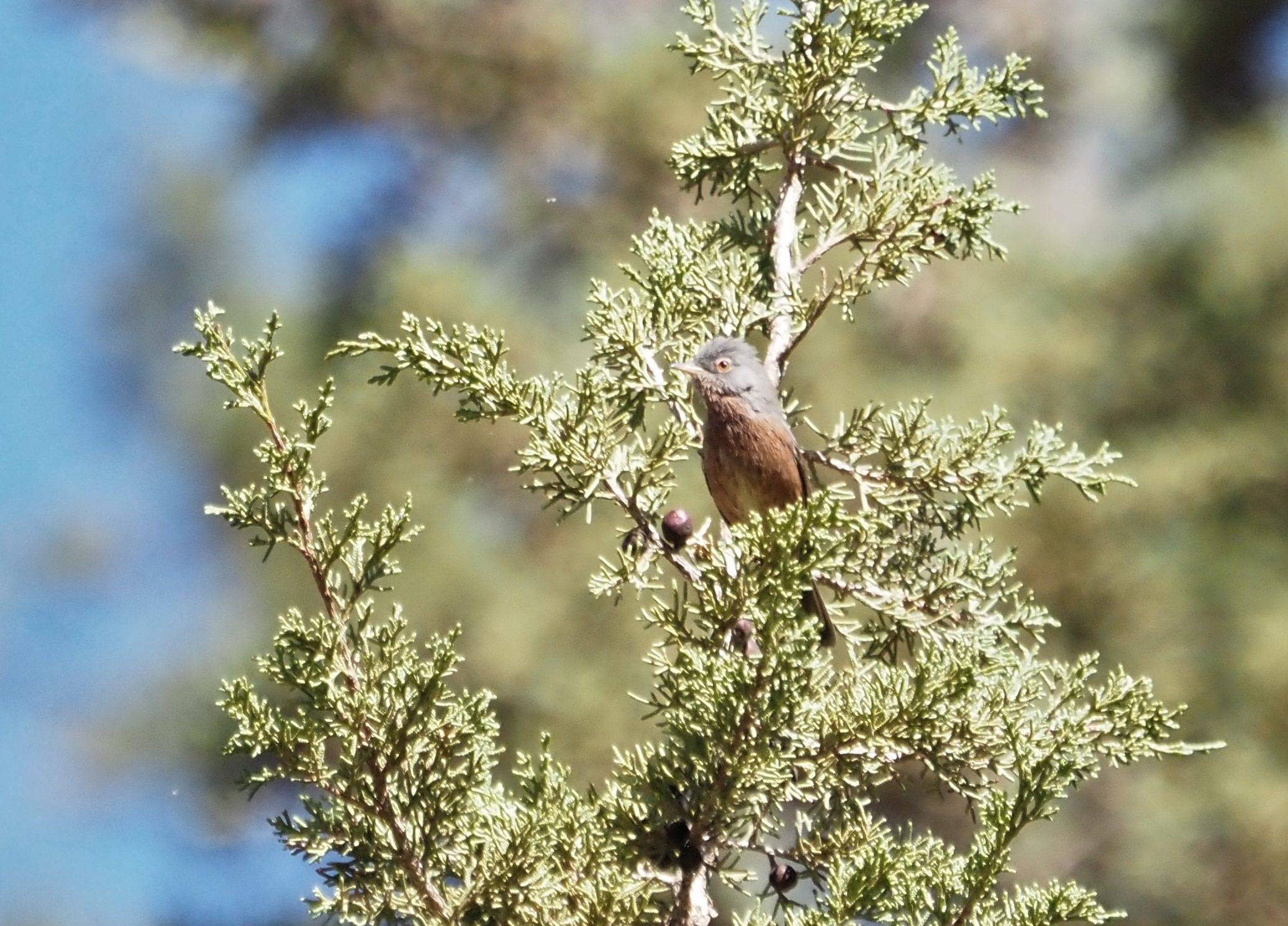
As we were winning altitude, the landscape changed from the junipers to the Spanish Firs first and then to the high mountain grasslands. There, it was already possible to enjoy large flocks of both Alpine & Red-billed Choughs, and the whole Oukaïmeden was flooded with their characteristic calls. Once parked, a stroll aorund produced several Black Redstarts, Common Rock Sparrows and a pair of Grey Wagtails. The area was really full of locals that have come up in the mountains to enjoy the snow, and we had to go a bit away from them to contact with a first flock of African Crimson-winged Finches! First we found 5, then 7, 11, 15 and so on!! Perched in the buildings and feeding on the ground, this endemics bird to the Atlas provided the group with great views!
Happy with this great views we went for dinner in a restaurant nearby, and better views on both Choughs were done while waited to be served. After lunch, a second stroll around produced not only great views on Mistle Thrush, Thekla Lark, Rock Sparrow and obliging Atlas Horned Larks but also a rather unexpected male Seebohm’s Wheatear (also refered as Atlas Wheatear) feeding in the grasslands! This bird was really celebrated in the group, that was well aware that the fenology of the species (arriving to the Atlas by the end of March after spending the winter in the Southern part of the Sahel) makes the species often difficult to find in this tour.

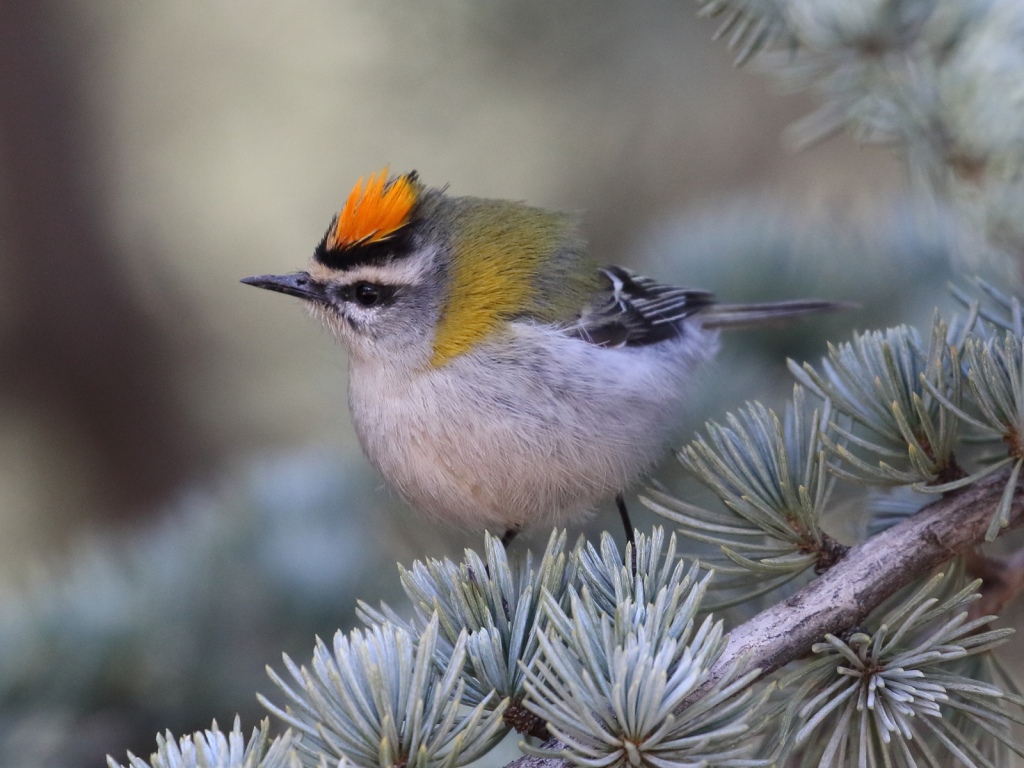

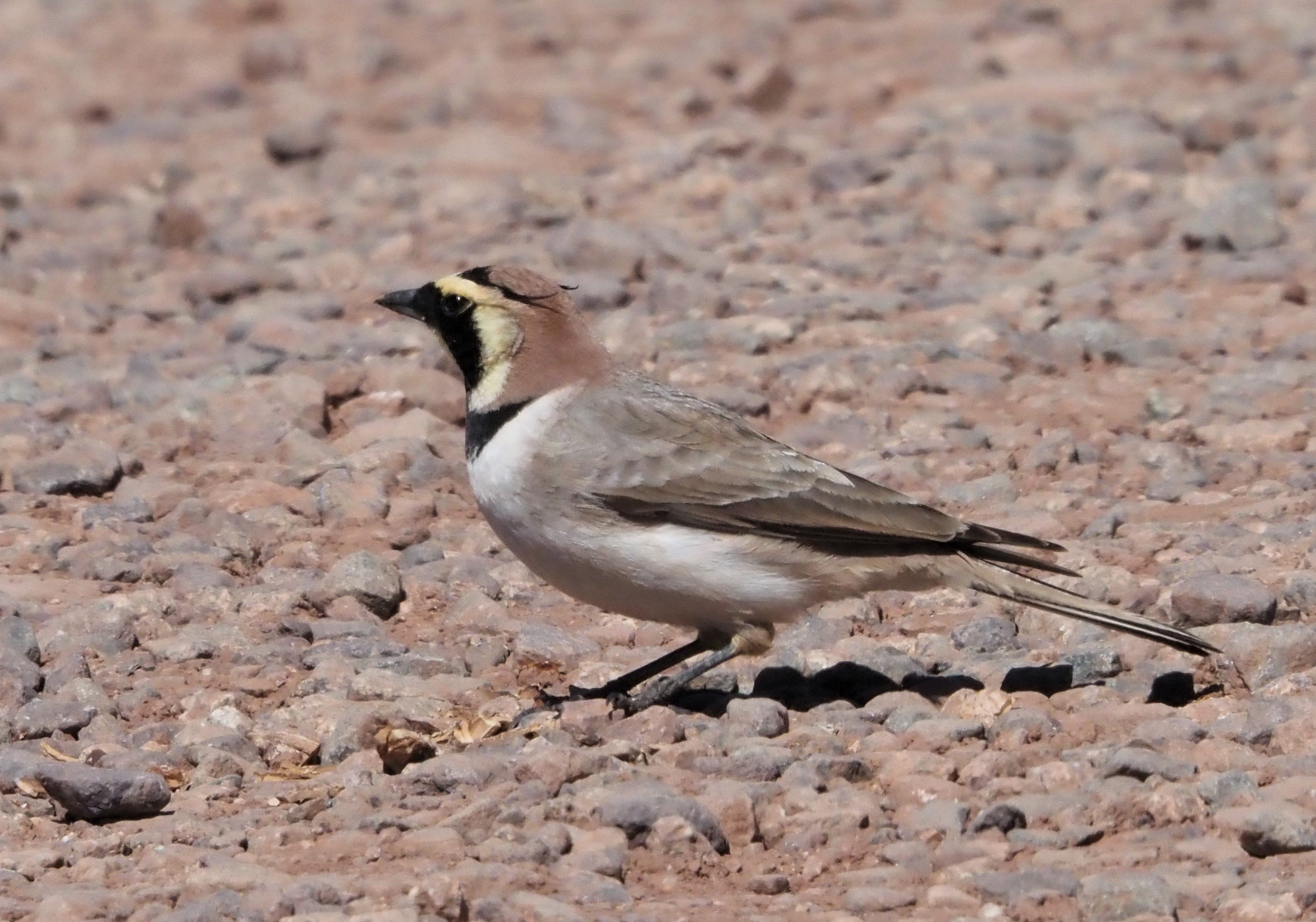
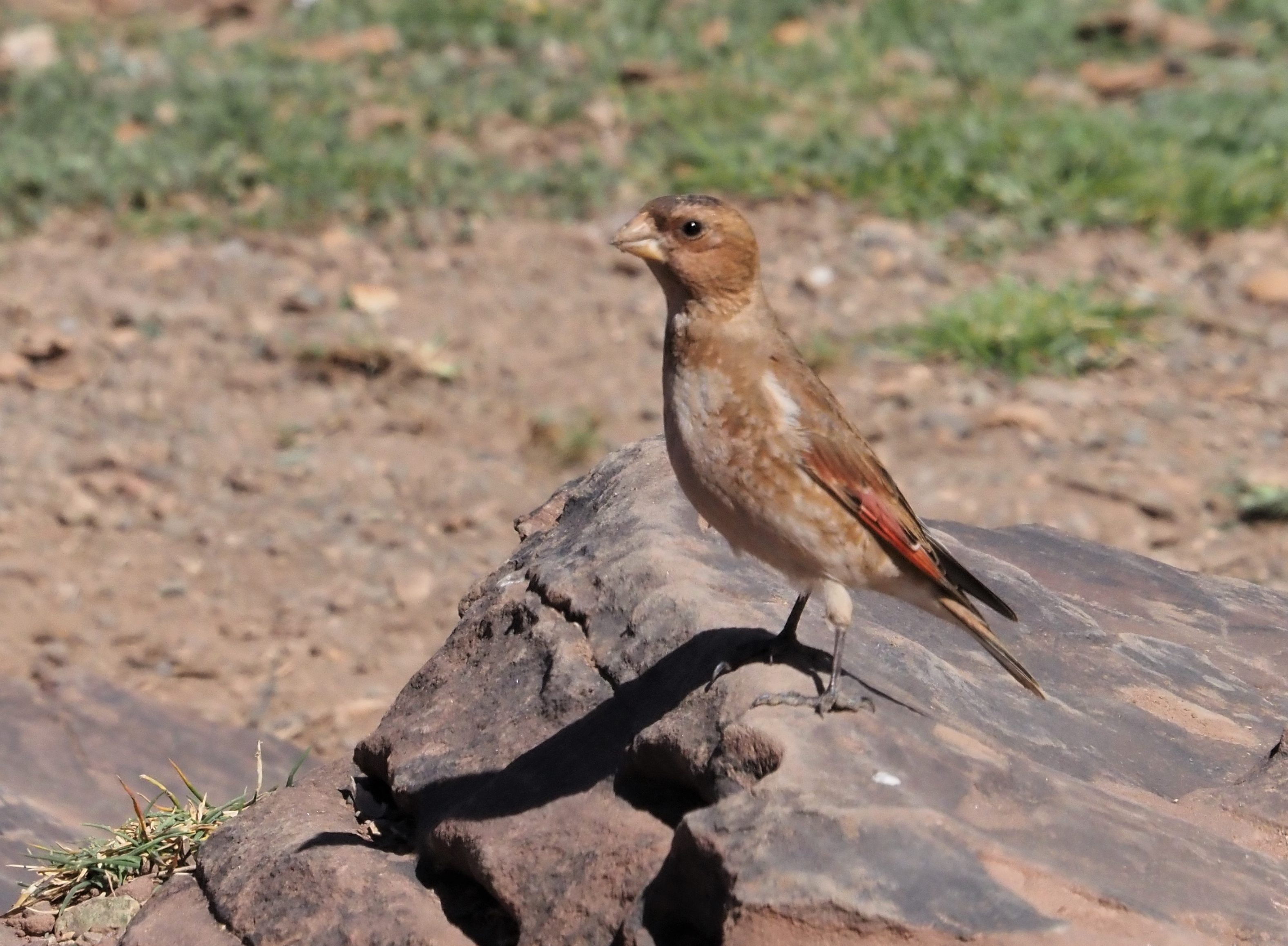

Day 2. The day started with a pre dawn walk in the streets of Marrakech. Our goal was to locate the endemic Maghreb Owl, that is having a small population in different gardens of the city. We couldn’t be more lucky when, after only 15 minutes of search, our efforts were granted with a wonderful Maghreb Owl sitting in a small tree! During the next minutes, we all enjoyed great views on it before it flew off, back to the gardens!
After breakfast, transfer to Agadir. Once leaving behind the massive plains around Marrakech, we had a stop near the coast immediately South of Essaouira to enjoy the birds living in the famous Argan trees, a evergreen species that produces a really appreciated seed used in cosmetic industries, lotions and so.

The day was warm but the Atlantic never stop to send fog inland, and during most of the day the ambient was a bit misty. Soon after stopping we had Western Orphean Warblers singing and displaying around, some of them being really obliging! African Chaffinches were common there and with some patience we also found Western Bonelli’s Warbler, European Bee-eater, Common Redstart and Woodchat Shrike. Neil enjoyed the stop so much that decided to stay a bit longer than expected… Nothing serious, only a rather long stroll
From here our next stop was to explore the sandy plains around one largest colony of Northern Bald Ibis. There we has an interesting set of species including some good flocks of Greater Short-toed Larks, Spectacled Warbler, Thekla Lark and a distant Barbary Falcon that was enjoying a prey on the ground. A bit of sea watching was made as we were waiting for the Ibises to appear, adding Audouin’s Gull and Lesser Black-backed Gull to our list. There, Mark was lucky enough to have 1 Atlantic Puffin flying North! Some Northern Bald Ibises were flying up and down but always distant.
After about one hour waiting in the area, we finally were rewarded with a nice flock of 8 Northern Bald Ibis landing in the plains only 200 metres away from us. Our group enjoyed great views on them while they were preening and feeding a bit around. Excellent views that were really celebrated by the group. When leaving, we got a flock of migrating Wheatears feeding next to the road: 1 Western Black-eared male, 1 Seebohm’s male, and 2 Northern Wheatears!
After some lunch rest, we drove the short distance to the small Tamri Estuary, were we had the firsts Ruddy Shelducks of the trip along with 20+ Kentish Plovers, Moroccan Wagtail, Audouin’s Gulls and several Western Yellow Wagtail plus Ringed Plovers, Subalpine Warblers, Red-rumped Swallows, Grey Heron, Little Ringed Plovers, 4 Ruffs and 20+ Northern Bald Ibis in flight!
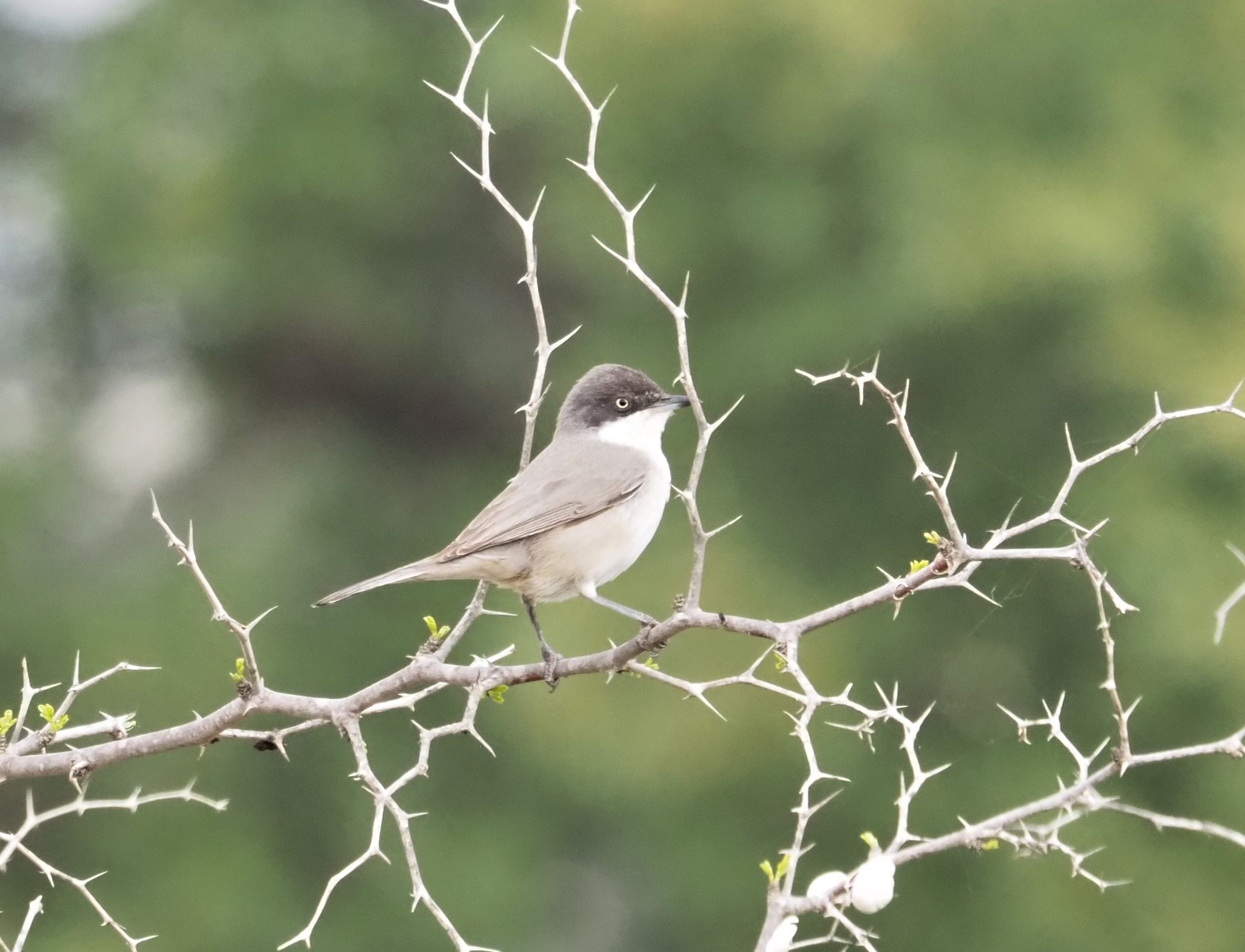
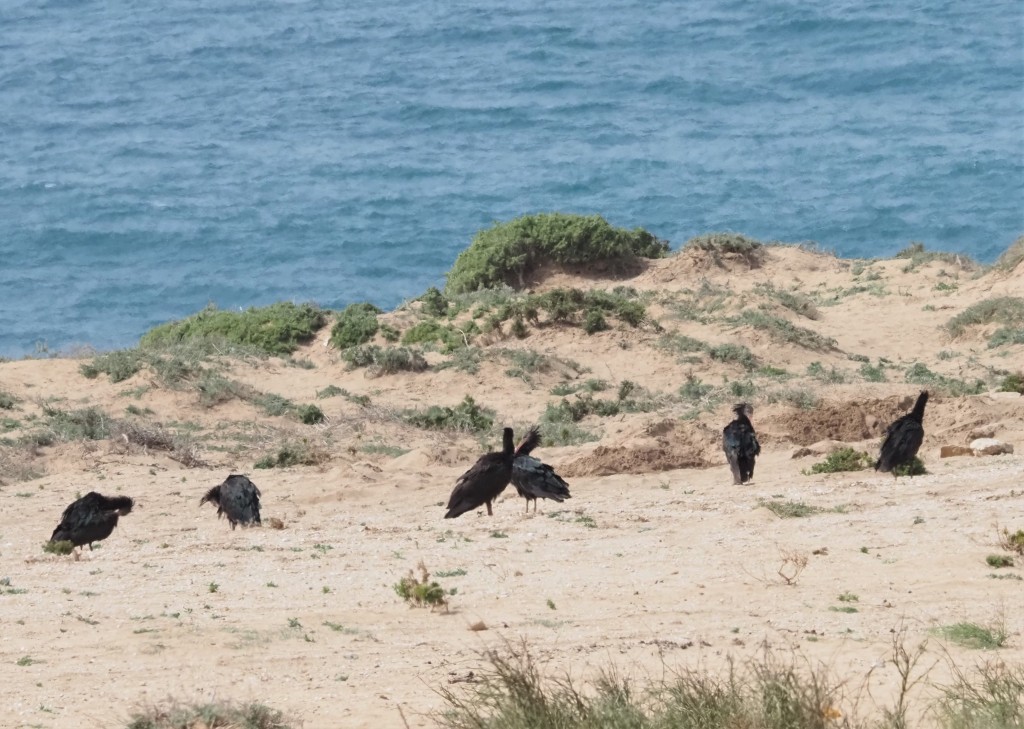
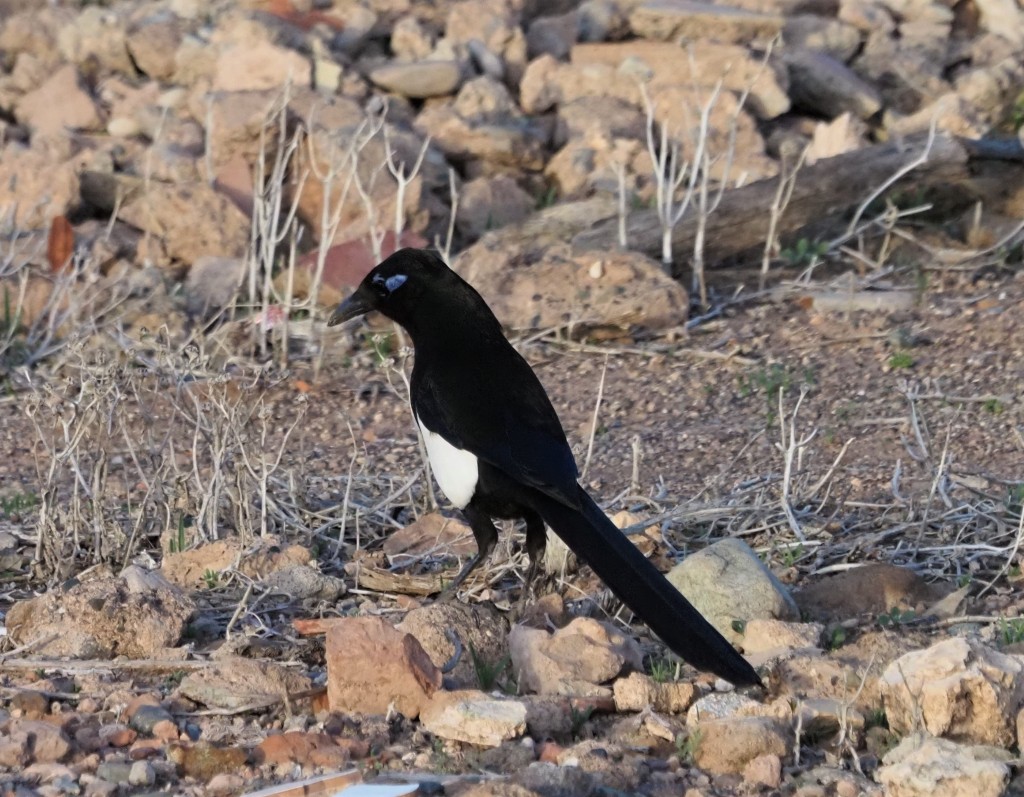
Going South, we negotiated the always challenging traffic in Agadir to explore the Souss Estuary, one of the best brackish wetlands in this part of Morocco. Here we had a good selection of waders but always with little numbers if compared with previous years. Some noted species included Eurasian Whimbrel, Black-winged Stilts, Osprey, Grey Plovers, Ringed & Kentish Plovers, Common Redshanks, Greenshanks, both Black-tailed & Bar-tailed Godwits, Whimbrel, 6 Red Knots as well as Pied Avocets and Oystercatchers. Here the group also enjoyed close views on the beautiful Maghreb Magpies and flocks of tern including several Sandwich Terns and very vocal Gull-billed Terns along with a solitary Common Tern.
From here we drove a last transfer to our accommodation in the Souss-Massa National Park, where we had a fly over Stone Curlew some miles before arriving to our hotel.
Day 3. The cloudy morning provided us with a very comfortable temperature. This day was devoted to explore the Massa River and nearby areas. After breakfast, we only had to walk a few meters to contact with the first of many Black-crowned Tchagras, wonderful bird that was calling and showing out nearby our van. A short drive of only 5 minutes allowed the group to explore a pair of corners with excellent birding. The numbers of migratory warblers were good all along the river, and in the next 90 minutes we got a good array of warblers including Sardinian, Western Subalpine, Western Orphean, Cetti’s, Zitting Cisticola, Iberian Chiffchaff, Willow Warbler, Western Bonelli’s plus first views on Western Olivaceous Warbler singing and calling in the tamarisks. Moussier’s Redstarts were a common view around while the bush were full of migratory warblers. Flocks of Spanish Sparrows were flying around, and some provided close views along with really obliging Cirl Buntings, African Chaffinches and European Stonechats. Another wonderful spot was a Little Owl perched low in a small bush.
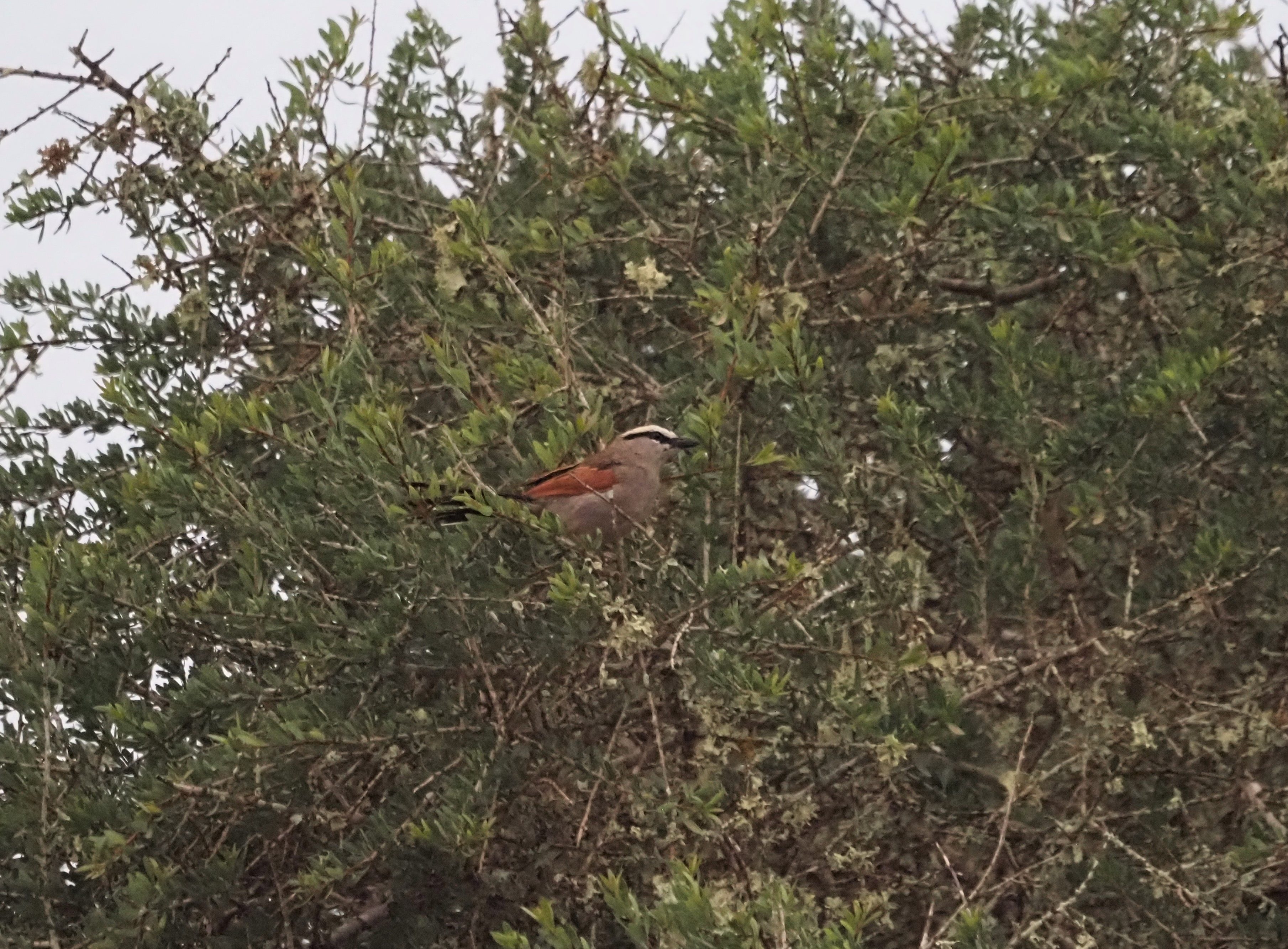
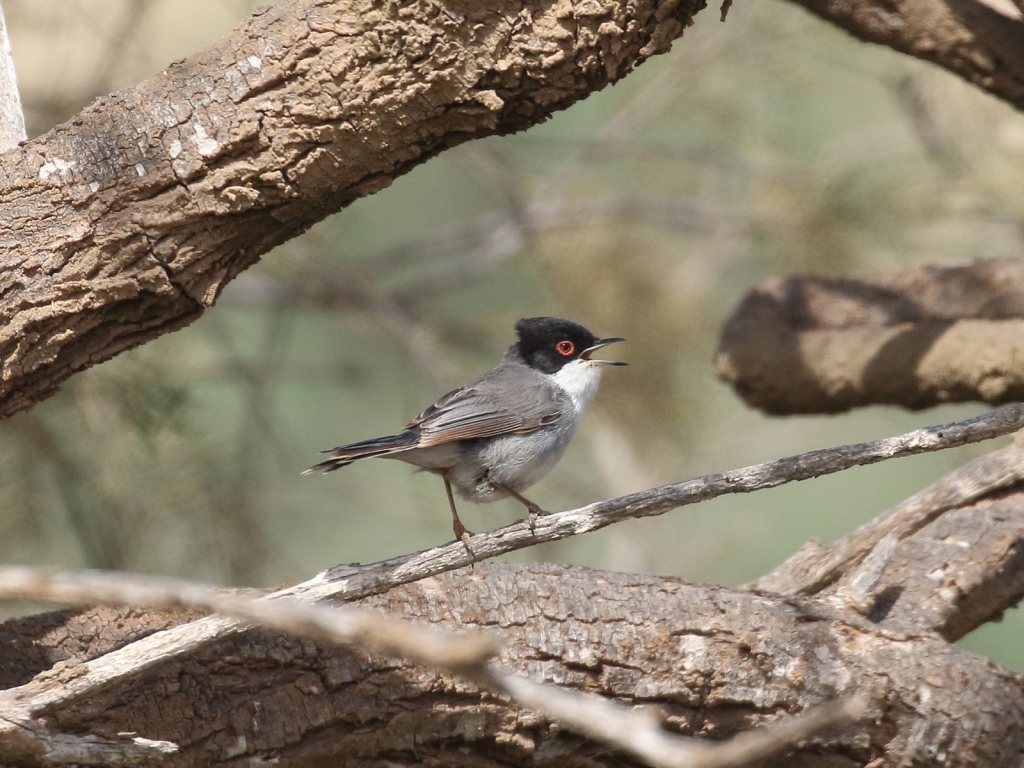
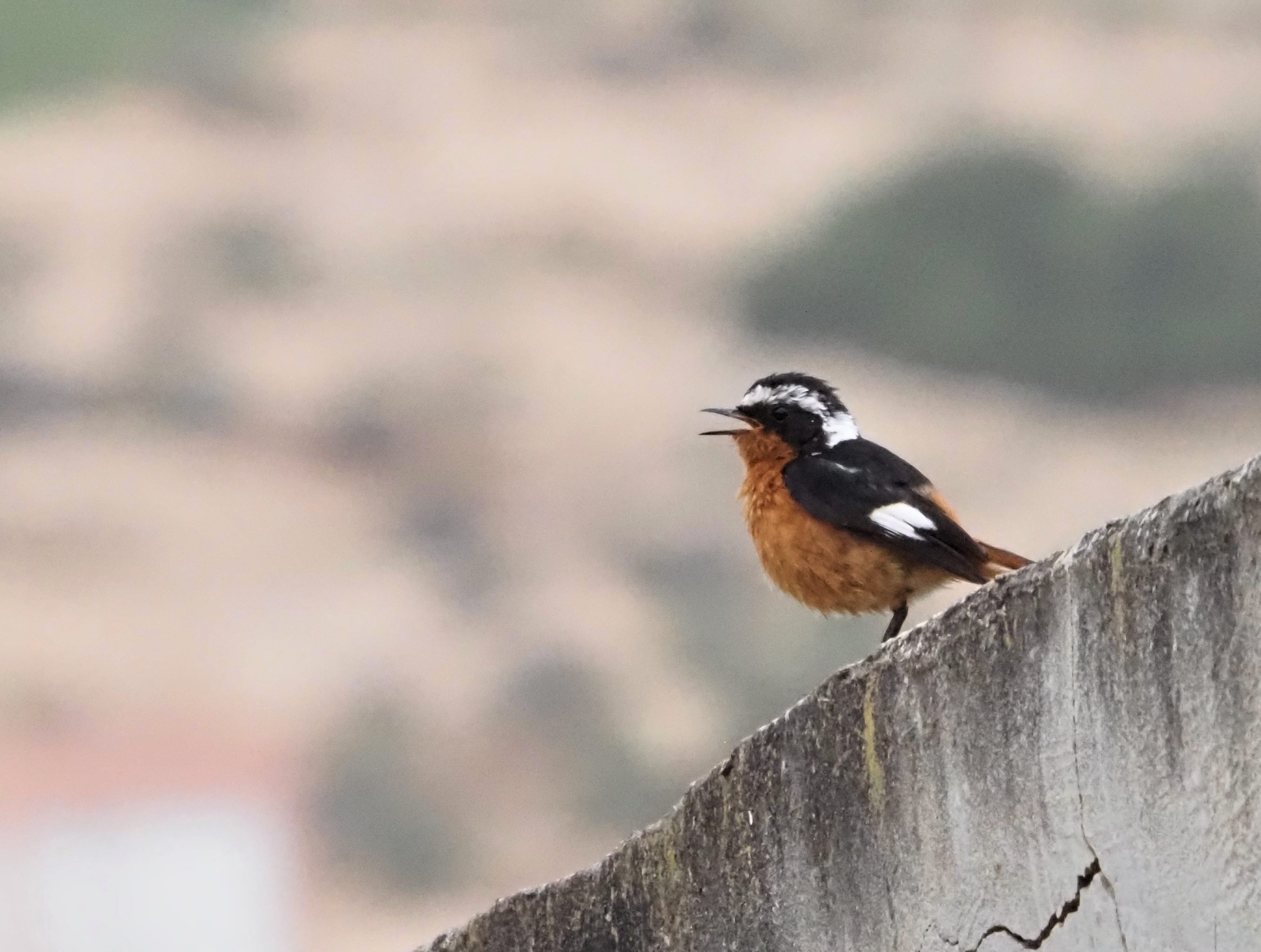
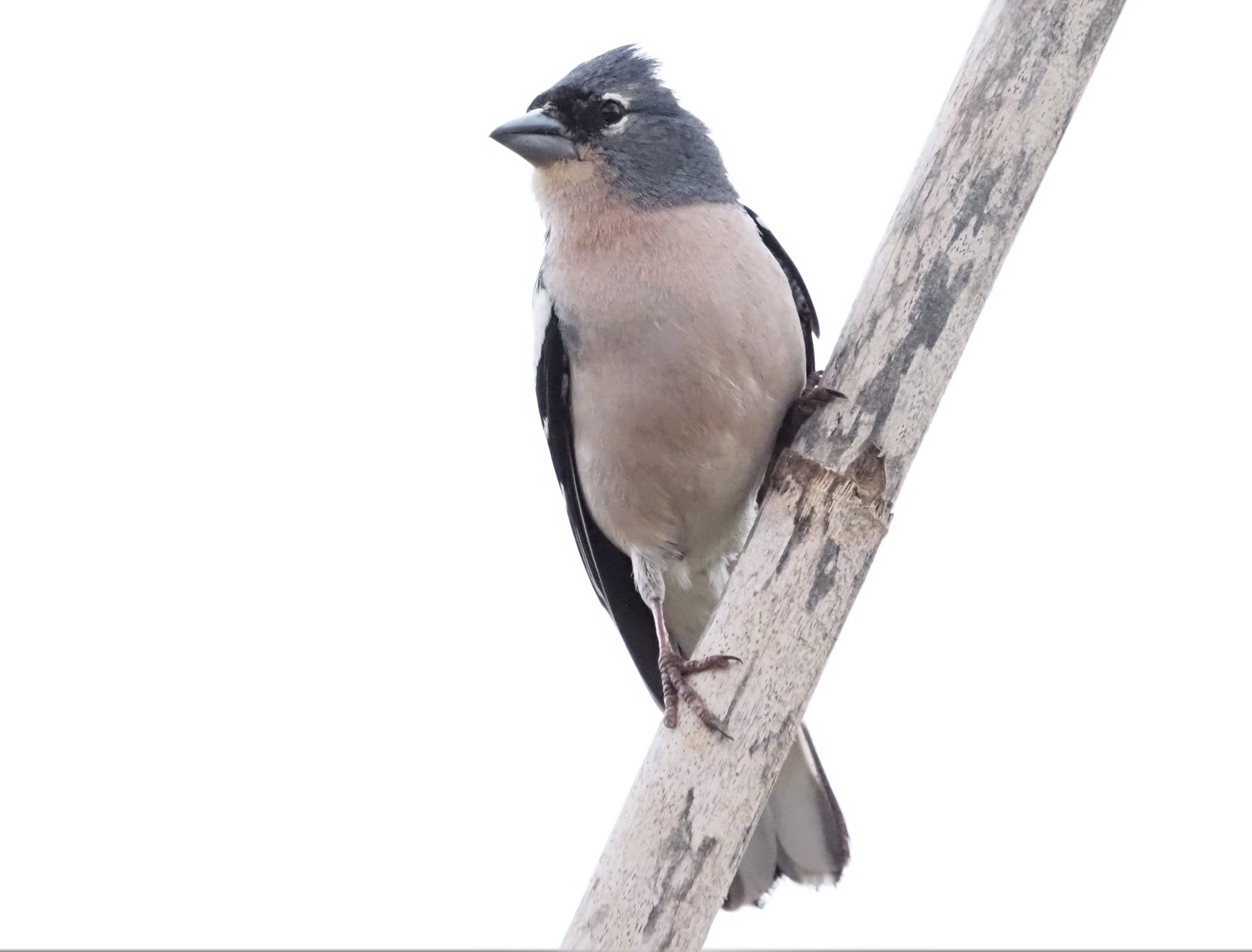
Up in the air there were small flocks of Little Swifts but also Common & Pallid Swifts while some European Bee-eaters were flying around. In the ponds, the waterfowl was scarce due to the low level of water, but our first stops still produced Common Kingfisher, Glossy Ibis, a lovely Purple Heron and a roosting flock of Night Herons. Tree Pipits, Common Quail and Melodious Warbler were all heard, and we got some views in all of them, out of the Quail.. In one of this ponds, we had the first Brown-throated Martin of the day, all the whole group enjoyed close views on this tiny swallow while hunting insects around. This is a decreasing species in Morocco, currently with only a few colonies left, mainly in the wetlands along the Atlantic coast.
The very last pond before lunch produced not only warblers also Eurasian Teals, Wood & Green Sandpipers and Little Ringed Plovers.
After lunch the clouds disapeared and the lovely blue sky was back. We went to explore the Massa River mouth. En route, we had Black-winged Kite & Western Marsh Harrier + Tawny Pipit and Greater Short-toed Larks. Once in the area, we were surprised by the few birdlife there. Here we only had distant views Eurasian Spoonbills, Ruddy Shelducks, Northern Shovelers, Kentish Plovers, Greenshanks while the scrublands around had a few migratory warblers and small floks of Common Linnets and European Serins.
Back to our vehicles, the rest of the afternoon was devoted to sea watching in nearby coastal cliffs. Despite the rather misty ambient and the hard light with the sun placed above the sea we got a fine selection of sea birds including several Arctic Skuas moving South (!) as well as small numbers of Balearic, Cory’s & Manx Shearwaters mainly moving North. Large flocks of Oystercatchers were migrating along the coast and, as the afternoon went on, the group was able to catch up with some other sea birds including Pomarine & Great Skuas and some Razorbills, all of them moving back North to their nesting grounds in Europe.
Day 4. This day we left Agadir in a very cloudy ambient that was to be with us until we crossed the Anti Atlas. Beyond there we enjoyed the sun in the Ouarzazate basin, but also the very windy conditions. A first stop was done en route to enjoy a pair of Black-winged Kites by the road. Our group was lucky enough to enjoy some mating, with the mail very nervous and flying all the time from a prominent perch to the female and back. Both individuals were really excited, even with some calls in a species that is really silent in average. The whole scene was ideal to capture some shots of the bird, and it was one of the best raptor experiences along the trip in a country that is having every time less and less birds of prey in its skies due to direct prosecution.
Along with the Black-winged Kites, we also enjoyed here some Crested Larks but also flocks of Spanish Sparrows, Eurasian Blackcaps, Corn Bunting and another singing Melodious Warbler that only gave us partial views..
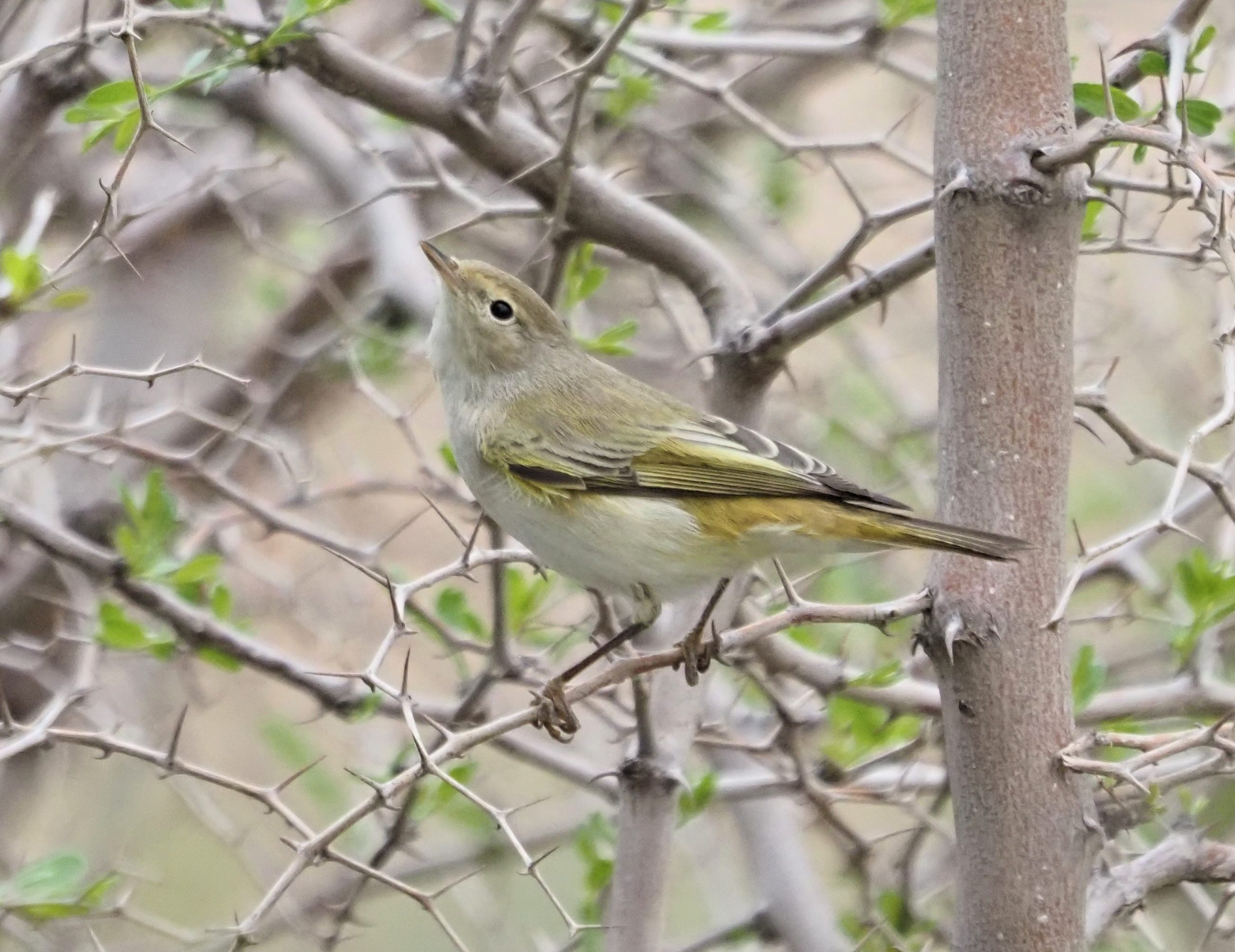
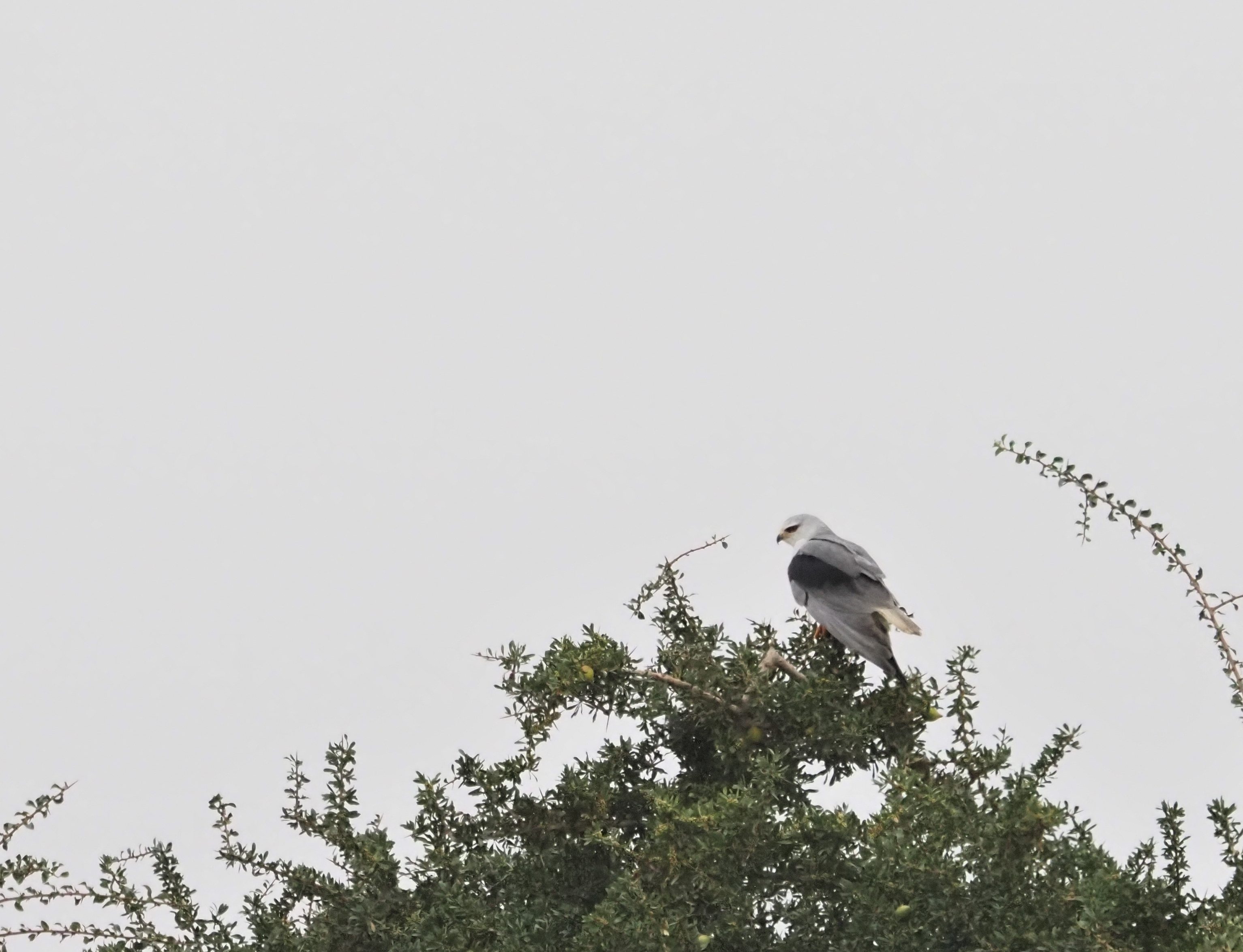
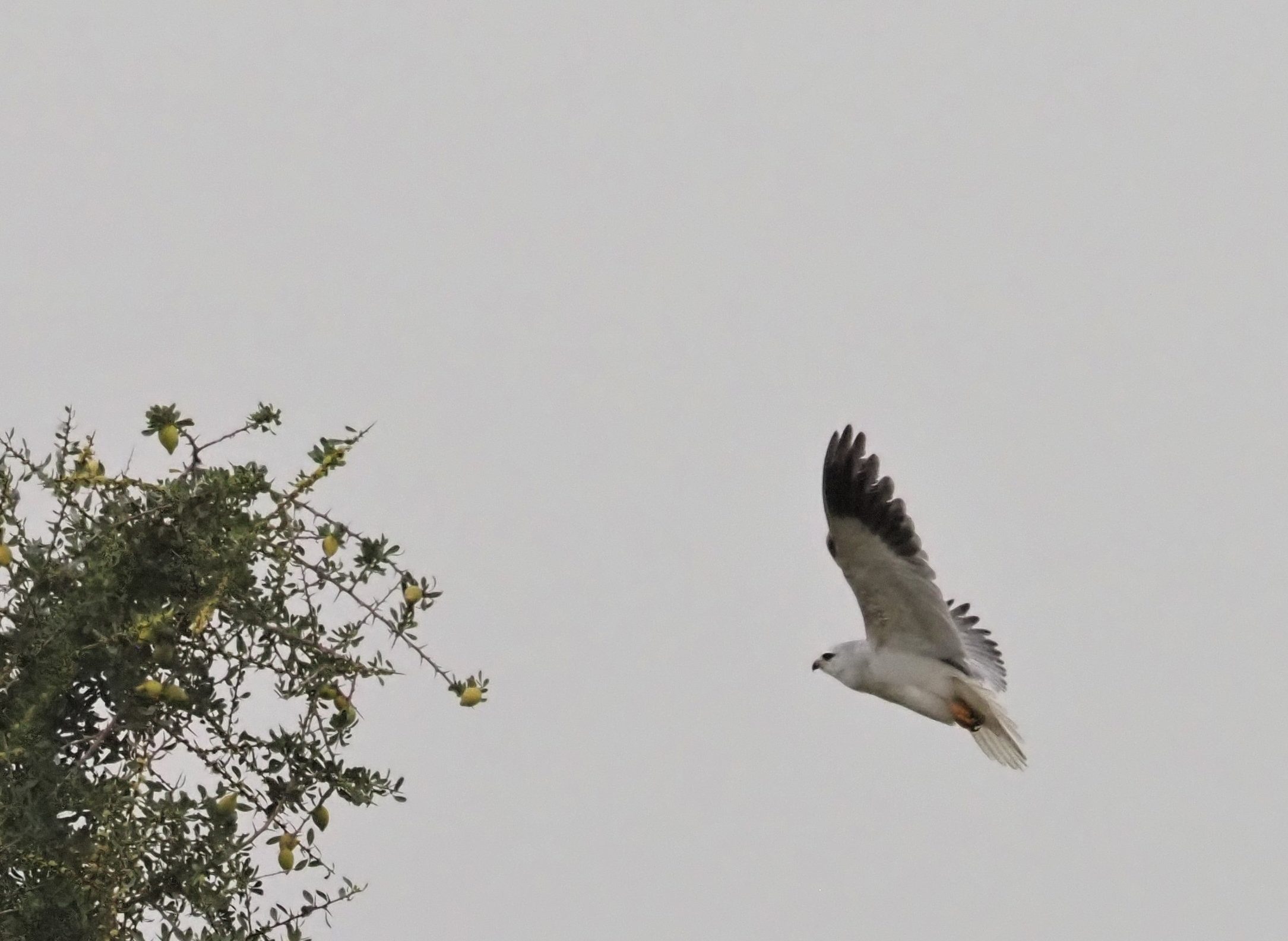
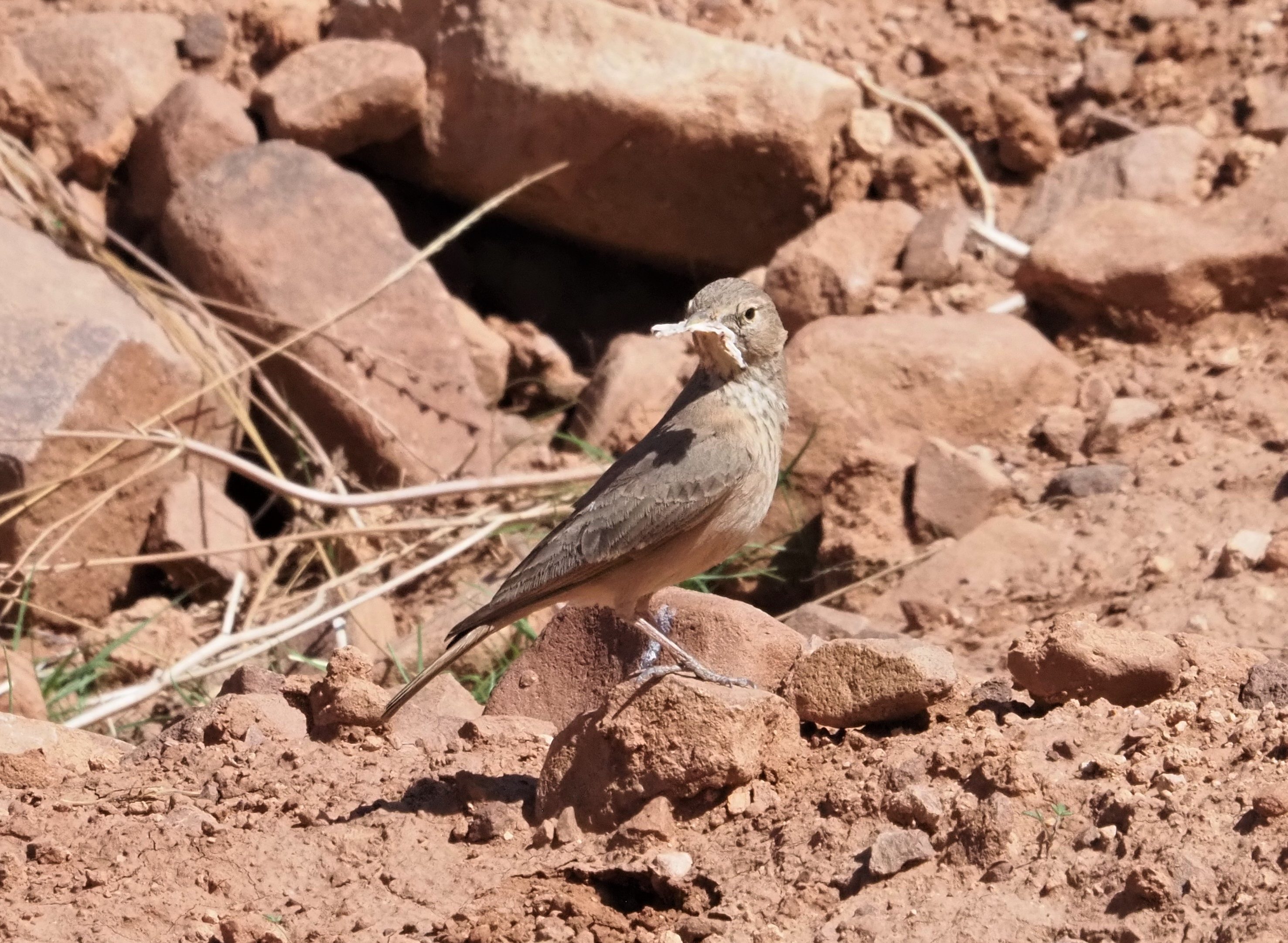
Back in the road we had a pair of additional stops in the road to enjoy the firsts of many Trumpeter Finches and Desert Larks before arriving to the large barrage immediately South of Ouarzazate. There, we spent a pair of really productive hours before the final drive to Boulmane du Dades, but even before arriving to the wetland, in a stop to buy some cold drinks in Ouarzazate we had a first flock of hundreds of Black Kites with several Booted & Short-toed Eagles moving along with them! It was great to see all these birds moving above the city centre as they were flying South to look for some sheltered place to spend the night around the dump.
The dump around Ouarzazate covers a large area, has several access points, and to explore it is always challenging. Just arriving we founds a flock of 8 Blue-cheeked Bee-eaters feeding by the access road, and their flights and calls delighted the group for quite long. In that same place, the firsts Maghreb Larks of the trip showed up, providing the group with great views with its typical tame behaviour. Sand Martin, Western Black-eared Wheatear, Desert Lark, Willow Warbler and European Bee-eater were all noted as we moved on and lovely migratory flock of Kentish Plovers resting in the desert delighted us with excellent views before we could reach the proper place to scan for waterfowl. Yes, a small detour was necessary to arrive, and some tamarisks still remember the underneath of our van, but we arrived!
Unfortunately was windy, and the waterfowl was inside the reedbeds. Meadow Pipit, Great Crested Grebe, Yellow Wagtail and Eurasian Coots were noted. At least 2 Montagu’s Harrier, including one male, were seen flying above the reeds along with several Marsh Harriers. It was a bit disappointing but after some wait, a Marsh Harrier flew really low over the reeds and a massive flock of 60+ Marbled Teals appeared in the sky, flying along the reeds and giving good scope looks to the group! After such a wonderful sight, we waited some more time, and smaller flocks of Marbled Teals were again seen moving up and down, but after some time it was clear that we were not going to have a better/closer view on the birds, so we decided to leave towards our accommodation for an evening meal and some rest.
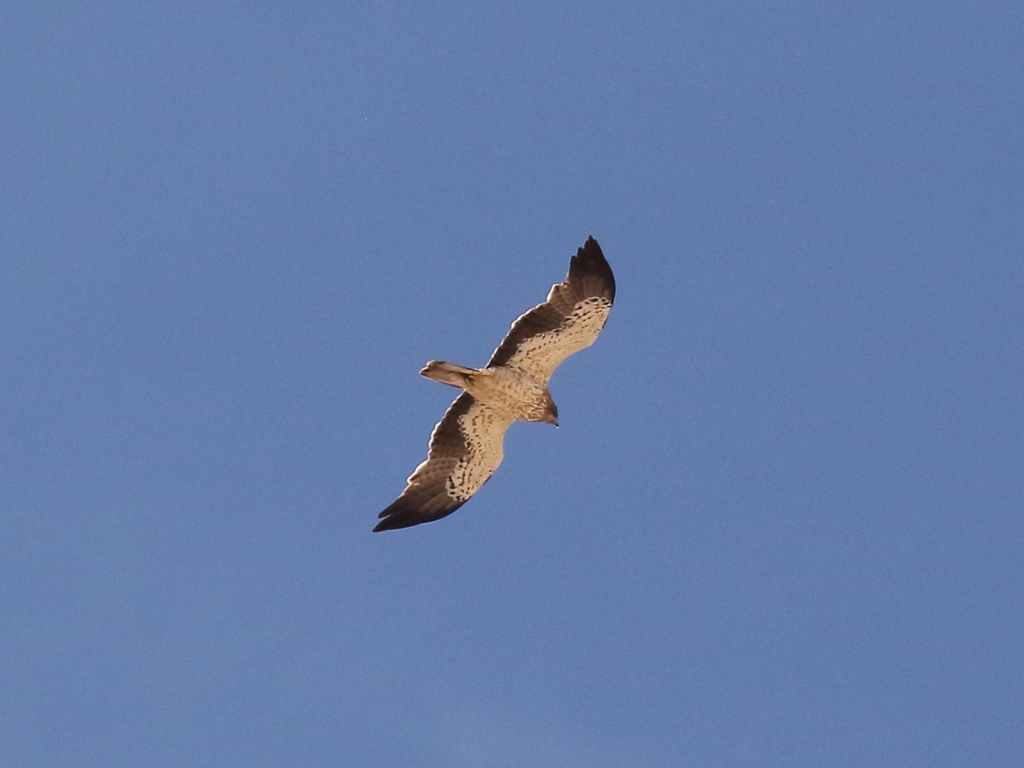
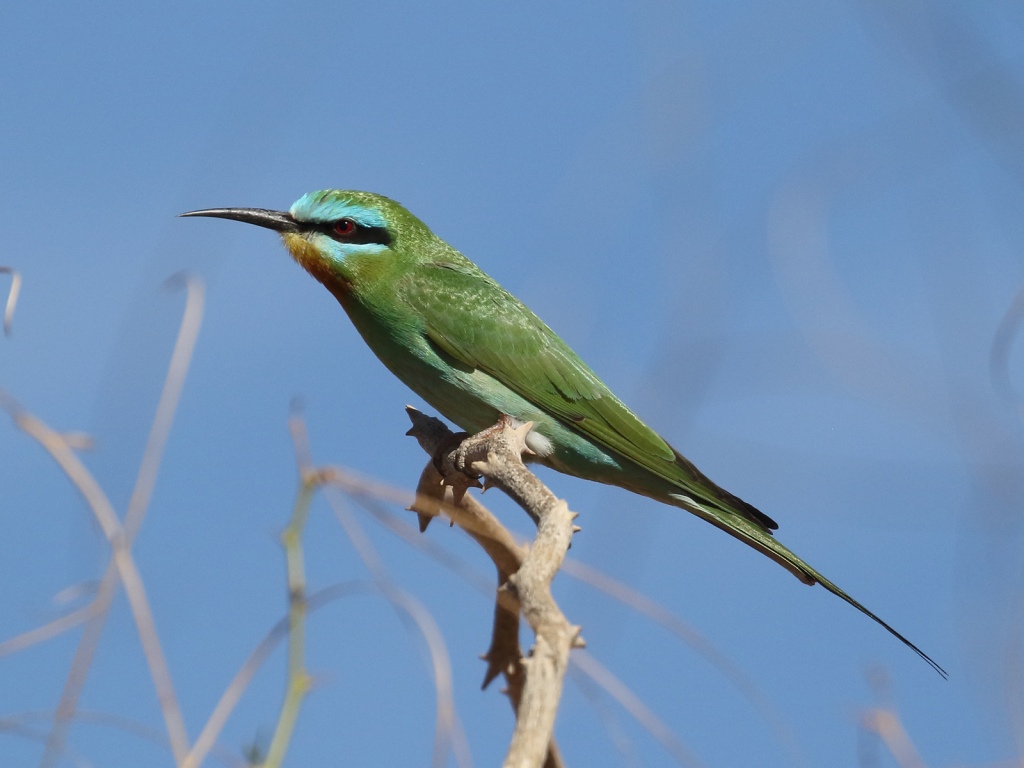
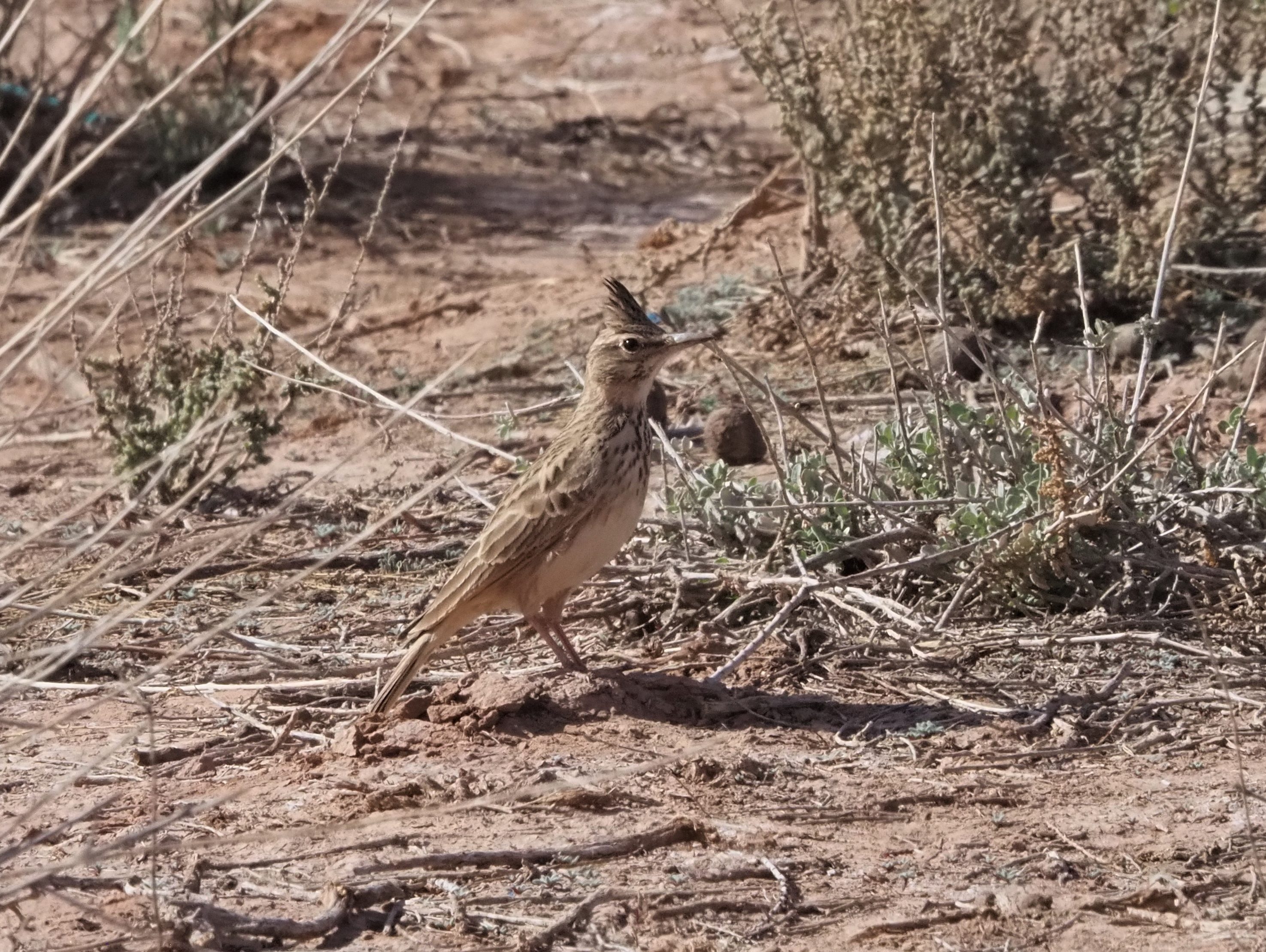
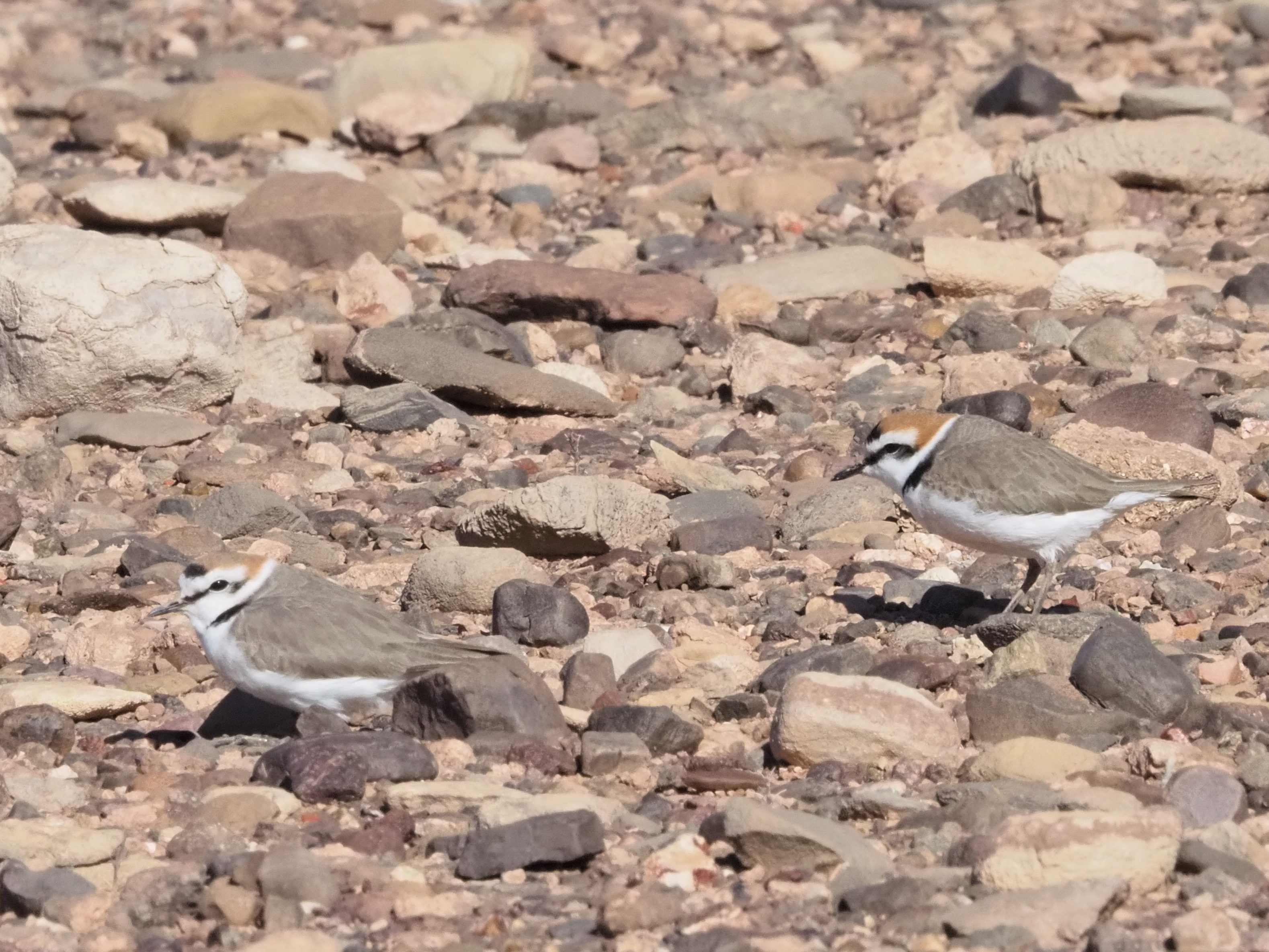
Day 5. A bit windy but sunny day in the endless plains inmediatly South of Boulmane du Dades. This day we were concentrated in locating the many goodies living in the wonderful steppe lands East and South from Boulmane du Dades.
The morning was a bit windy but the firsts stops exploring the steppe lands produced soon good birds including Thekla’s & Greater Short-toed Larks, the first Desert Wheatears of the tour along with the much scarcer Red-rumped Wheatear and the always wonderful Temminck’s Lark. A short walk around the rubbish dump produced one of the main targets of the day, 3 wonderful Thick-billed Larks that were feeding around along with Temminck’s. We could enjoy at least two of them for quite long, and the group was really delighted to enjoy such a great birding, even if the habitat around was not as pristine as one could expect, and definately more smelly than an average patch of steppe.. Despite the poor environment, here we also had White & Western Yellow Wagtails, Little Ringed Plover and Meadow & Tawny Pipits.
From here had a pair more of stops where we had Atlas Buzzard (the status of the cirtensis form, formerly treated as a Long-legged Buzzard race, is under discussion), several Black Kites, Marsh Harriers and 1 Montagu’s Harrier. We also enjoyed really close views on Temminck’s Larks and obliging Desert Wheatears.
The temperature raised up, and our jackets were a bit less essential. Beyond the plain, a number of small canyons lead to the mountainous areas South of the Draa River. A stop in one of the many villages there produced close and long views on Trumpeter Finches along with European Serins, Linnets and Algerian Shrike.
Back to the plains, we went to some farm lands. This is a typical place for Larks to concentrate but this time the area looked like empty. Still, a short walk around produced 3 wonderful Thick-billed Larks feeding around. The trees around had also Woodchat Shrike, Tree Pipit, Western Bonelli’s Warbler, Common Whitethroat and Western Subalpine Warbler. From here, a short drive led us to a large, open plain in the middle of the steppes. This is a typical place for Cream-coloured Coursers, and soon we located the first of them. After some cautious approach we all enjoyed wonderful views on them, and finally we counted a minimum of 12 moving around them. When leaving, a pair of Black-bellied Sandgrouses showed up in front of us, and we had enough time to go out and enjoy lovely scope views on both of them!
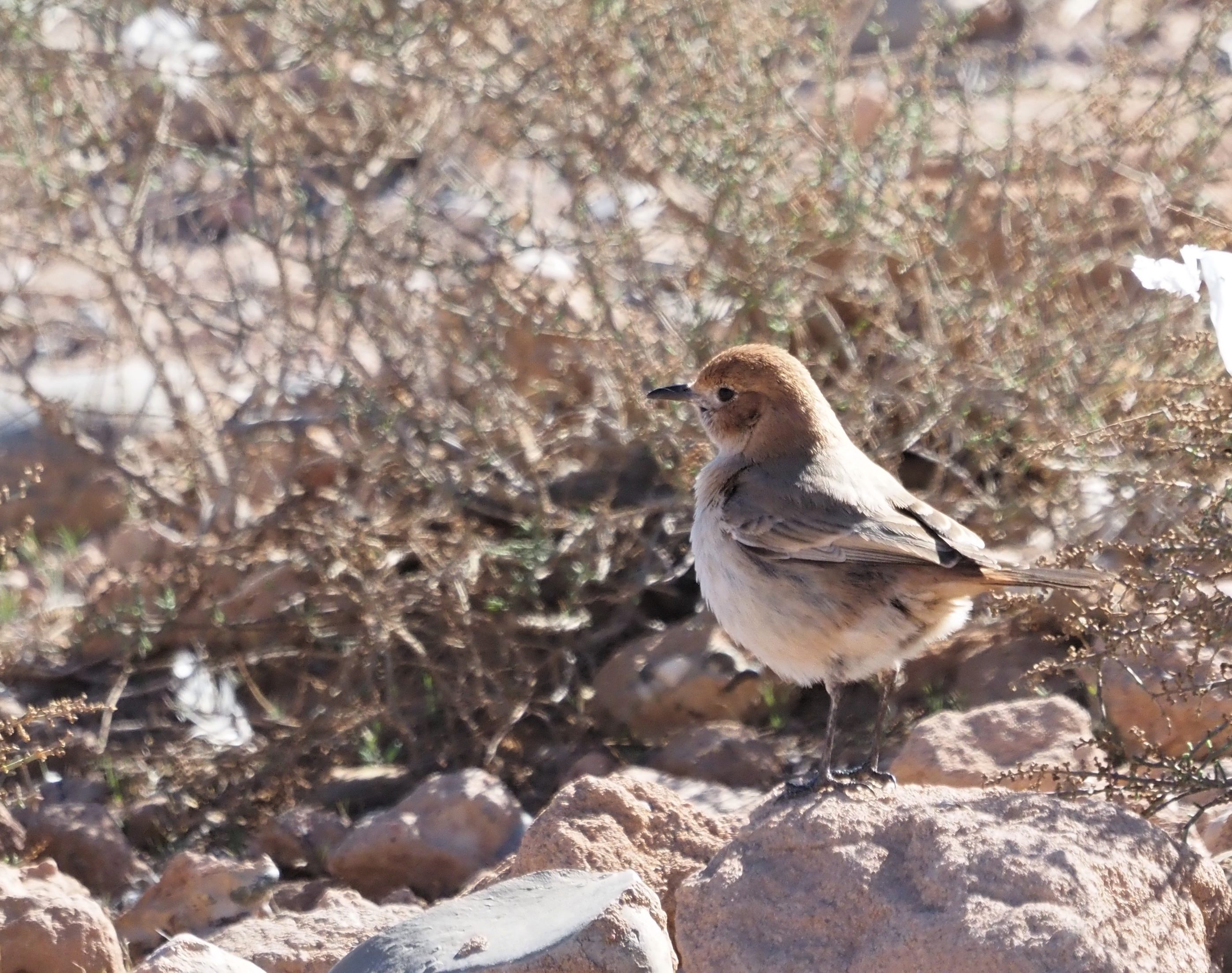
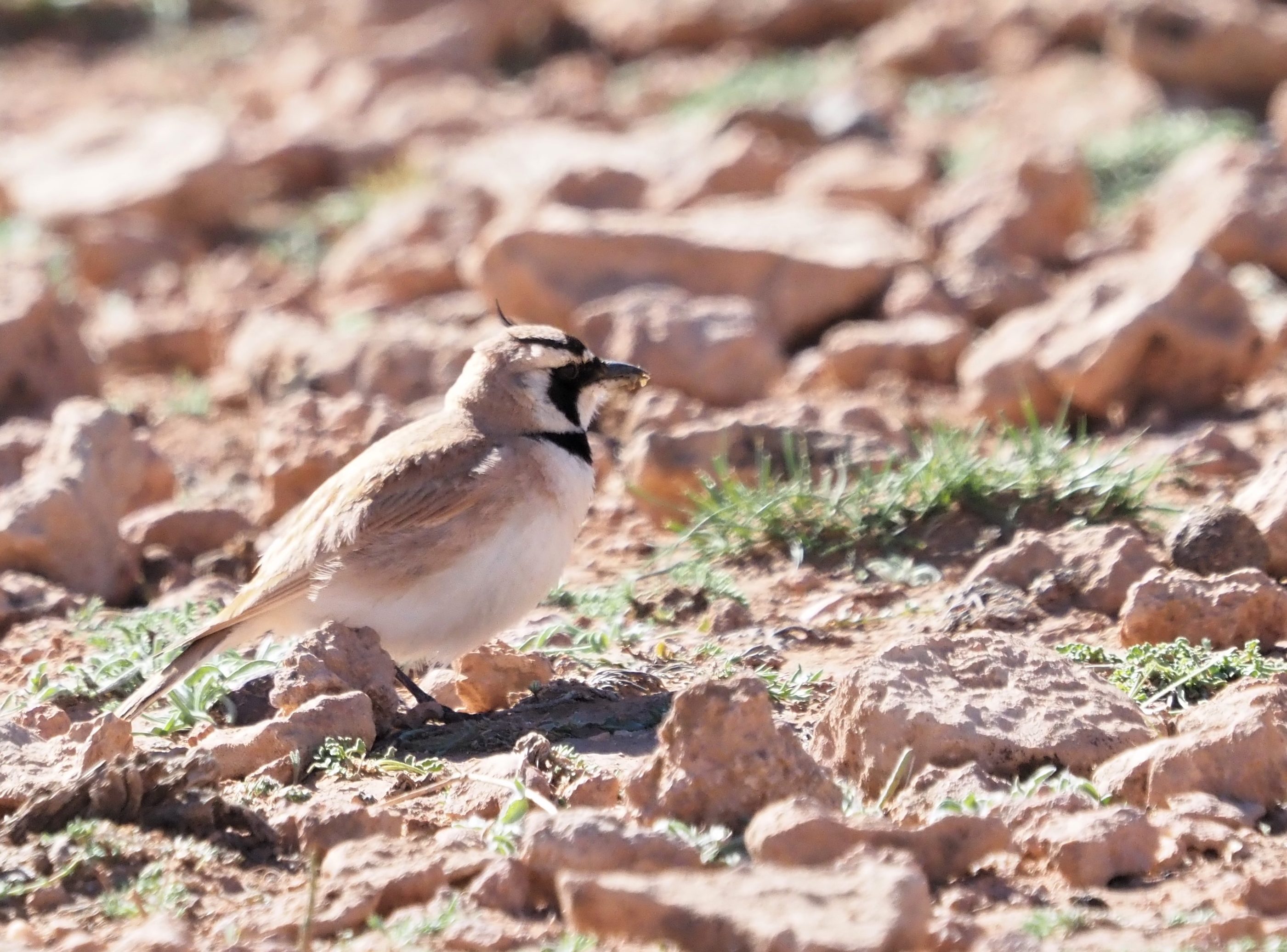
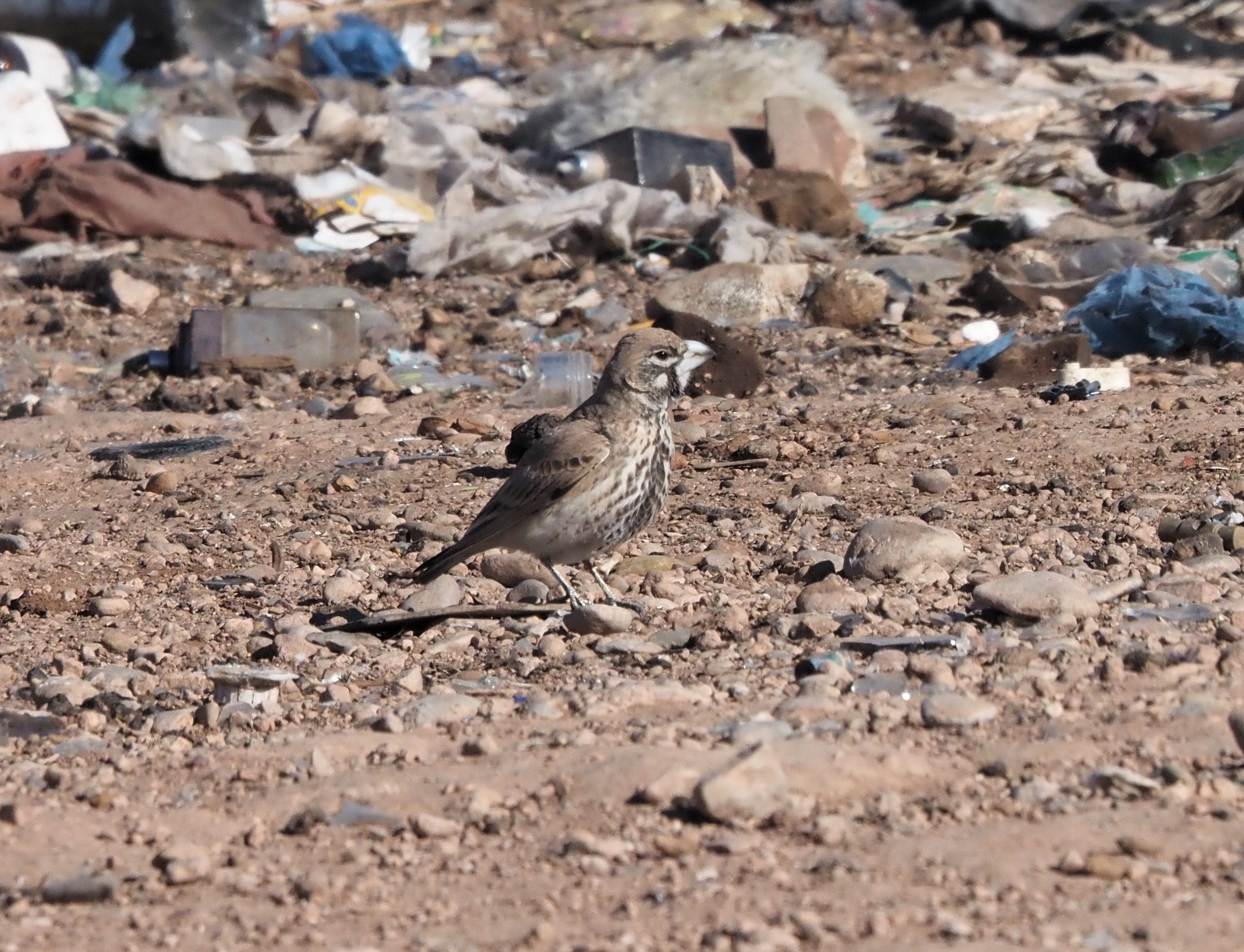

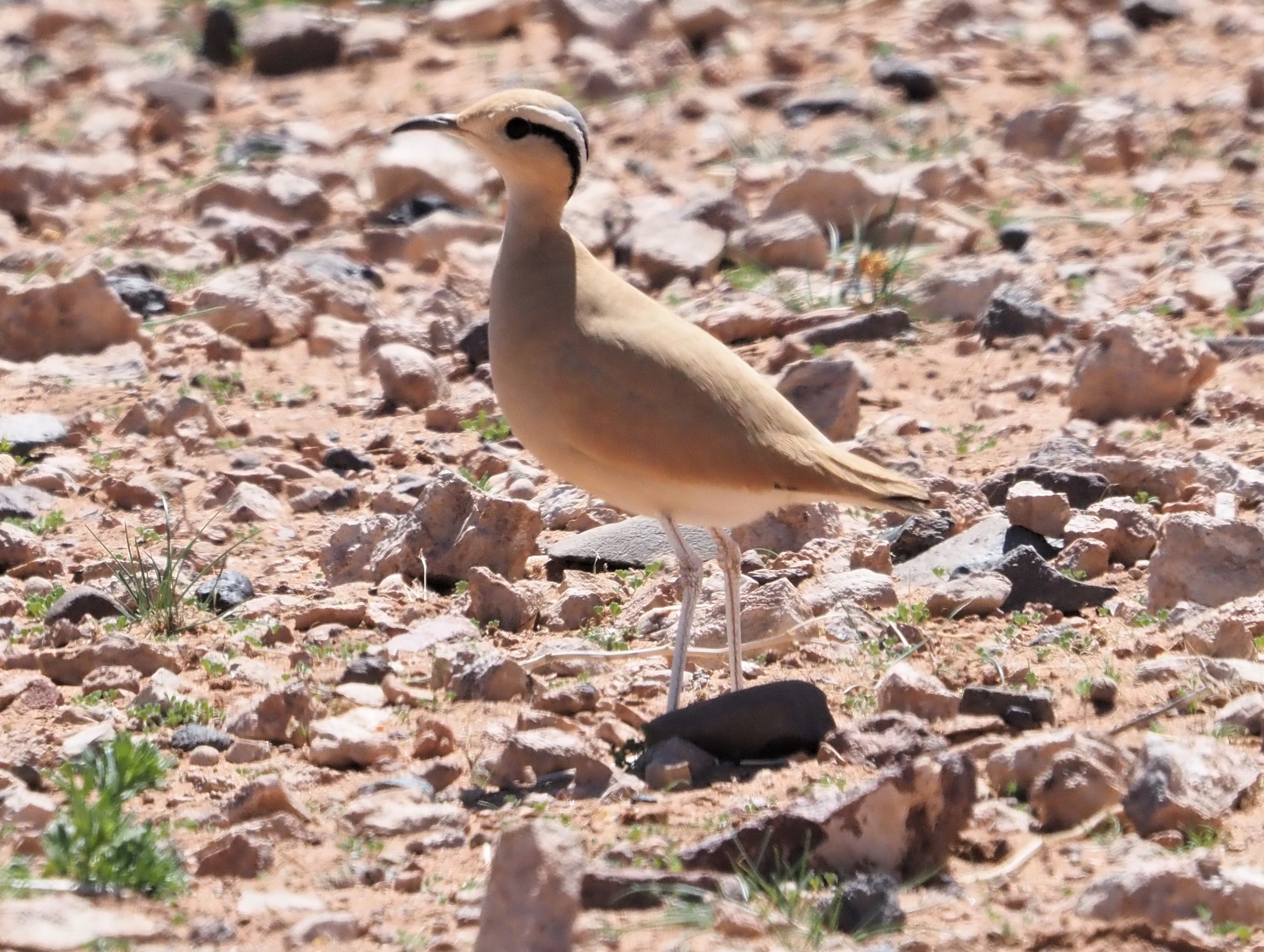

Back to our accommodation, we enjoyed a nice lunch and some rest before going to explore a different location. The ondulations around Boulmane produces a number of canyons and we spent some time exploring of them. It didn’t take long before we got the firsts specialties, and Desert Wheatears, Trumpeter Finches and Desert Larks showed really well before enjoying a nice pair of the very scarce and elusive Maghreb Wheatear while moving in the barren slope. This is another Maghreb endemic, only known form a thin stripe crossing Morocco, Algeria & Tunisia and formerly considered conspecific with Mourning Wheatear, a Levant specialty. Atlas Buzzard and Common Kestrels were also noted here, and we also had some views on a roosting Pharaon Eagle Owl that, unfortunately, was really deep inside a hole and never came out enough to provide the group with a full view.
The last stop of the day was quite a change of ambient. Driving up the very scenic Gorge du Dades, with its many wonderful Kashbahs and colourful dressed women, we arrived to a small cliff. Just arrived we had a fast and interesting bird spectacle in front us: 2 Peregrine Falcons being moved by a much smaller, longer tailed, Barbary Falcon! The Peregrines looked like the owners of the cliff at the moment, as we even saw the pair passing food to each other. The Barbary Falcon, higher at all times, disappeared beyond the cliff. We waited for some time to have better views on the Barbary Falcon, and a showy Blue Rock Thrush and some Booted Eagles moving up the valley helped us to have a good entertainment. The Barbary Falcon showed a pair of times more in the sky, and we decided to end the afternoon soon enough to have some rest in the accommodation before dinner.
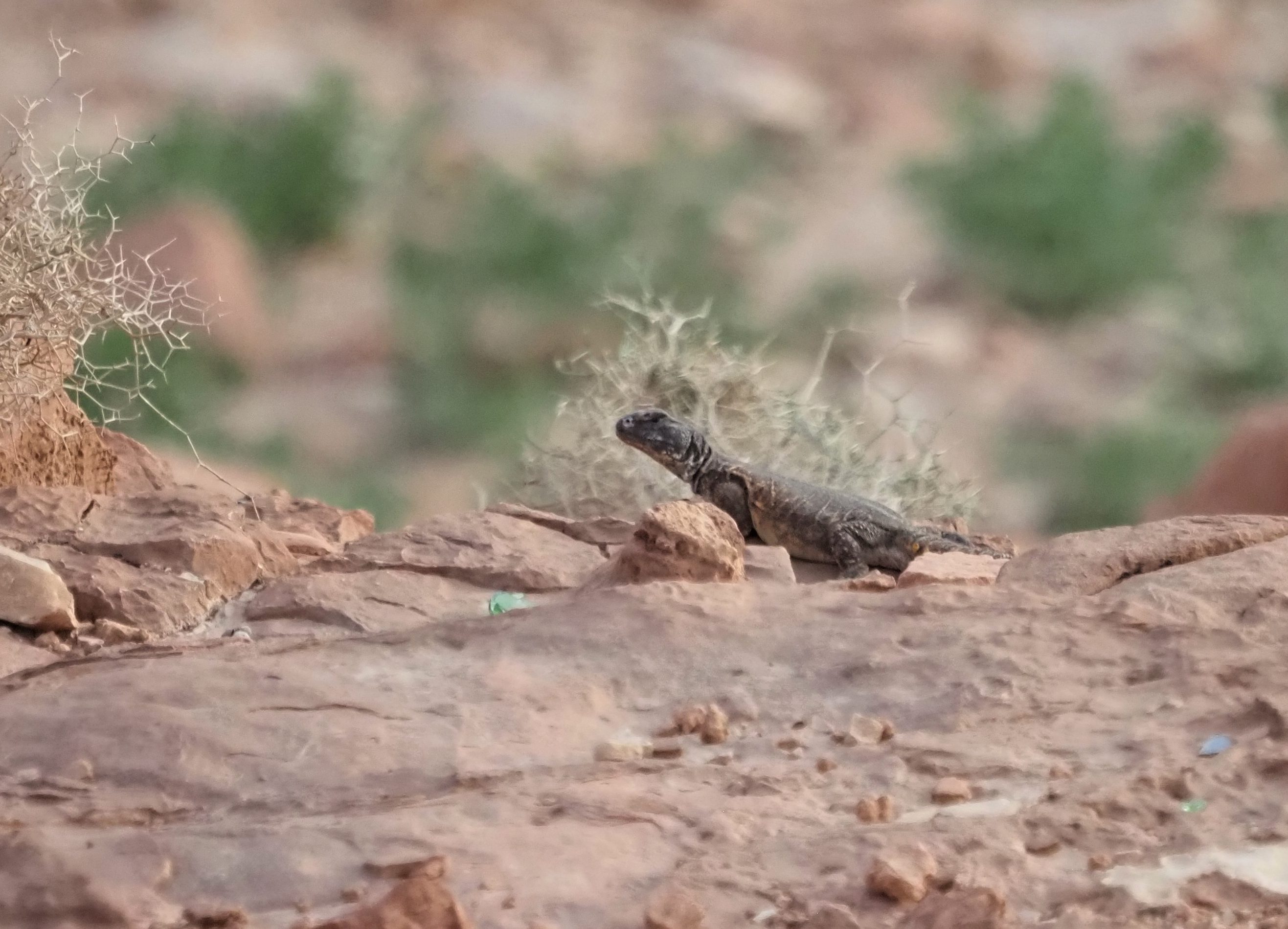
Day 6. A transtional day between the high plateaus around Boulmane du Dades and the sandy deserts around Merzouga. The morning was sunny but fresh, with a cold air coming down from the Atlas that made our first stop really comfortable. The first stop in the morning was to look for the rather scarce Saharan Scrub Warbler, an endemic form of the Levant Scrub Warbler living in the sparse bushlands along wadis but also up in the slopes in the Northern slope of the Atlas mountains.
Our short walk produced almost immediately the first Bar-tailed Larks of the trip as well as confiding Mediterranean Short-toed Larks. Walking along the wadi we had a good set of the typical species living in this kind of habitats including Spectacled Warbler, Trumpeter Finches and Deser Wheatear plus migratory species such as Western Subalpine Warbler and Northern Wheatear. After a good while scanning the area we were starting to think about going somewhere else when Rob found 2 Scrub Warblers feeding at close range from us.
The birds, as typical on them, where feeding really low in the base of the small scrubs, making very difficult to see them for longer than a pair of seconds. Jumping from bush to bush, the Scrub Warblers moved really fast along the wadi, covering a lot of ground, flying from bush to bush but also “running” in the sand like tiny Babblers and typically standing by the base of a bush, tail-ups, before disappearing inside the grass.
After enjoying the Scrub Warblers for 20 minutes we started to come to the van, but we still had a pair of sights: First, a Cream-coloured Courser that flew over us while calling and secondly, a pair of Bar-tailed Larks showing quite close, as tame as ever.

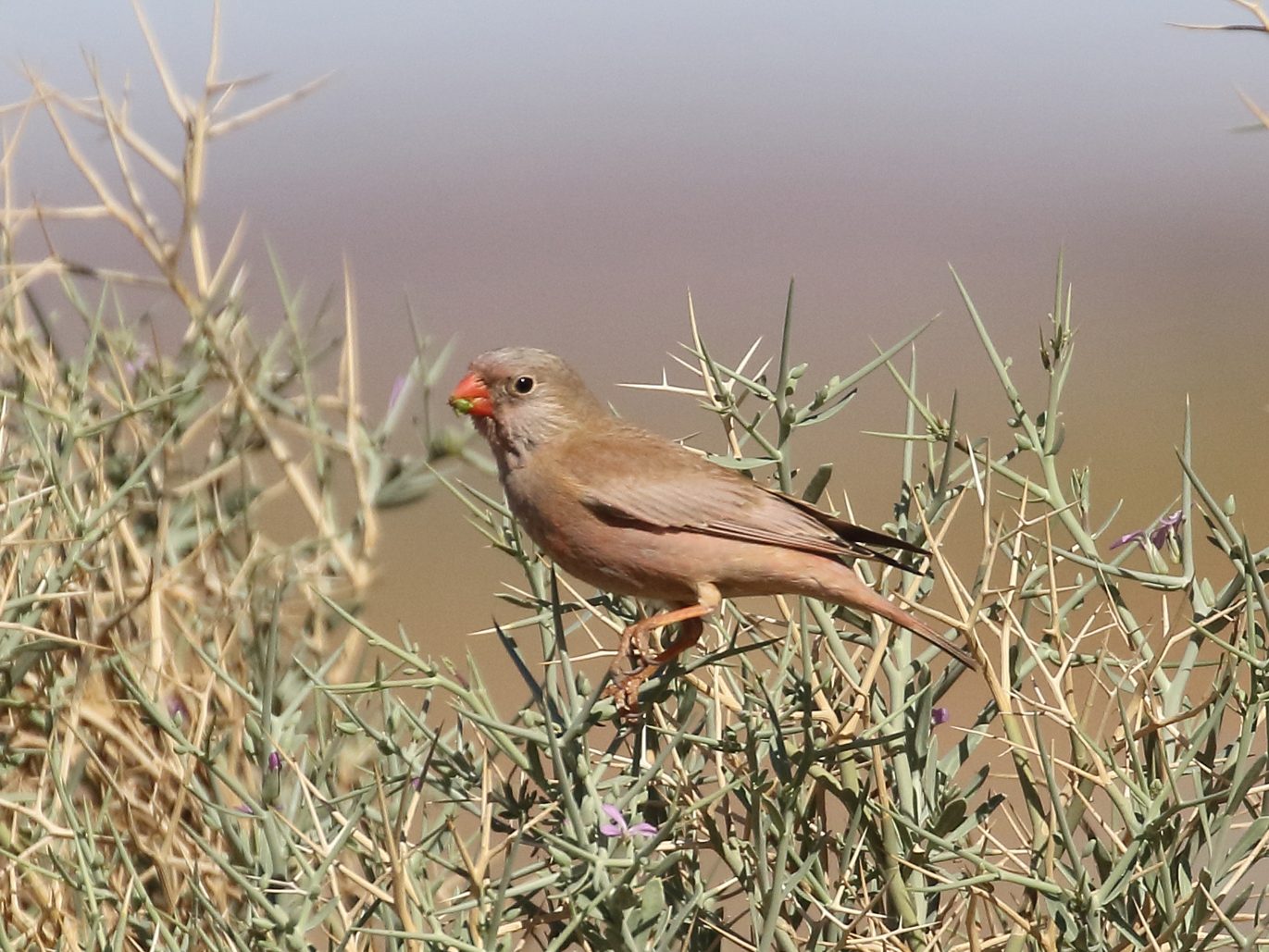

From here we drove into a close restaurant and enjoy some shade. After lunch, we covered the short distance to our next accommodation with a number of stops in the way. Desert Grey Shrike was added to our list, as well as Brown-necked Raven. A longer stop to explore another wadi produced good views on the common list of migratory species including Willow, Western Subalpine & Western Bonelli’s Warblers, but also Black-eared Wheatear & Western Orphean Warbler.
The last stop of the day was devoted to the typical habitat of Greater Hoopoe Lark, and it didn’t take long before having the first sight for trip of this really appreciated species: 2 individuals, one of them singing and displaying in flight. A great sight to end another wonderful day!
Day 7. This day was devoted to explore the desert around Merzouga. This is a quite well known place for the many desert specialties living around. It was a sunny and pleasant day all through, with a fresh brise during most of the day.
Our first stop was around a water hole where we did stop to look for Sandgrouses coming to drink water from several kilometers away. We didn’t have to wait long since even before our arrival some flocks of Crowned Sandgrouses were already on the ground, waiting for the best moment to approach the water. After some waiting, we id enjoy several flocks of both Crowned and Spotted Sandgrouses coming to the plain around the small pond, and soon their calls and wing beats filled up the ambient. This was a wonderful moment, and all the tour participants were really happy to see 80+ Crowned & 40+ Spotted Sandgrouses coming to drink water! We left the area with still more Sandgrouses coming to drink water, but we had to move to our next stop, a nomadic camp nearby where a pair of Desert Sparrow was nesting.
It was time for us to enjoy some tea, and our patience in the camp was rewarded with amazing views on a Desert Sparrow male that was feeding right the tents! The bird was really tame and allowed excellent images. Here, a Greater Hoopoe Lark also appeared, and provided the group with the best views on this species along the trip. White-crowned Black Wheatear, Common Redstart and Brown-necked Raven were also noted here.
Leaving this sandy patch of the desert, we drove North into a large wady where a nomad was waiting for us. His expertise was needed to find the next target of the trip, and after a short walk in the wady he brought directly to one Egyptian Nightjar that was roosting in the wadi. Respecting a good distance from the bird, we all enjoyed a wonderful view in this magnificent bird! A further walk around the dunes was also productive and Greater Hoopoe Larks and Desert Wheatears showed well, but the very best of the walk was to find a nice African Desert Warbler doing its way around the sparse vegetation of the wadi! This is again a desert specialist, and one of the most tricky birds to find in Morocco!
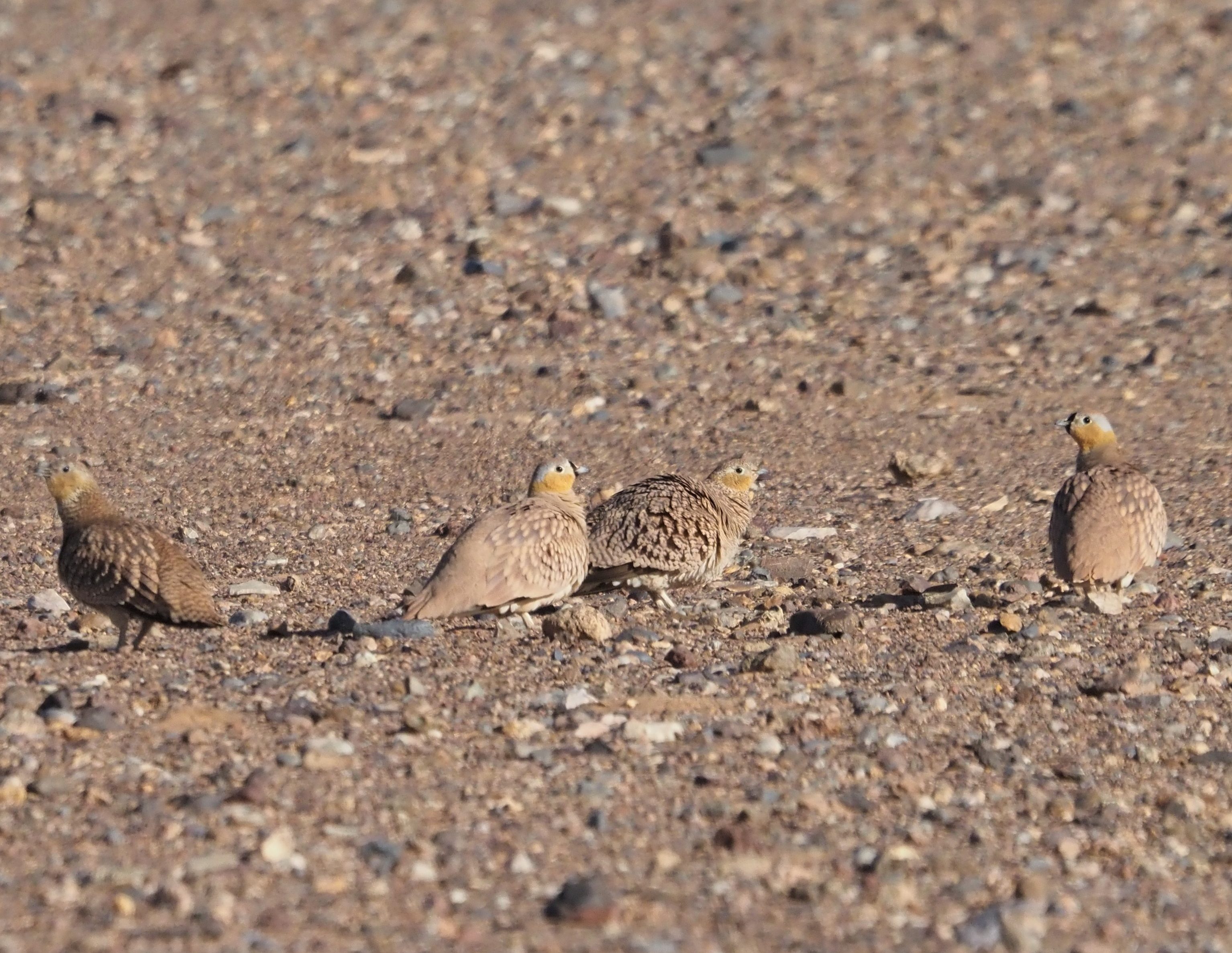

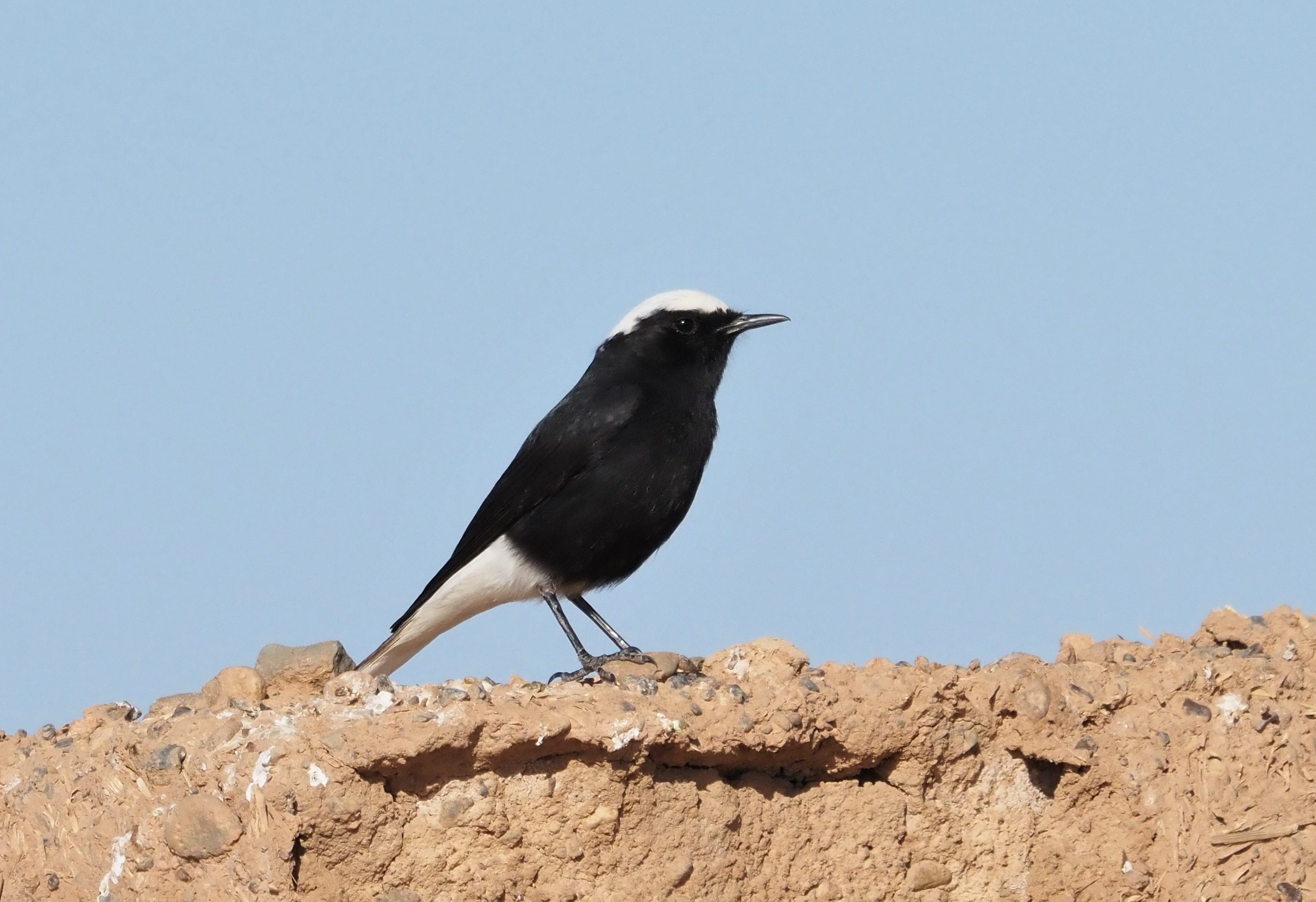
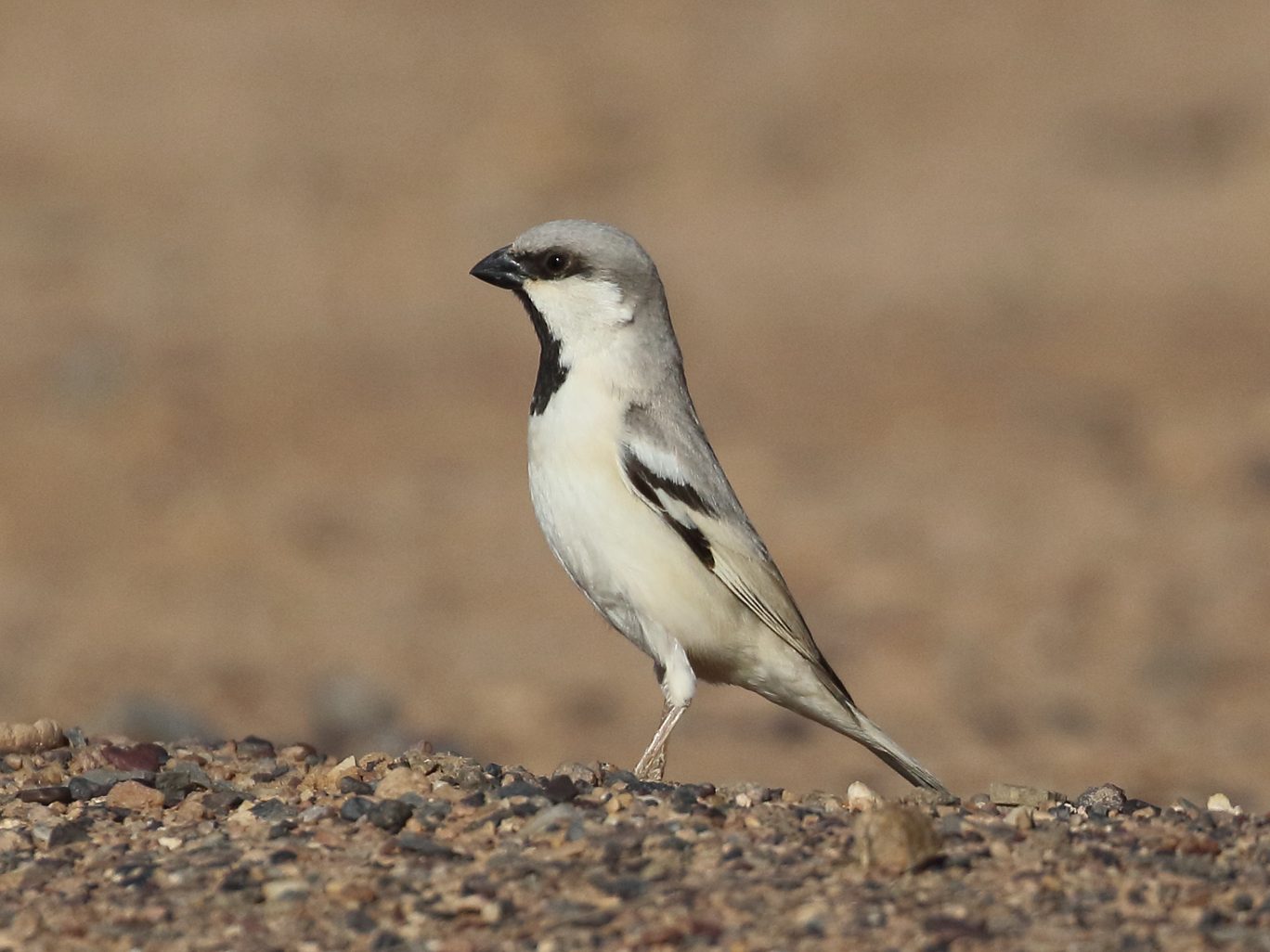
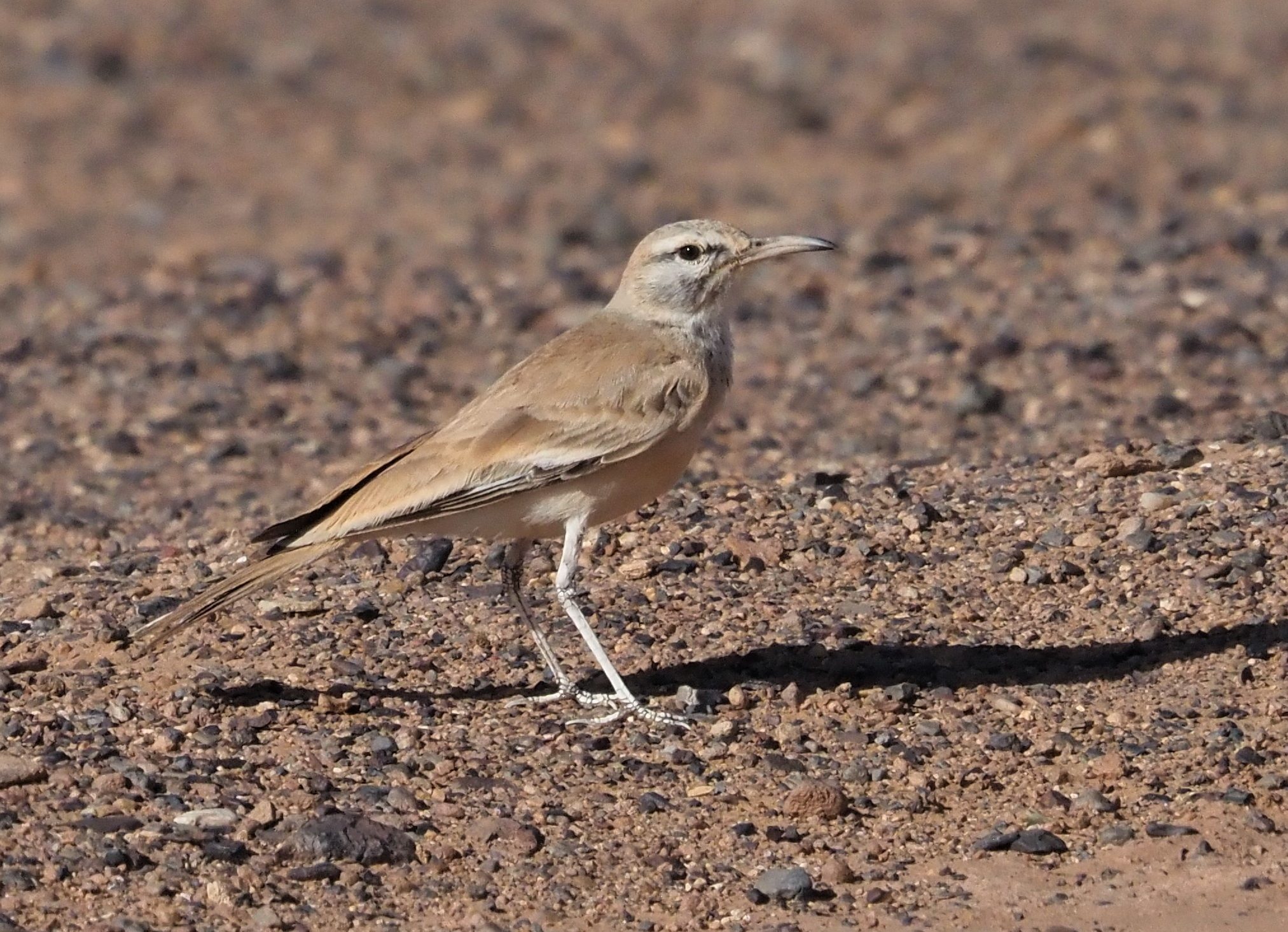
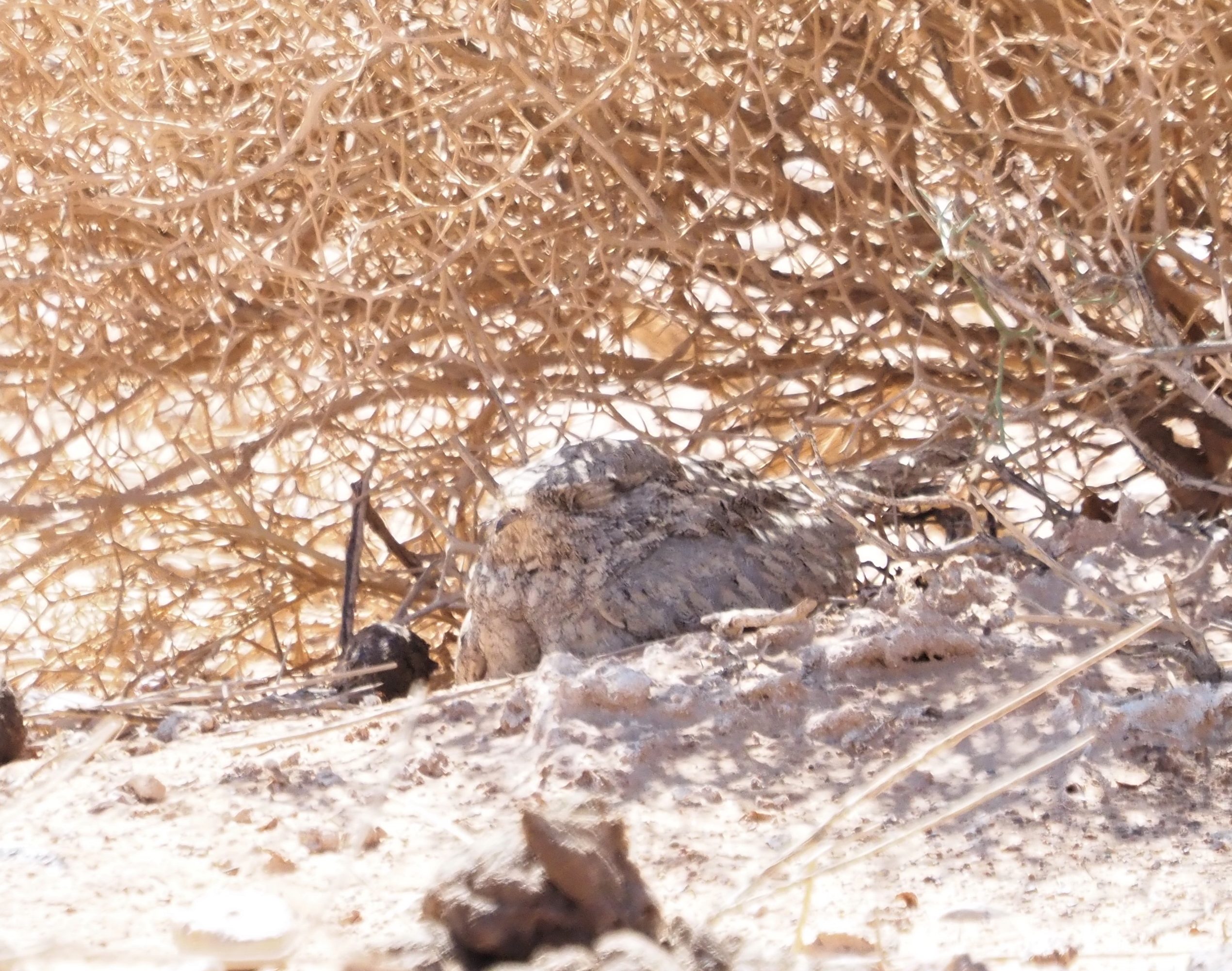
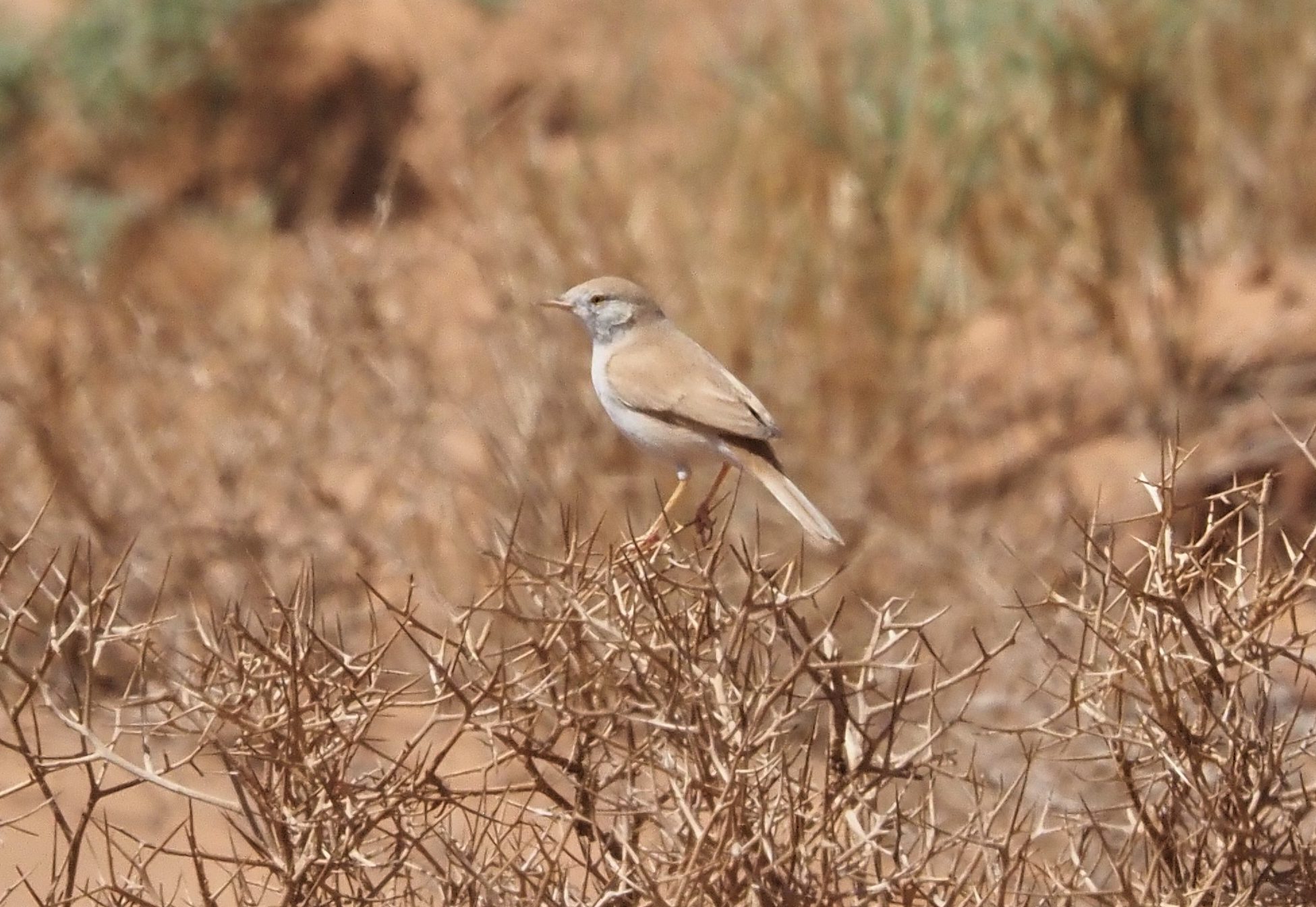
Happy after such a great views we went for some rest and lunch in a close accommodation. But in our way we had to do another stop: During the morning we had several flocks of Black Kites migrating North over the desert along with some Western Marsh Harriers, but one of these flocks was joined by a lovely Egyptian Vulture, the only one for the trip!
Our picnic was really tasty and, walking around the accommodation we enjoy it not only Western Subalpine Warblers & other common migratory birds but also Woodchat Shrike, Spanish Sparrow, Blue-cheeked Bee-eaters and a really tame Eastern Olivaceous Warbler (Iduna pallida reiseri) that posed really well for all the tour participants!
After lunch we tried to improve our rather scarce list of raptors but we were unlucky and the very last stop of the day was devoted to explore a small crop area with some water. Here we had several Western Yellow Wagtails of different races (nominal, Spanish, Italian & British) but also Maghreb Larks, Eurasian Crag Martin, Red-rumped Swallow, Little Ringed Plover, Wood Sandpiper, Northern Grey Shrike, Meadow Pipit, Greater Short-toed Lark and Ruddy Shelduck to name a few!
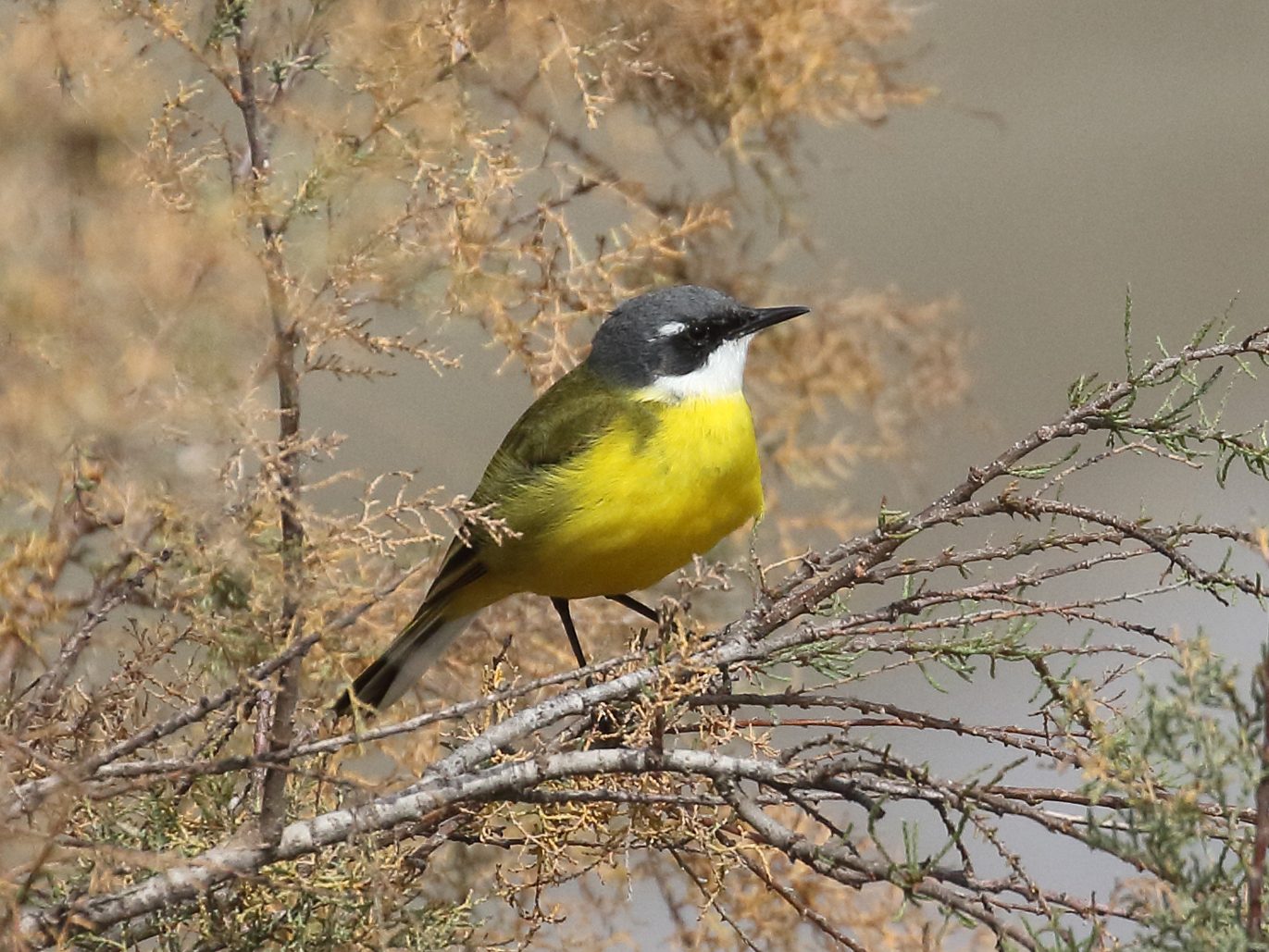
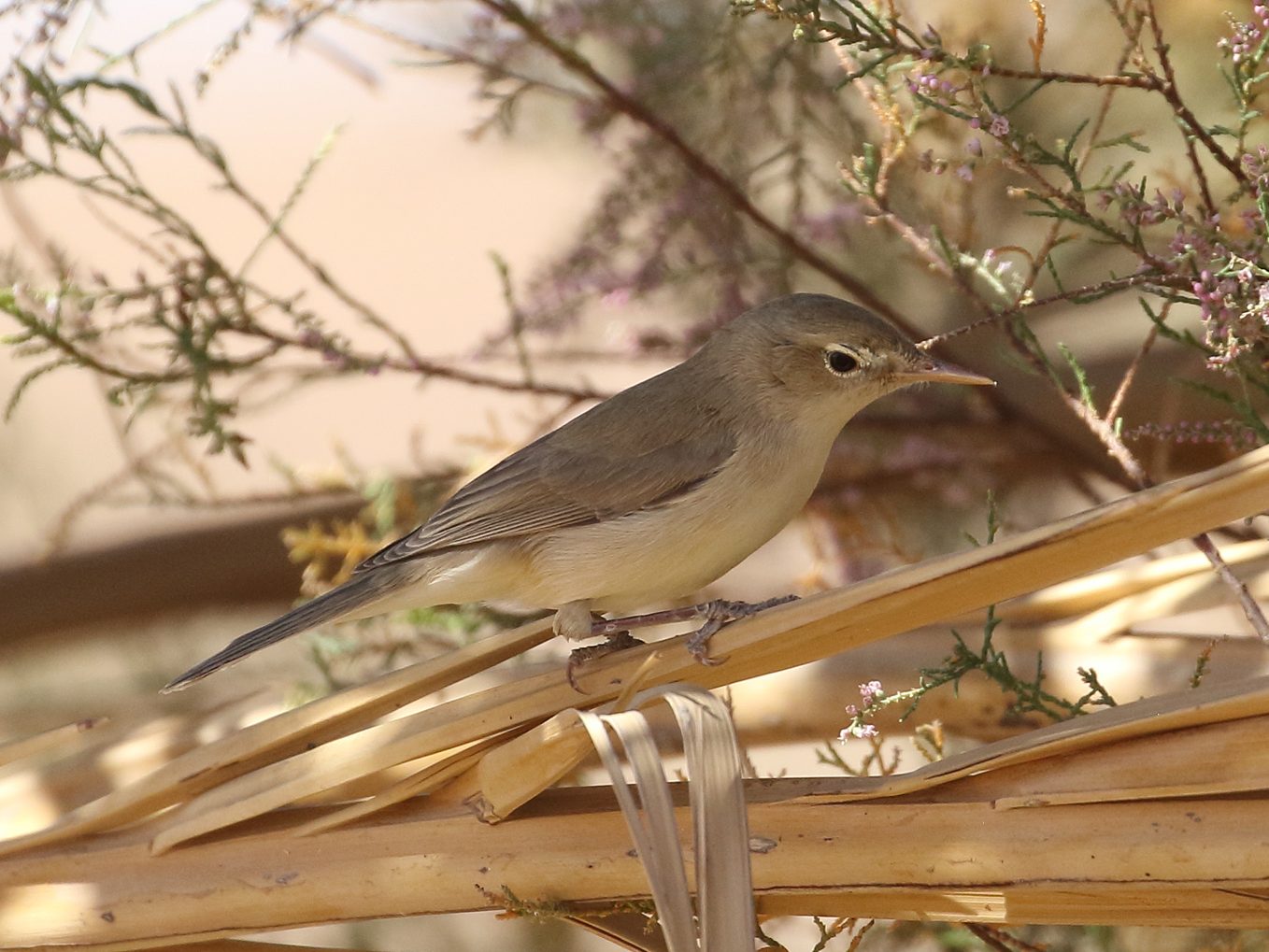

Day 8. Due to the long drought and the terrible water management in the areas, the once famous and extremelly famous Merzouga lake is now gone. With the lake gone, this morning we explored a pair of corners in search of a good migratory action.
Firstly we explored the grounds of a nearby hotel, where we got more common migratory birds plus Western Orphean Warbler, Eastern Olivaceous Warbler, Common Whitethroat, European Bee-eater and Woodchat Shrike. From here we drove the short distance to the major palm grove in the area, where we had double figures of Common Whitethroat and Willow Warblers while Garden Warbler, European Turtle Dove and Bluethroat were added to the list. Here we enjoyed also great views on a family group of Fulvous Babbler, including an aberrant individual! This species, anyway, was already seen for some of the tour participants in a pre-dawn walk around our accommodation and shortly the day before in the desert!
In the afternoon the group agreed to do a good exploration some tens of kilometers South from Merzouga. This area, not really explored by most birdwatchers, provided us with a quite pristine landscapes, as it once was Merzouga, along with excellent numbers of Desert, Bar-tailed & Greater Hoopoe Larks. Here Carmine found a lovely flock of 8 Crowned Sandgrouses that provided the group with gorgeous views and good photo chances!
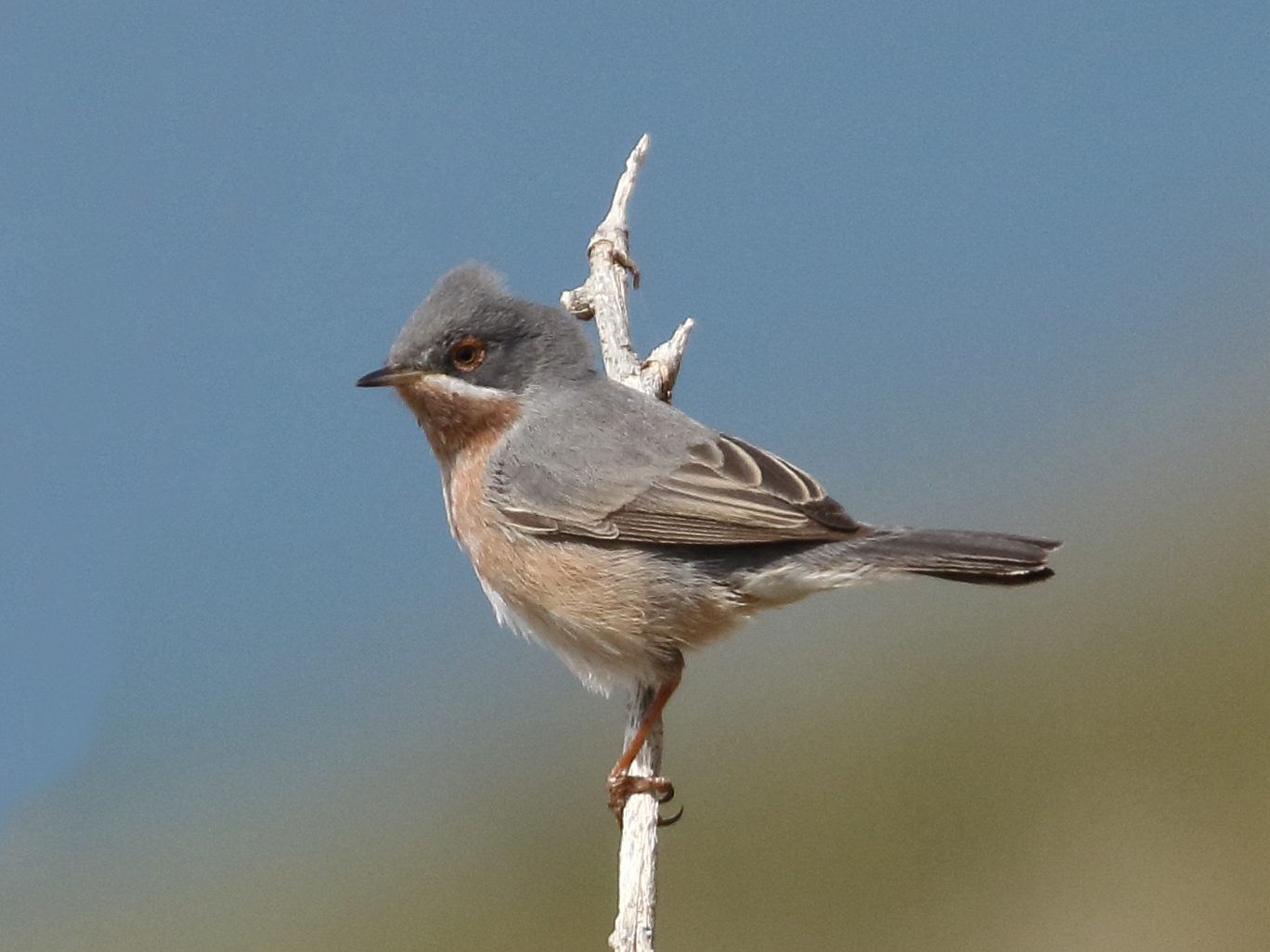
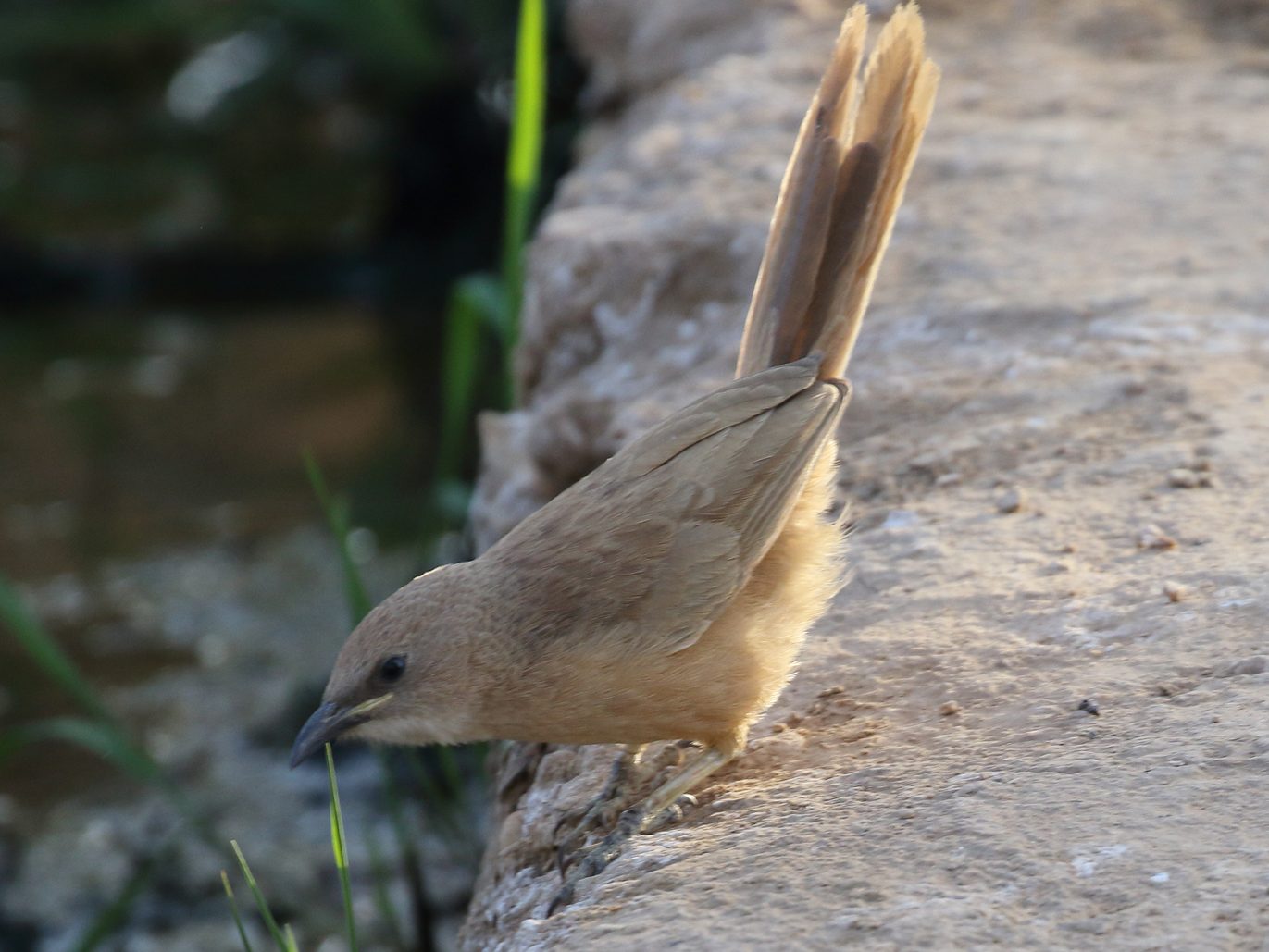


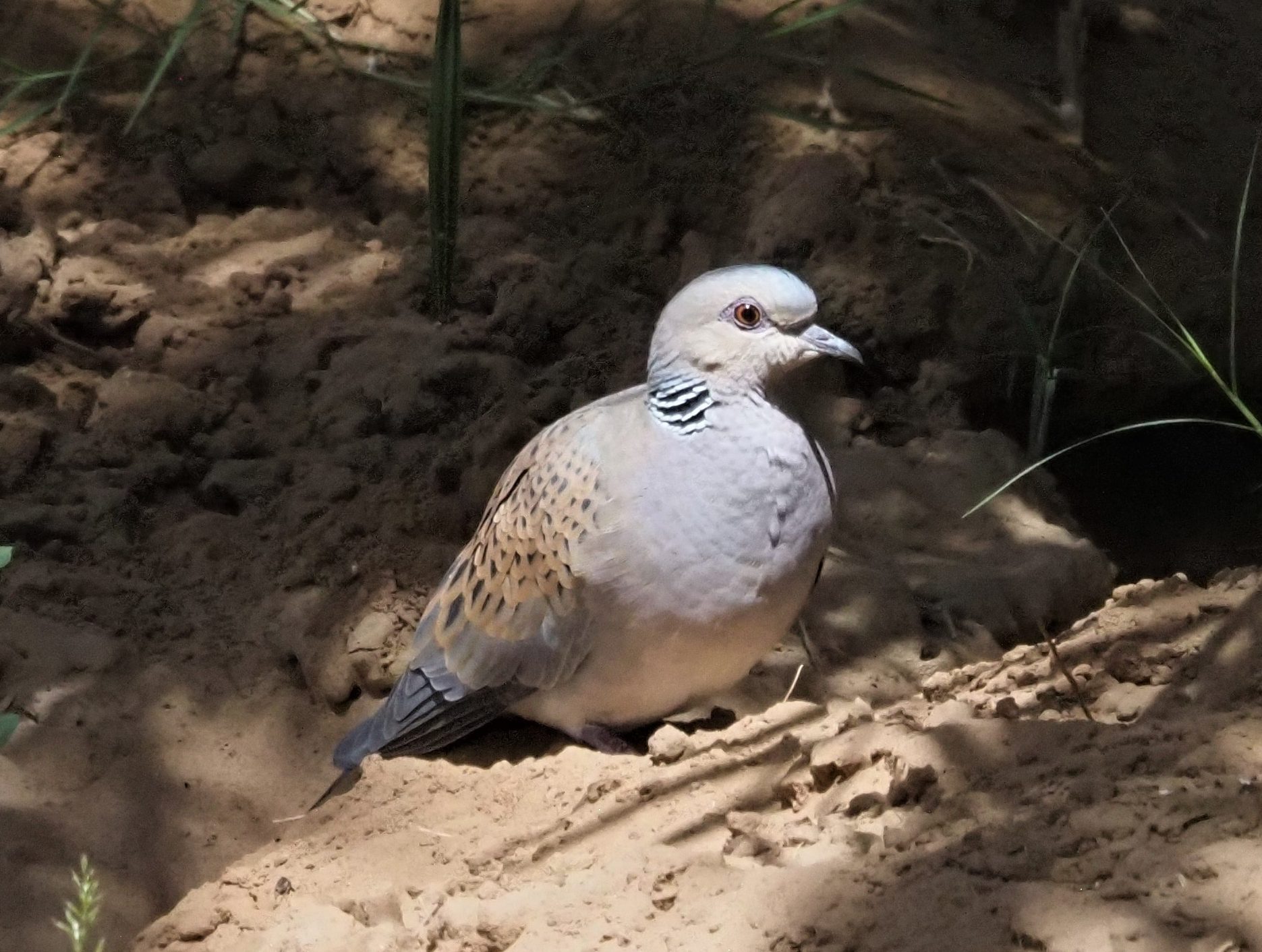
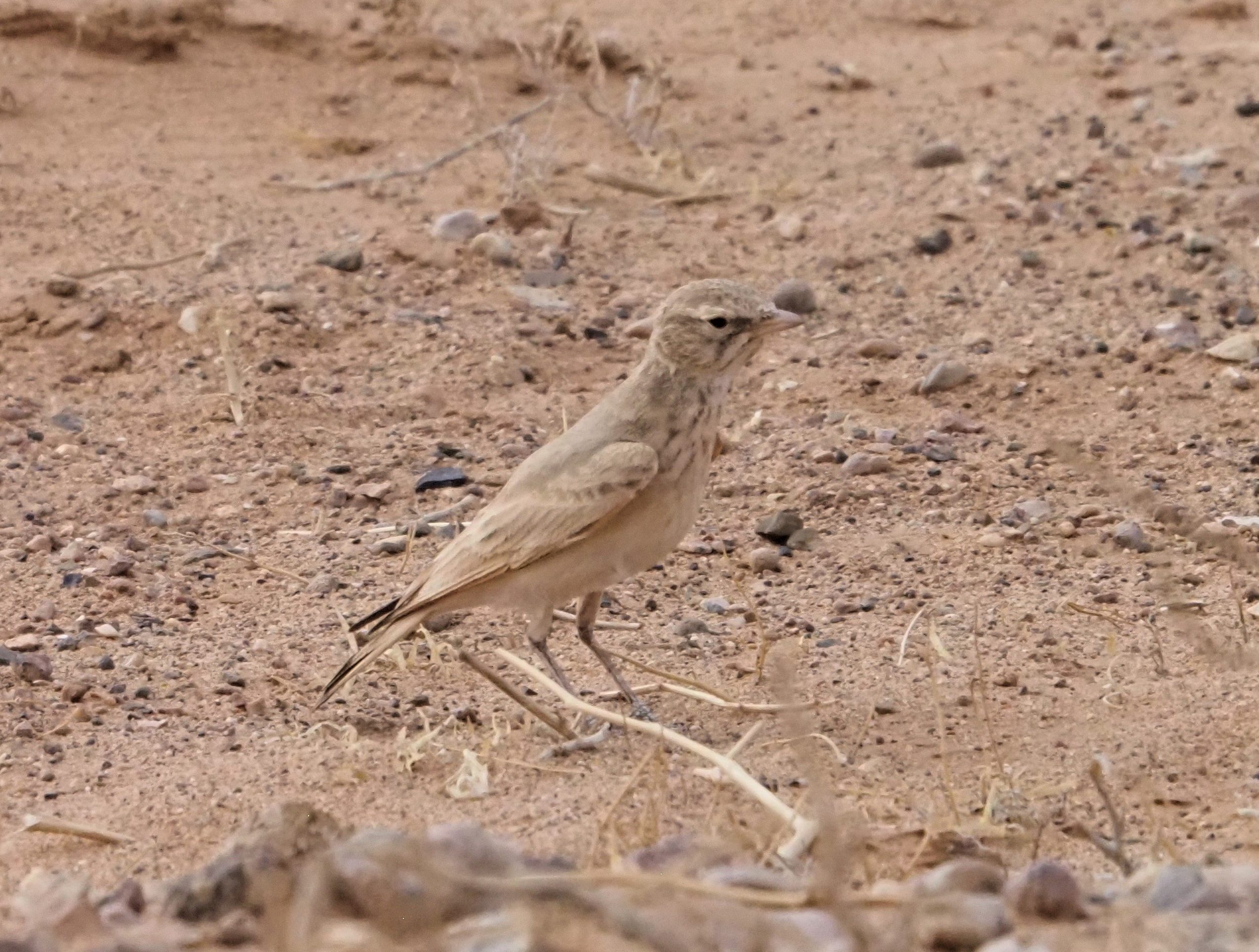

Day 9. Transition day from Merzouga to the endless steppe land around Saïda, home of the shy and always challenging Dupont’s Lark! Before leaving the desert, we had a pair of stops. After breakfast we covered a short distance to explore the grounds of another accommodation. Here we didn’t have a lot of time as the owners were not happy with our visit and we were invited to immediatly leave the gardens. A real pity since within 5 minutes we already had enjoyed some good sights including obliging Common Nightingale, Eurasian Hoopoe and Dylan found the 1st Eurasian Wryneck of the trip! Unfortunately it was no chance to try a dialogue with the owners and we left what can be considered as the less welcoming ksar in Southern Morocco!
Around Erfoud we still have a last stop before our long drive North. Our search of a proper pond finally was successful and we found a small pond (we could not consider it as a “proper” one) where we got the only 3 Sedge Warblers of trip along with Eurasian Reed Warbler, Eastern Olivaceous Warbler, Western Bonelli’s Warbler, Bluethroat and, nearby, another Wryneck.
After some driving a lunch stop, we arrive to Zaïda in a windy afternoon. Birding was extremelly poor and we only got some distant Temminck’s Larks, a pair of Desert Wheatears and 1 Black-eared Wheatear. But swords were up for the next morning and try to find the famous “ghost bird”!
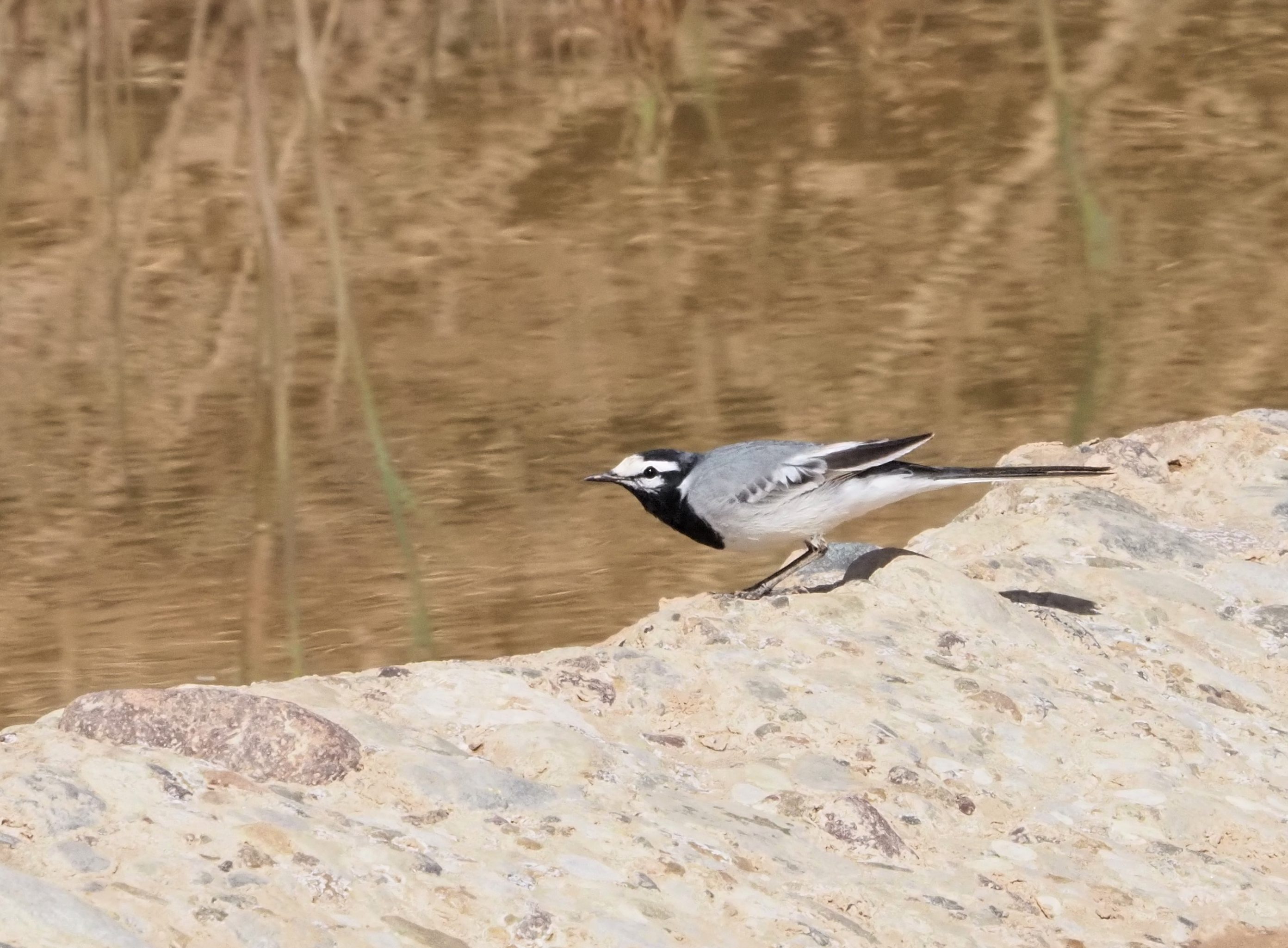
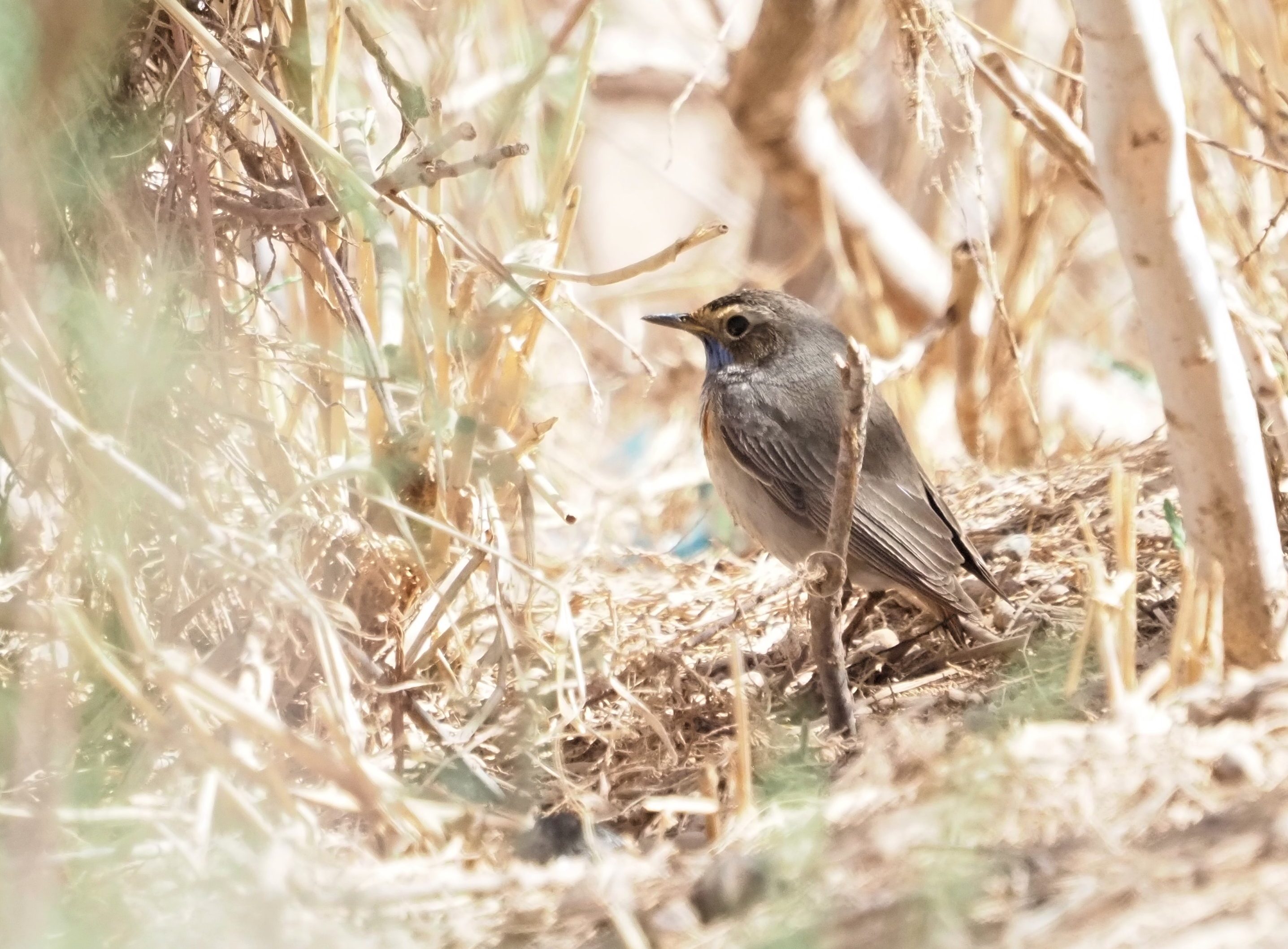


Day 10. After a nice breakfast we covered the few miles from our accommodation to the place where I saw Dupont’s Larks in 2022. We arrived to place, that was free of wind and had a really pleasant temperature. Bird activity was intense and it didn’t take long before we built a good list including several Mediterranean Short-toed Larks, Thekla Larks, Desert & Red-rumped Wheatears, Trumpeter Finches and a good number of Temminck’s Larks. Driving only 150 metres away from where we got the bird in 2022, Mark found a rather large lark running about 50 metres away from the van, not far from a pair of Desert Wheatears. The bird disappeared behind some bush and, after some wait, a lovely Dupont’s Lark appeared in front of us! The bird was quite far away so we all jumped out of the vans to allow everybody to get good views on the bird, that was feeding in the area for some time before climbing in a bush and sing for some time to replay a distant male. After a pair of minutes, the bird flew off, singing in flight, and flying a long distance away, disappearing beyond the small ondulations of the terrain!
All the tour participants were really excited as the confidence about finding this very difficult bird is always low! We the best was still to come. Decided to get better views, we moved a bit away to check another corner. No birds were listened there so we decided to come back to the area where we first seen the Dupont’s Lark. In the way, 2 Cream-coloured Coursers, Thick-billed Larks & some Black-bellied Sandgrouses were all seen! Back to place we were enjoying some Mediterranean Short-toed Larks displaying ten metres away from the van when a gorgeous Dupont’s Lark just appeared only a few metres to our left! The bird was really relaxed and was feeding around the tussocks of grass. The excitement inside the vehicles was huge, hundreds of images were taken and most of the tour participants decided to go out to enjoy this incredible sight from even closer (but never leaving the road!).

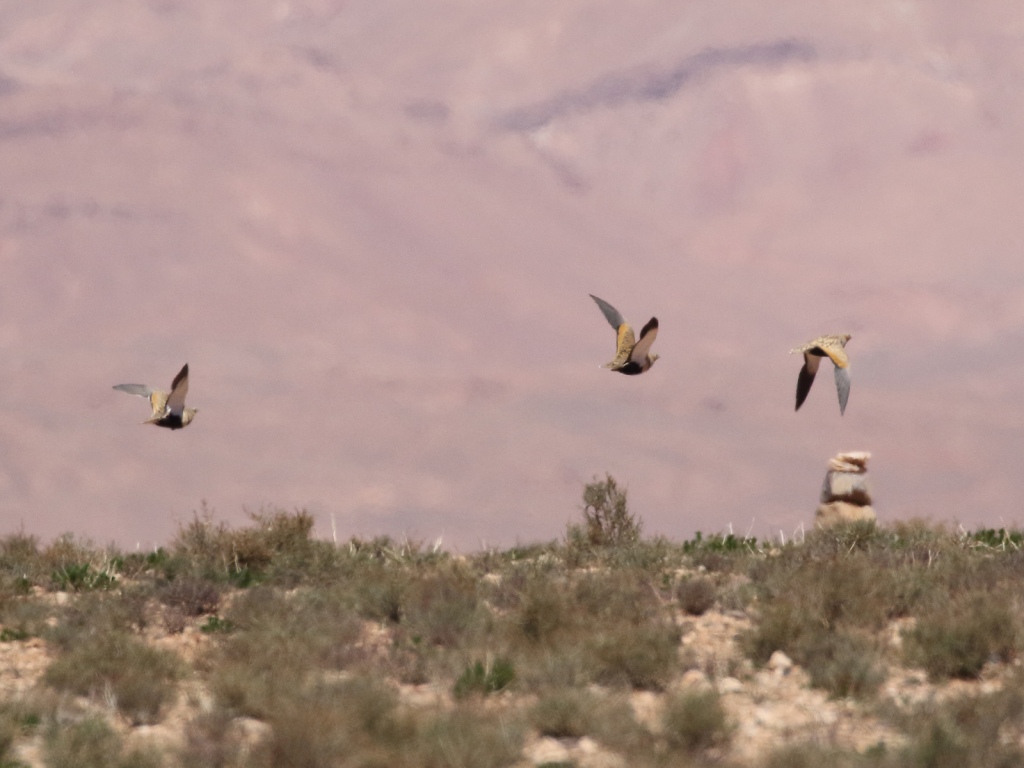
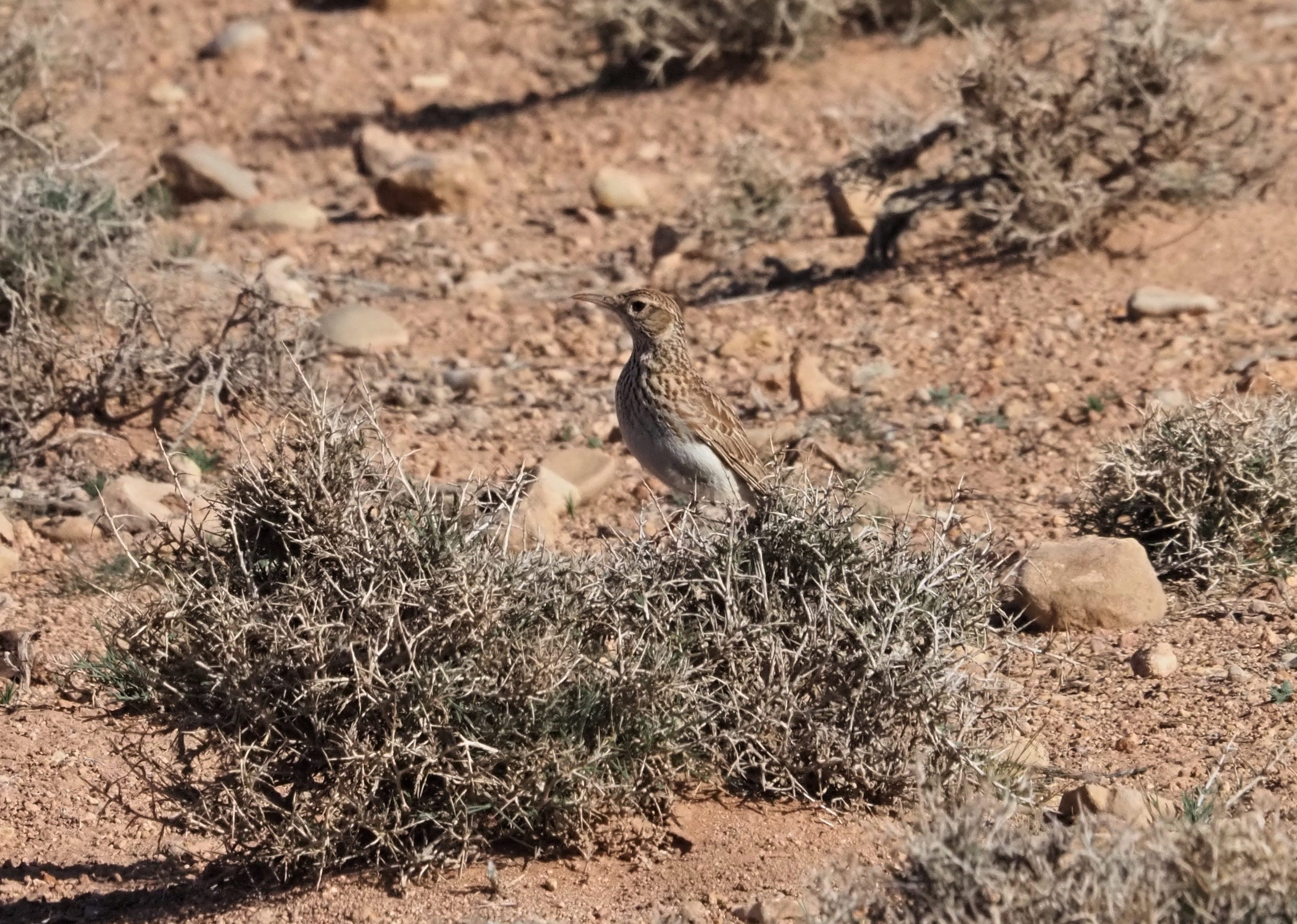
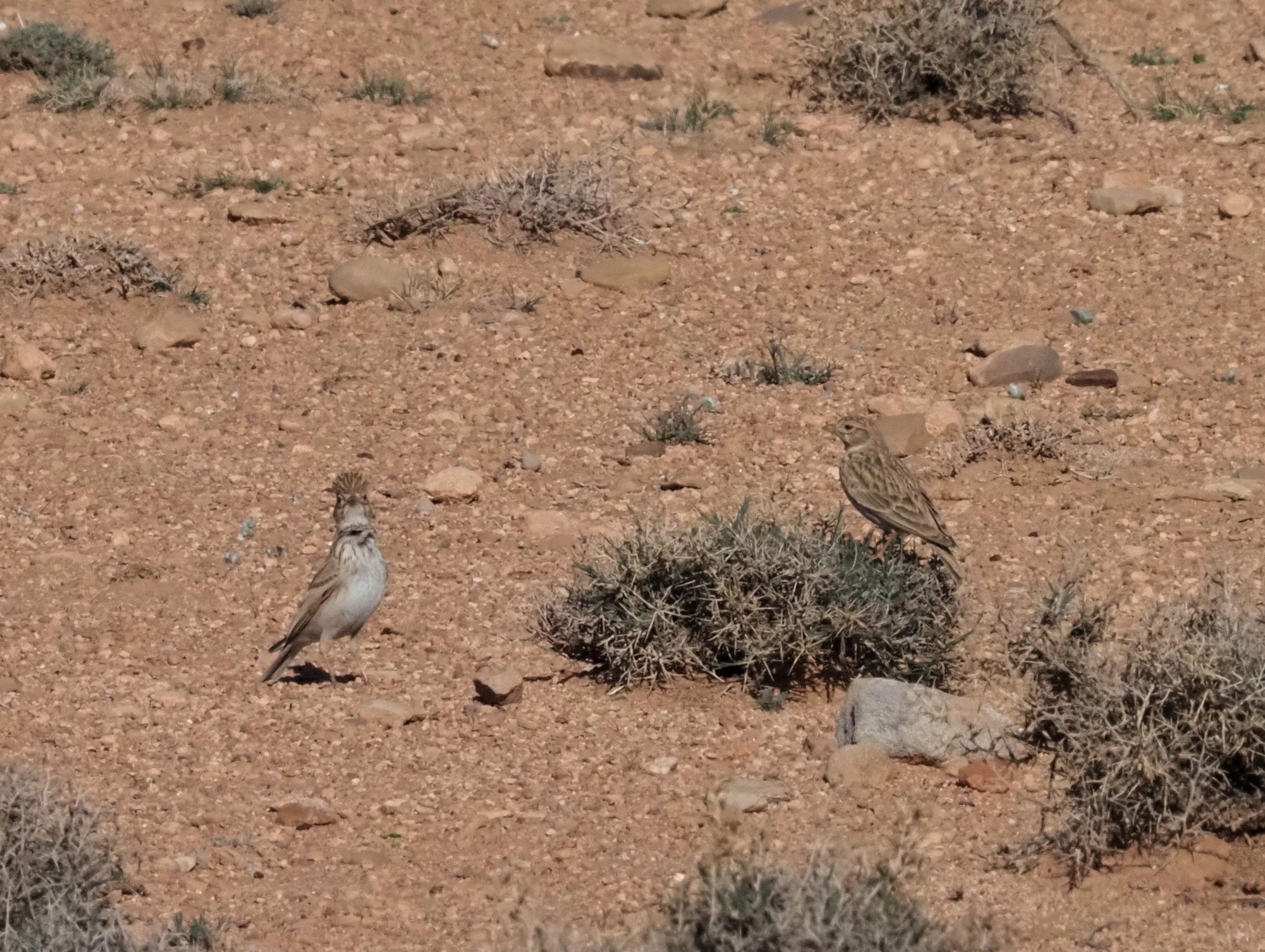
Extremelly happy after such a great views, we started the long transfer to Ouarzazate, where we had the last overnight of the tour. In the way, we still have time to stop and enjoy amazing views on a hatching female Lanner Falcon plus some other goodies including Fat Sand Rat, Desert Larks, Atlas Buzzard and a female Maghreb Wheatear.
At dust, a short stop in a river produced some nice views on Grey Wagtail, Booted Eagle and Cetti’s Warbler before a Barbary Falcon appeared in a fast raid to try to catch one of the Cattle Egrets around. A really nice way to end the day!
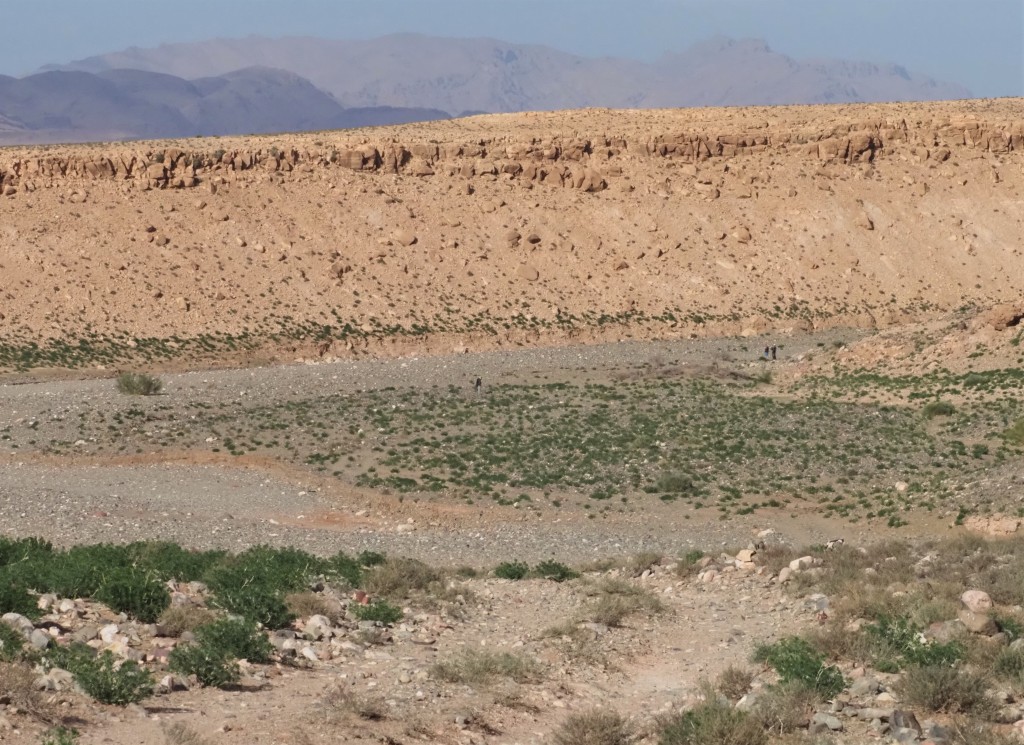
Day 11. Last day of this tour, one day longer than usual to include Dupont’s Lark in the itinerary. Before driving back to Marrakech by crossing the Atlas, we decided to have another go to the massive barrage South of Boulmane du Dades. This time the weather was clearly better, a calm, sunny and promising morning that was not really productive. A series of stops in the massive dump produced good views on migratory Black Storks and large flocks of Black Kites but little numbers of ducks in the lake.
But, when leaving one of the spots, Carmine found a pair of gorgeous Thick-billed Larks right next to the van that displayed long for us! Leaving the dump behind us, we still enjoyed close views on Little Ringed Plover by the road, and the very last birding stop still produced Little Swift, Common Nightingale, Melodious Warbler, Black-eared Wheatear and a singing Wryneck before we crossed the Atlas back to Marrakech, where we did arrive at mid afternoon, in time for everybody to reach their flights.
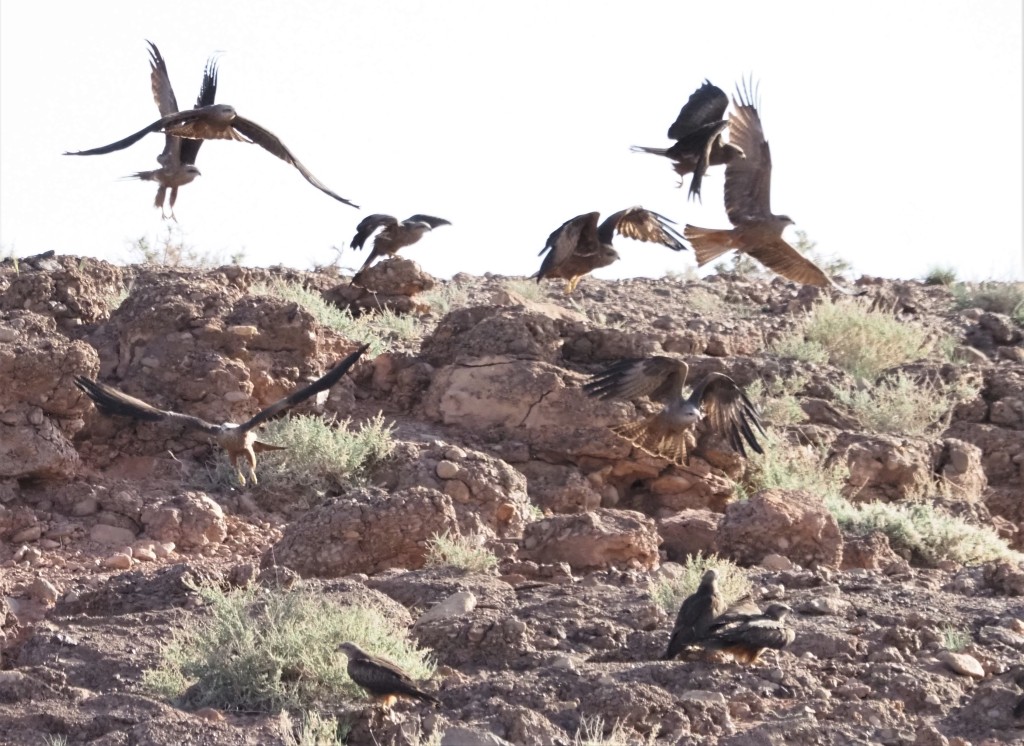
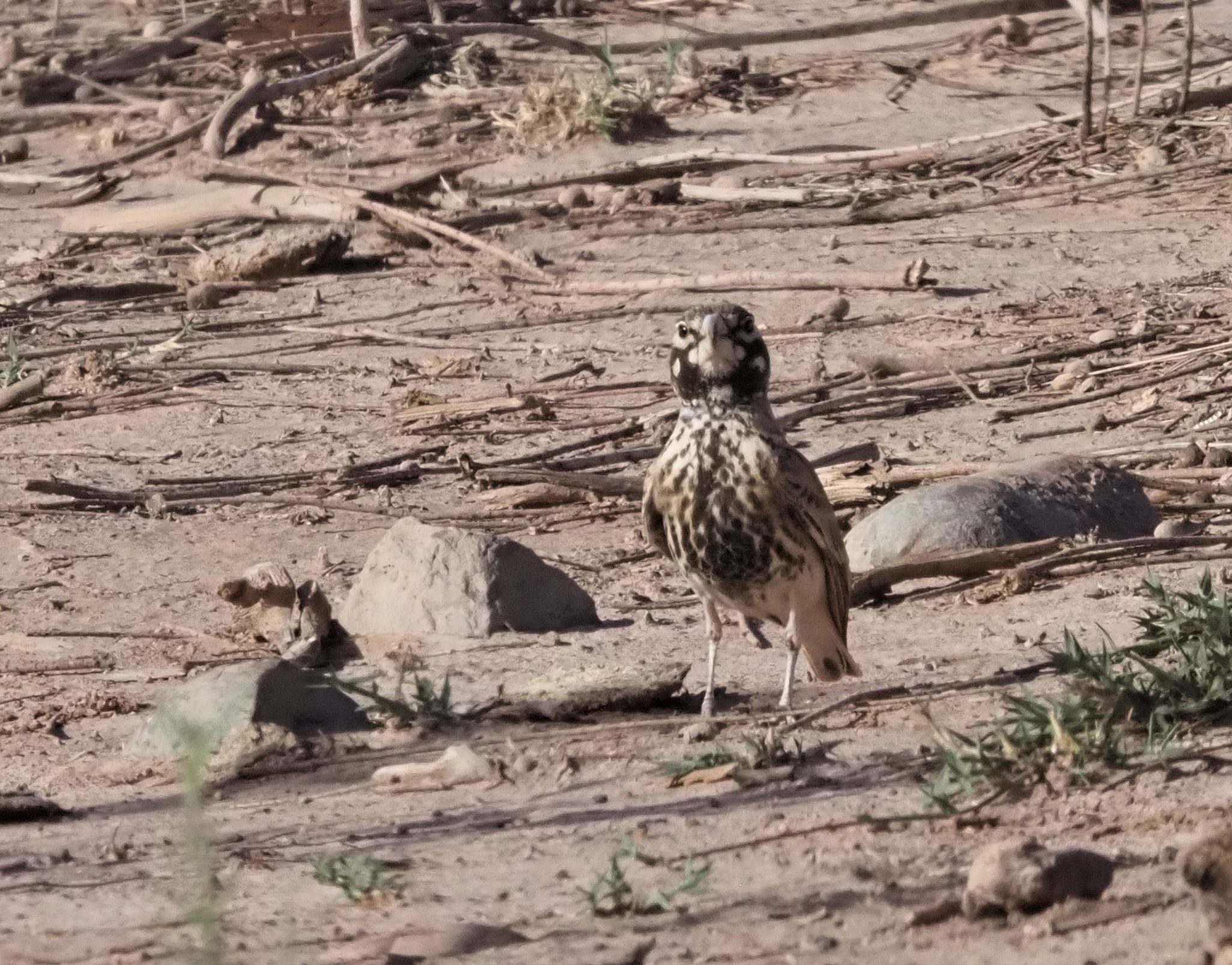
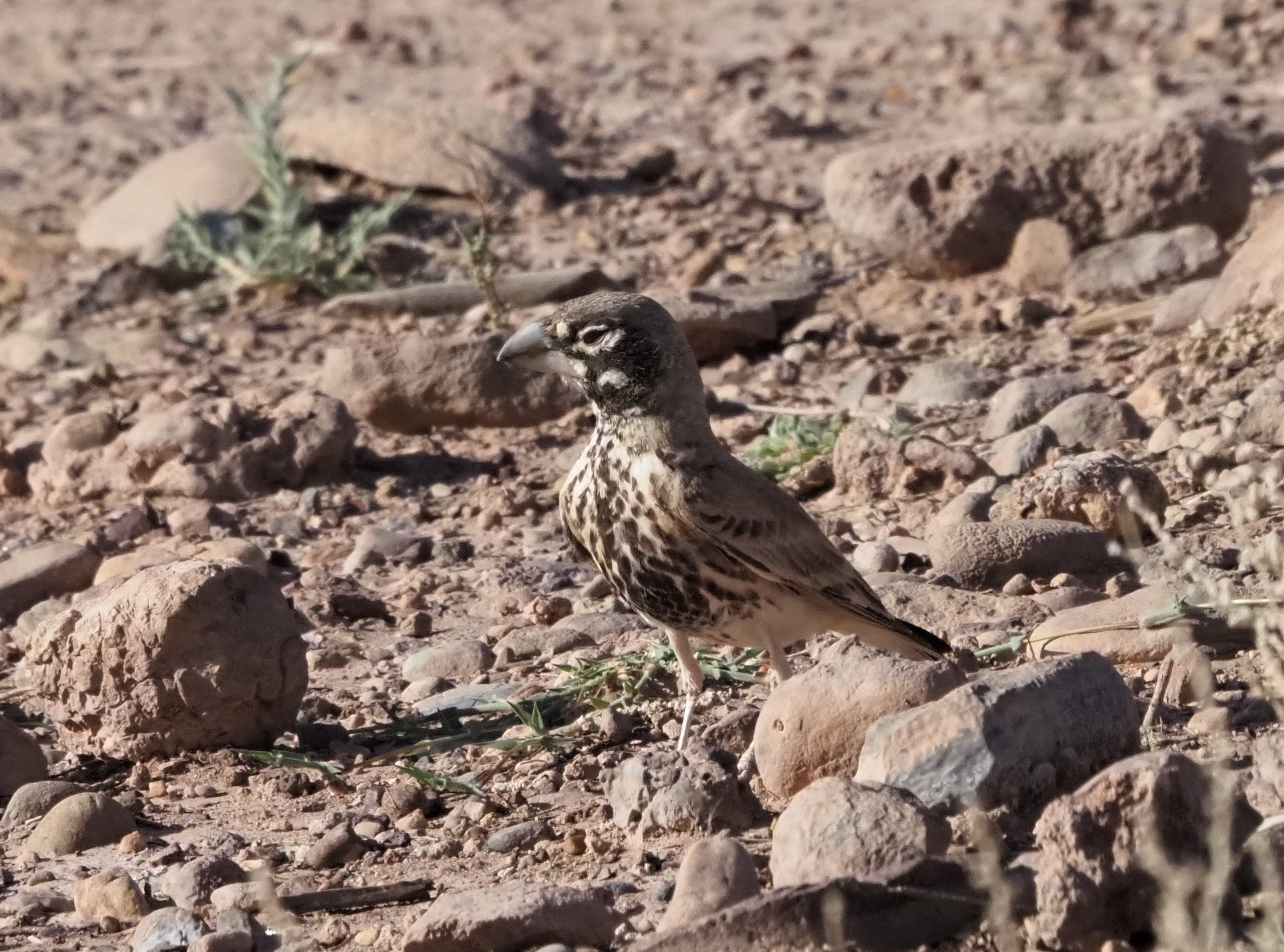
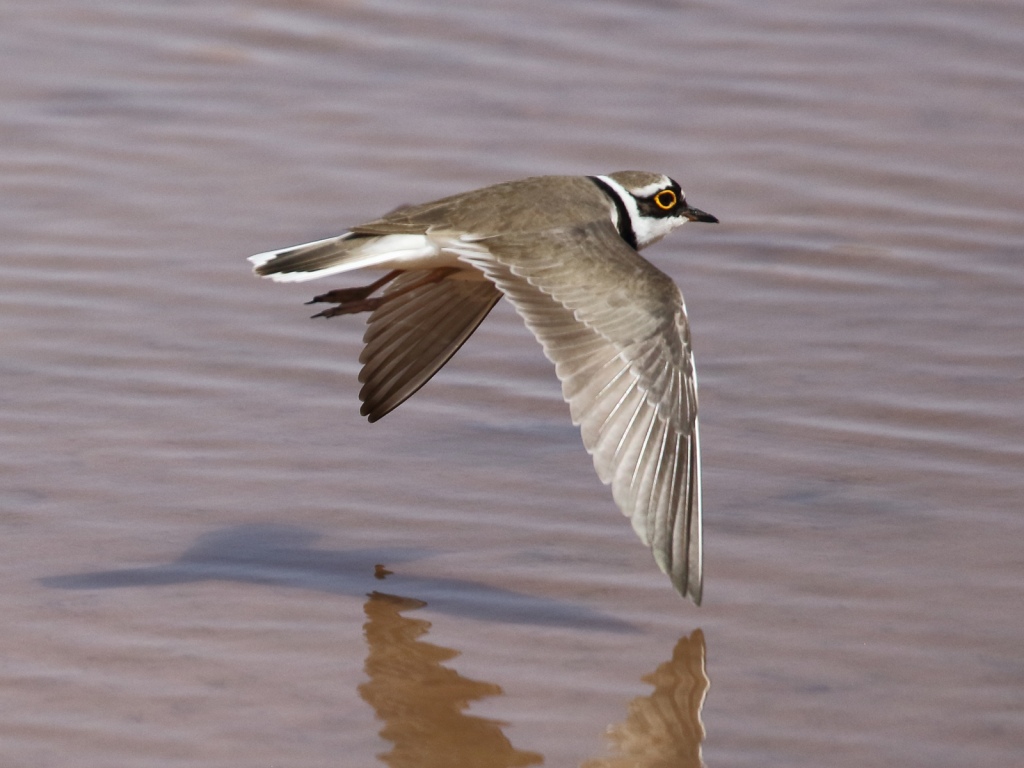
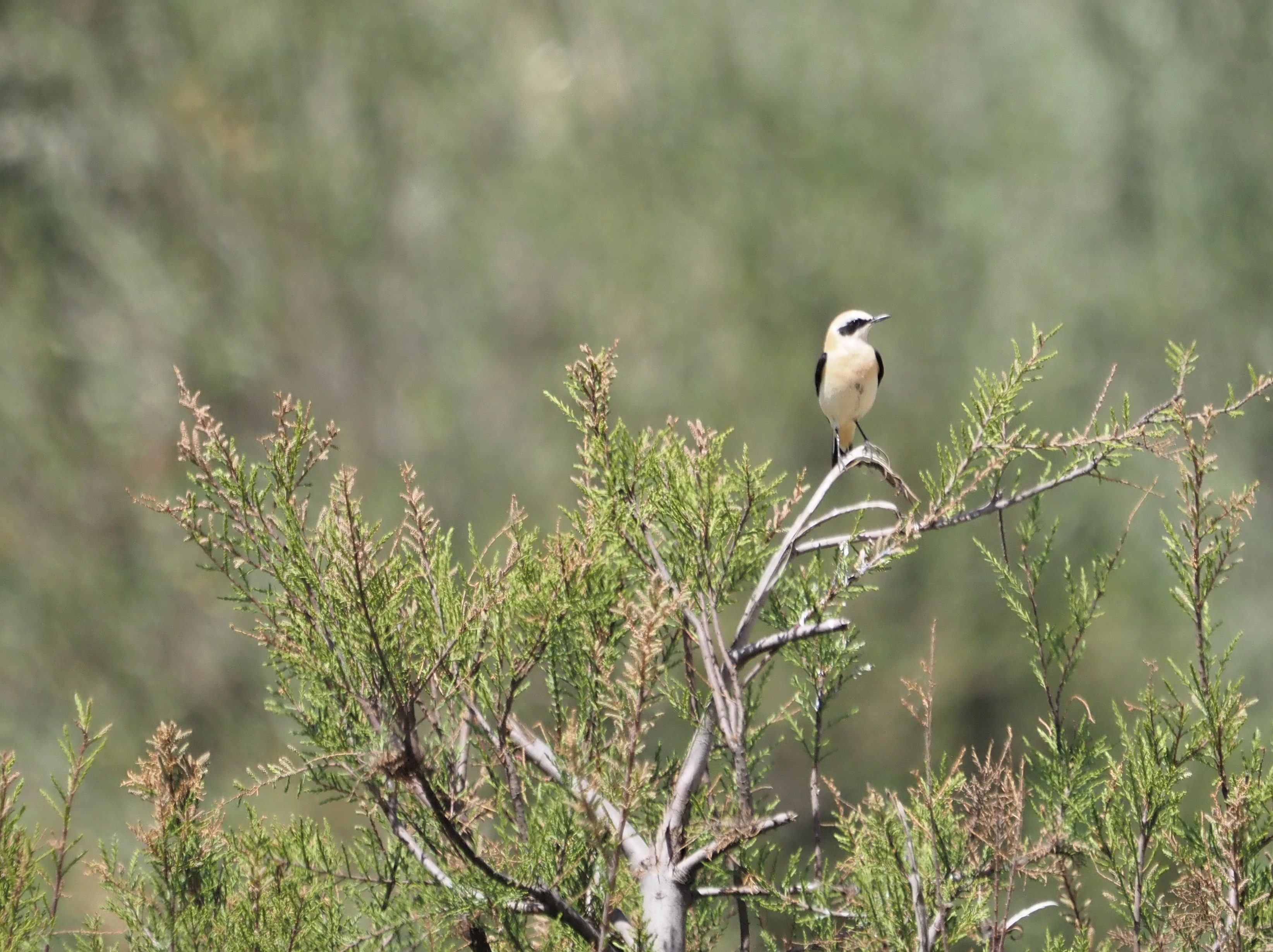
List of birds during the tour:
- Barbary Partridge (Alectoris barbara)
- Common Quail (Coturnix coturnix) – heard only
- Helmeted Guineafowl (Numida meleagris)
- Ruddy Shelduck (Tadorna ferruginea)
- Common Shelduck (Tadorna tadorna)
- Northern Shoveler (Spatula clypeata)
- Gadwall (Mareca strepera)
- Mallard (Anas platythynchos)
- Eurasian Teal (Anas crecca)
- Marbled Teal (Marmaronetta angustirostris)
- Egyptian Nightjar (Caprimulgus aegyptius)
- Little Swift (Apus affinis)
- Common Swift (Apus apus)
- Pallid Swift (Apus pallidus)
- Common Cuckoo (Cuculus canorus) -heard only
- Black-bellied Sandgrouse (Pterocles orientalis)
- Crowned Sandgrouse (Pterocles coronatus)
- Spotted Sandgrouse (Pterocles senegallus)
- Feral Pigeon (Columba livia sp)
- Common Woodpigeon (Columba palumbus)
- European Turtle Dove (Streptopelia turtur)
- Laughing Dove (Streptopelia senegalensis)
- Eurasian Collared Dove (Streptopelia decaocto)
- Eurasian Moorhen (Gallinula chloropus)
- Euriasian Coot (Fulica atra)
- Great Crested Grebe (Podiceps cristatus)
- Little Grebe (Tachybaptus ruficollis)
- Greater Flamingo (Phoenicopterus roseus)
- Eurasian Oystercatcher (Haematopus ostralegus)
- Pied Avocet (Recurvirostra avosetta)
- Black-winged Stilt (Himantopus himantopus)
- Stone Curlew (Burhinus oedicnemus)
- Cream-coloured Courser (Cursorior cursor)
- Common Ringed Plover (Charadrius hiaticula)
- Little Ringed Plover (Charadrius dubius)
- Kentish Plover (Charadrius alexandrinus)
- Grey Plover (Pluvialis squatarola)
- Red Knot (Calidris canutus)
- Dunlin (Calidris alpina)
- Bar-tailed Godwit (Limosa lapponica)
- Black-tailed Godwit (Limosa limosa)
- Eurasian Curlew (Numenius arquata)
- Eurasian Whimbrel (Numenius phaeopus)
- Common Redshank (Tringa totanus)
- Spotted Redshank (Tringa erythropus)
- Greenshank (Tringa nebularia)
- Wood Sandpiper (Tringa glareola)
- Green Sandpiper (Tringa ochropus)
- Common Sandpiper (Actitis hypoleucos)
- Ruff (Philomachus pugnax)
- Black-headed Gull (Chroicocephalus ridibundus)
- Audouin’s Gull (Ichtyaetus audouinii)
- Yellow-legged Gull (Larus michahellis)
- Lesser Black-backed Gull (Larus fuscus)
- Mediterranean Gull (Larus melanocephalus)
- Common Tern (Sterna hirundo)
- Sandwich’s Tern (Thalasseus sandvicensis)
- Gull-billed Tern (Gelochelidon nilotica)
- Arctic Skua (Stercorarius parasiticus)
- Pomarine Skua (Stercorarius pomarinus)
- Great Skua (Stercorarius skua)
- Atlantic Puffin (Fratercula arctica)
- Razorbill (Alca torda)
- Cory’s Shearwater (Calonectris borealis)
- Manx Shearwater (Puffinus puffinus)
- Balearic Shearwater (Puffinus mauretanicus)
- White Stork (Ciconia ciconia)
- Black Stork (Ciconia nigra)
- Atlantic Gannet (Morus bassanus)
- Great Cormorant (Phalacrocorax carbo)
- Black-crowned Night Heron (Nycticorax nycticorax)
- Western Cattle Egret (Bubulcus ibis)
- Little Egret (Egretta garzetta)
- Grey Heron (Ardea cinerea)
- Purple Heron (Ardea purpurea)
- Glossy Ibis (Plegadis falcinellus)
- Northern Bald Ibis (Geronticus eremita)
- Eurasian Spoonbill (Platalea leucorodia)
- Osprey (Pandion haliaetos)
- Egyptian Vulture (Neophron percnopterus)
- Short-toed Snake Eagle (Circaetus gallicus)
- Booted Eagle (Aquila pennata)
- Black Kite (Milvus migrans)
- Montagu’s Harrier (Circus pygargus)
- Western Marsh Harrier (Circus aeruginosus)
- Eurasian Sparrowhawk (Accipiter nisus)
- Atlas/North African Buzzard (Buteo buteo cirtensis)
- Black-winged Kite (Elanus caeruleus)
- Pharaon Eagle Owl (Bubo ascalaphus)
- Maghreb Owl (Strix mauritanica)
- Little Owl (Athene noctua)
- Eurasian Scops Owl (Otus scops) – heard only
- Eurasian Hoopoe (Upupa epops)
- Blue-checkeed Bee-eater (Merops persicus)
- European Bee-eater (Merops apiaster)
- Common Kingfisher (Alcedo atthis)
- Great Spotted Woodpecker (Dendrocopos major)
- Levaillant’s Green Woodpecker (Picus vaillantii)
- Eurasian Wryneck (Jynx torquilla)
- Greater Short-toed Lark (Calandrella brachydactyla)
- Mediterranean Short-toed Lark (Alaudala rufescens)
- Crested Lark (Galerida cristata)
- Maghreb Lark (Galerida macrorrhyncha)
- Thekla Lark (Galerida theklae)
- Desert Lark (Ammomanes deserti)
- Bar-tailed Lark (Ammomanes cinctura)
- Atlas Shore Lark (Eremophila alpestris atlas)
- Temmick’s Lark (Eremophila bilopha)
- Thick-billed Lark (Rhamphocoris clotbei)
- Dupont’s Lark (Chersophilus duponti)
- Greater Hoopoe Lark (Alaemon alaudipes)
- Eurasian Crag Martin (Ptyonoprogne rupestris)
- Sand Martin (Riparia riparia)
- Brown-throated Martin (Riparia paludicola)
- Barn Swallow (Hirundo rustica)
- Red-rumped Swallow (Cecropis daurica)
- Western House Martin (Delichon urbicum)
- Tree Pipit (Anthus trivialis)
- Meadow Pipit (Anthus pratensis)
- Tawny Pipit (Anthus campestris)
- White Wagtail (Motacilla alba)
- Moroccan Wagtail (Motacilla subpersonata)
- Grey Wagtail (Motacilla cinerea)
- Western Yellow Wagtail (Motacilla flava)
- White-throated Dipper (Cinclus cinclus)
- Eurasian Robin (Erithacus rubecula)
- Common Nightingale (Luscinia megarhynchos)
- Bluethroat (Luscinia svecica)
- Common Redstart (Phoenicurus phoenicurus)
- Black Redstart (Phoenicurus ochruros)
- Moussier’s Redstart (Phoenicurus moussieri)
- Northern Wheatear (Oenanthe oenanthe)
- Seebohm’s Wheatear (Oenanthe seebohmi)
- Western Black-eared Wheatear (Oenanthe hispanica)
- Maghreb Wheatear (Oenanthe halophila)
- Black Wheatear (Oenanthe leucura)
- White-crowned Black Wheatear (Oenanthe leucopyga)
- Desert Wheatear (Oenanthe deserti)
- Red-rumped Wheatear (Oenanthe moesta)
- European Stonechat (Saxicola rubicola)
- Song Thrush (Turdus philomelos)
- Mistle Thrush (Turdus viscivorus)
- European Blackbird (Turdus merula)
- Blue Rock Thrush (Monticola solitarius)
- Saharan Scrub Warbler (Scotocerca inquieta saharae)
- Eurasian Blackcap (Sylvia atricapilla)
- Garden Warbler (Sylvia borin)
- Common Whitethroat (Curruca communis)
- Western Orphean Warbler (Curruca hortensis)
- Sardinian Warbler (Curruca melanocephala)
- Spectacled Warbler (Curruca conspicillata)
- Western Subalpine Warbler (Curruca inornata)
- Tristam’s Warbler (Curruca deserticola)
- African Desert Warbler (Curruca deserti)
- Eurasian Reed Warbler (Acrocephalus scirpaceus)
- Sedge Warbler (Acrocephalus schoenibaenus)
- Zitting Cisticola (Cisticola juncidis)
- Cetti’s Warbler (Cettia cetti)
- Melodious Warbler (Hyppolais polyglotta)
- Isabelline / Western Olivaceous Warbler (Iduna opaca)
- Eastern Olivaceous Warbler (Iduna pallida reiseri)
- Common Chiffchaff (Phylloscopus collybita)
- Iberian Chiffchaff (Phylloscopus ibericus)
- Willow Warbler (Phylloscopus trochilus)
- Western Bonelli’s Warbler (Phylloscopus bonellis)
- Firecrest (Regulus ignicapillus)
- Eurasian Wren (Troglodytes troglodytes) – heard only
- African Blue Tit (Cyanistes teneriffae)
- Great Tit (Parus major)
- Coal Tit (Periparus ater atlas)
- Short-toed Treecreeper (Certhia brachydactyla mauritanica)
- Great Grey Shrike (Lanius excubitor) algeriensis & elegans races
- Woodchat Shrike (Lanius senator)
- Black-crowned Tchagra (Tchagra senegalensis)
- Common Bulbul (Pycnonotus barbatus)
- Fulvous Babbler (Turdoides fulva)
- African Magpie (Pica mauretanica)
- Common Raven (Corvus corax)
- Brown-necked Raven (Corvus ruficollis)
- Spotless Starling (Sturnus unicolor)
- House Sparrow (Passer domesticus)
- Spanish Sparrow (Passer hispanoliensis)
- Desert Sparrow (Passer simplex)
- Common Rock Sparrow (Petronia petronia)
- African Chaffinch (Fringilla coelebs africana)
- European Serin (Serinus serinus)
- Eurasian Greenfinch (Chloris chloris)
- Eurasian Goldfinch (Carduelis carduelis)
- Eurasian Siskin (Spinus spinus) – heard only
- Common Linnet (Liniaria cannabina)
- Trumpeter Finch (Bucanetes githagineus)
- African Crimson-winged Finch (Rhodopechys alienus)
- Cirl Bunting (Emberiza cirlus)
- Rock Bunting (Emberiza cia)
- House Bunting (Emberiza sahari)
- Corn Bunting (Emberiza calandra)


